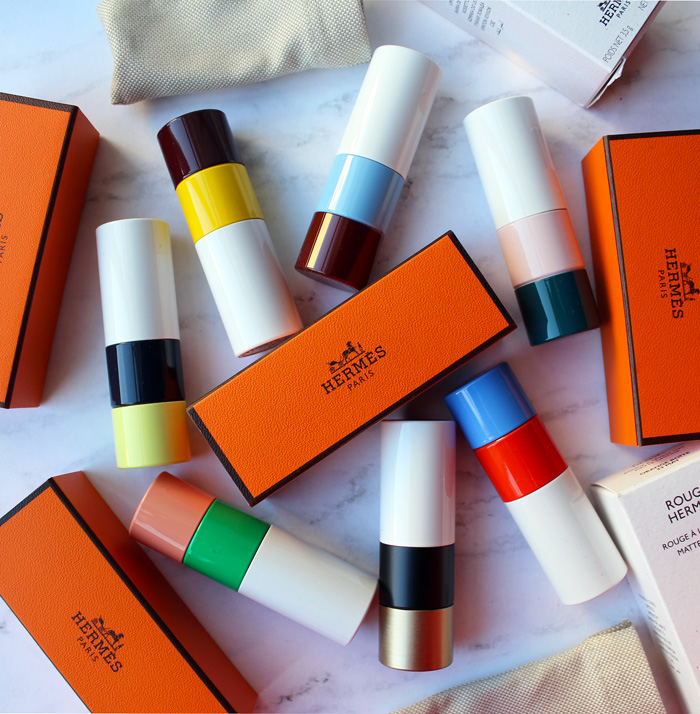
Here's a bit of luxury to start off your week! (Yes, I backdated this post.) Hermès, historic French purveyor of fine leather goods and other accessories since 1837, debuted a lipstick line back in March. Once I saw the modern color-blocked tubes I knew some of them had to make their way into the Museum's collection, so I picked up a few of the limited-edition ones and one from the permanent line. I'm not going to spend any time discussing the merits of the Birkin bag vs. the Kelly or anything else related to Hermès fashion and history, as there are any number of resources out there. Instead, I'll talk about the house of Hermès in passing only as it relates to the lipstick.
I love the canvas pouch and signature orange box each are housed in. The tubes were created by Pierre Hardy, creative director of Hermès jewelry and shoes.
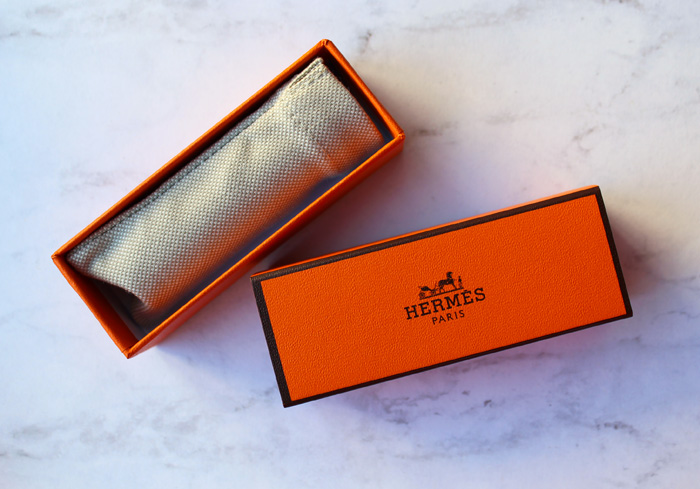
The caps are engraved with the ex-libris emblem chosen by Émile Maurice Hermès for his personal library in 1923. "The top curves inward a bit like a fingerprint, giving it a little softness…an anticipation of the gesture to come," Hardy explains to Wallpaper magazine.
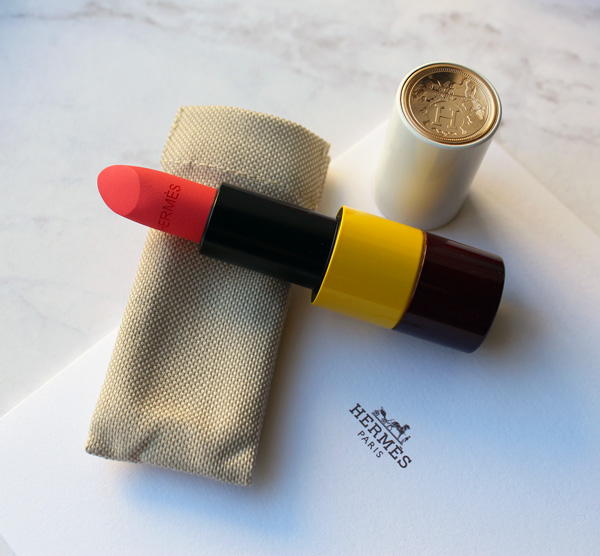
I adore the color combinations and the material is equally impressive. Though the tubes may resemble some sort of plastic, they are entirely free of it and are also refillable. The brushed metal on the tubes used for the permanent shades is a nod to Hermes's "perma-brass" fixtures on their bags. I'll let Wallpaper expand on the design: "Each lipstick tube is made of 15 different elements by partner workshops in France and Italy. Refillable, they are meant to be kept as precious objects, like jewels. The modern graphic design of the tubes contrasts with the classic ex-libris on the cap. The top half of the tube is white, or what Hardy calls 'the image of purity and simplicity'. Hardy will play around more freely with the colour blocks of these tubes, finding ‘harmonies’ with each individual shade. For the first edition, an intense purple lipstick comes in a tube with bands of red and cornflower blue, while a coral shade is offset by emerald green. The overall effect is very Memphis Group…Prior to this, Hardy had no experience with beauty products, and neither, really, did Hermès. He says there were advantages in approaching the design with a blank slate. ‘I thought, let’s act as though nothing else existed. I will try to create the quintessence of an object that is feminine, pure, simple. One that is immediately desirable but will stand the test of time, and that can convey the Hermès style: luxury and sobriety.'"
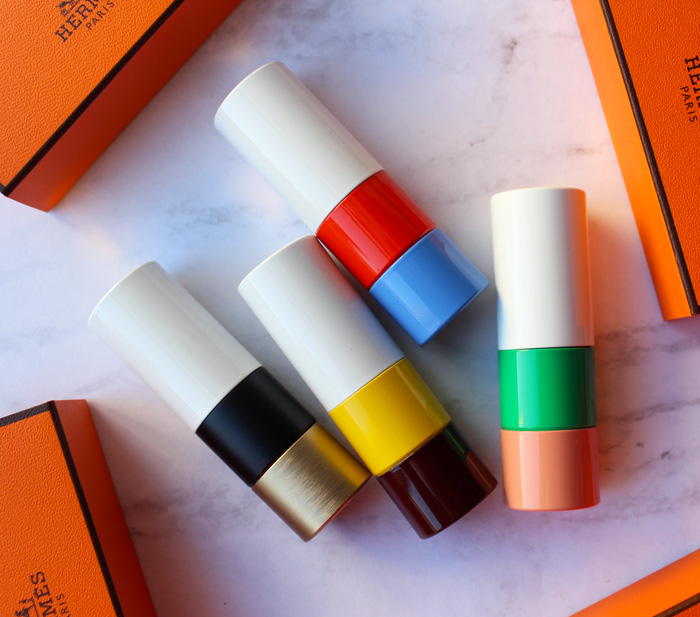
A couple of points here: first, the very old idea of makeup containers as jewelry or art objects is obviously still going strong in 21st century. Second, I had to google the Memphis Group (they're a design collective from the '80s, FYI) but the resemblance in terms of color-blocking is striking.
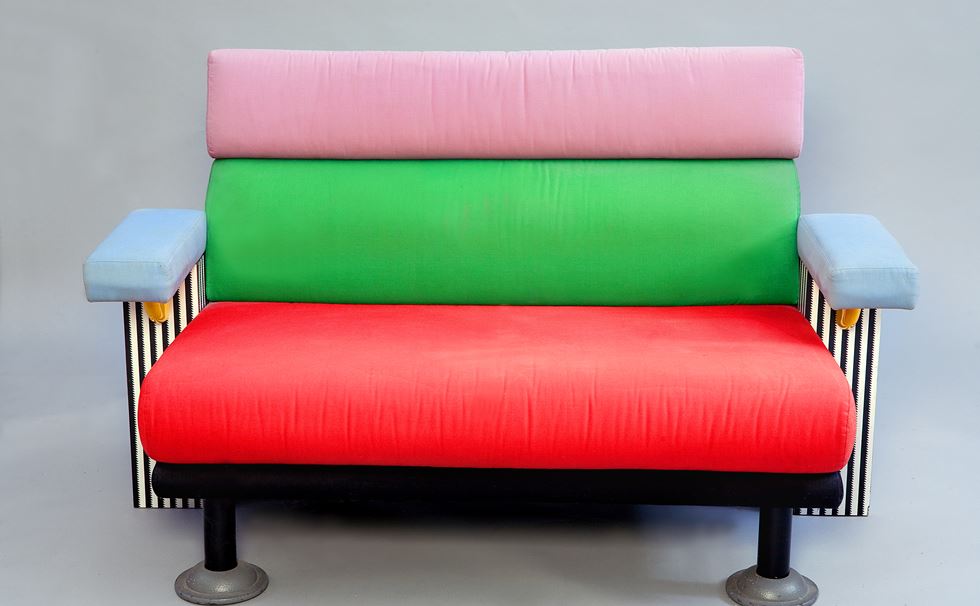
(image from designmuseum.org)
Third, the article says that Hardy had not designed makeup before. This is not exactly true, as he collaborated with NARS on a collection back in 2013. Do you remember the adorable little shoe duster bags for the nail polish duos? I'm almost positive this charming design touch was Hardy's idea.
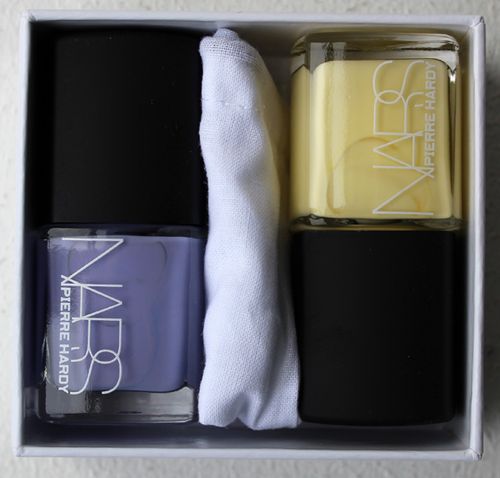
In addition to makeup as jewelry, Hardy brings up another age-old idea: makeup as art, specifically painting. Regarding the lip pencil and brush he designed for Hermès in addition to the tubes, he remarks, "I studied visual arts, and these materials – brushes, pencils – resemble what we used back then. It is interesting to approach the question of femininity like a painter: what can we offer a woman so she can be an artist of her own beauty?"
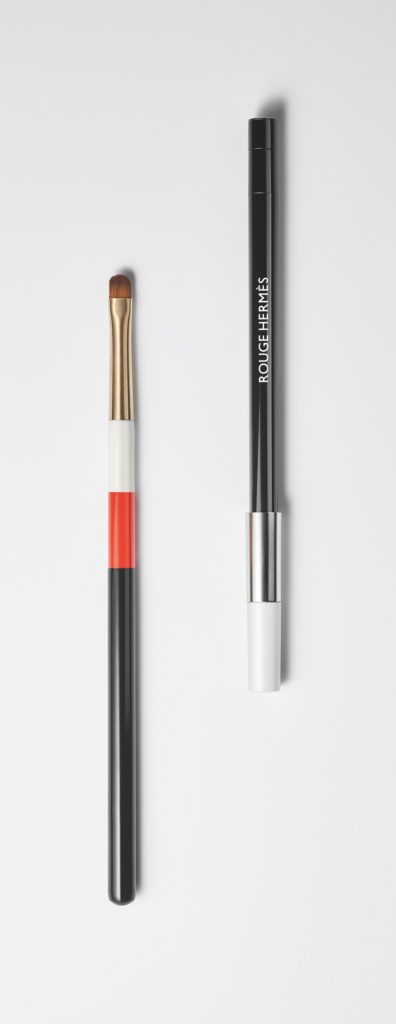
(image from lifestyleasia.com)
Now let's talk about the lipsticks themselves. Jérôme Touron, formerly of Dior and Chanel, was hired as the creative director of Rouge Hermès specifically to oversee the shade selection and textures. Each of the 24 colors (the number based on the house's address at 24 Rue du Faubourg Saint Honoré) is inspired by the roughly 900 leather colors and over 75,000 silk swatches from the company's archives. While it was difficult to narrow down the initial lineup, Touron enjoyed the "pure freedom" of digging through the archives. "It’s like a carré [square]; there is a profusion, an infinity of possibilities, and at the same time, a frame, that is clear and precise. Make-up works exactly the same way; there is an infinity of options in terms of colours, textures and types of application and at the same time it has to meet a certain function." The matte Orange Boîte, shown below, is a direct reference to Hermès's orange boxes, while Rouge H is from a color released in 1925 that I may have to buy. As Touron explains, "[Emile] introduced at the International Exhibition of Modern Decorative and Industrial Arts in Paris, with a truly pioneering spirit: he was the first to ask his tanners to create an exclusive 'signature' shade for leather. This colour immediately became a signature colour for Hermès because of its unique and singular hue: different (darker) from the Art Deco bright red of the time."
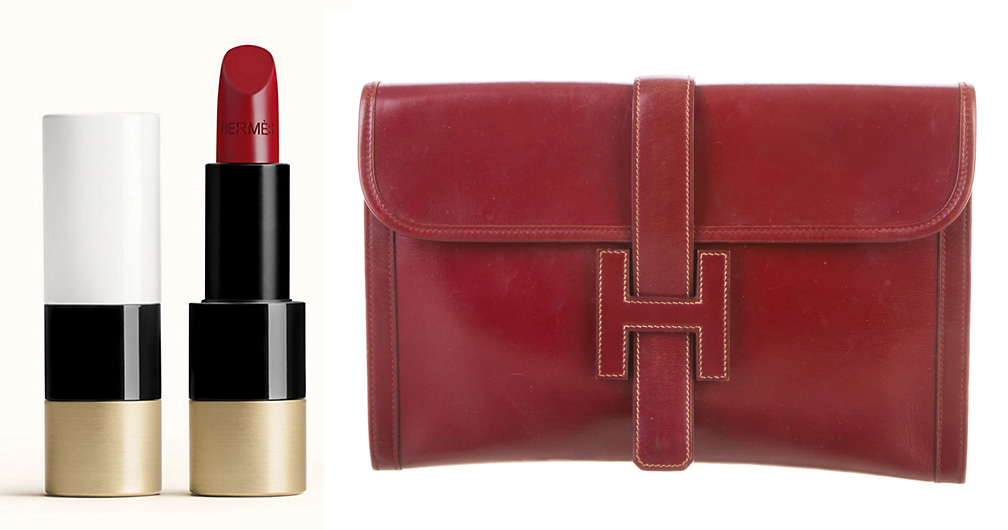 (images from hermes and therealreal.com)
(images from hermes and therealreal.com)
The lipsticks are allegedly scented with a custom fragrance concocted by the brand's perfumer Christine Nagel with notes of sandalwood, arnica and angelica, but I couldn't detect any scent. (Hopefully I'm not developing COVID.) There are 10 with matte finishes and 14 with satin, representing the various finishes of leathers, Doblis suede for the mattes and calfskin for the satins. However, Elle magazine reports that the satin texture is inspired by the company's silk scarves, so who knows.
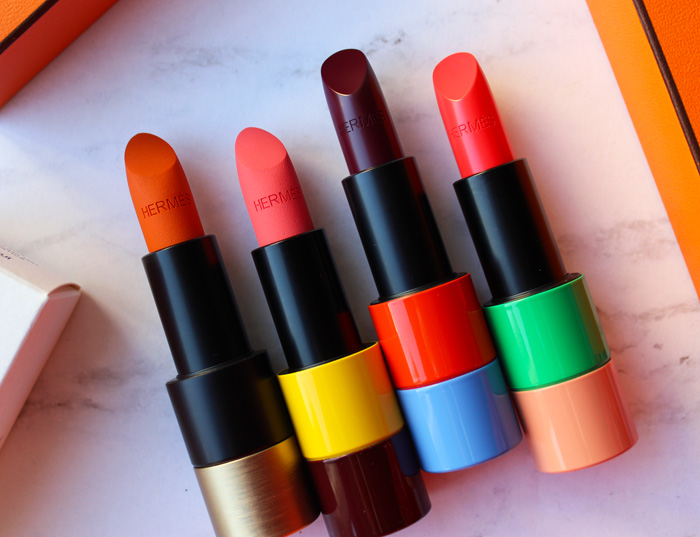
Hermès lipsticks in Orange Boite, Rose Inoui, Violet Insensé and Corail Fou
Hermès plans on releasing limited edition shades every 6 months, so I purchased the three fall 2020 colors. I really will try not to buy all three each and every season because it might not be the best use of the Museum's budget, but the color-blocking is just so irresistible (even if we have seen it on lipstick before). And as a collector there's a compulsion to have them all.
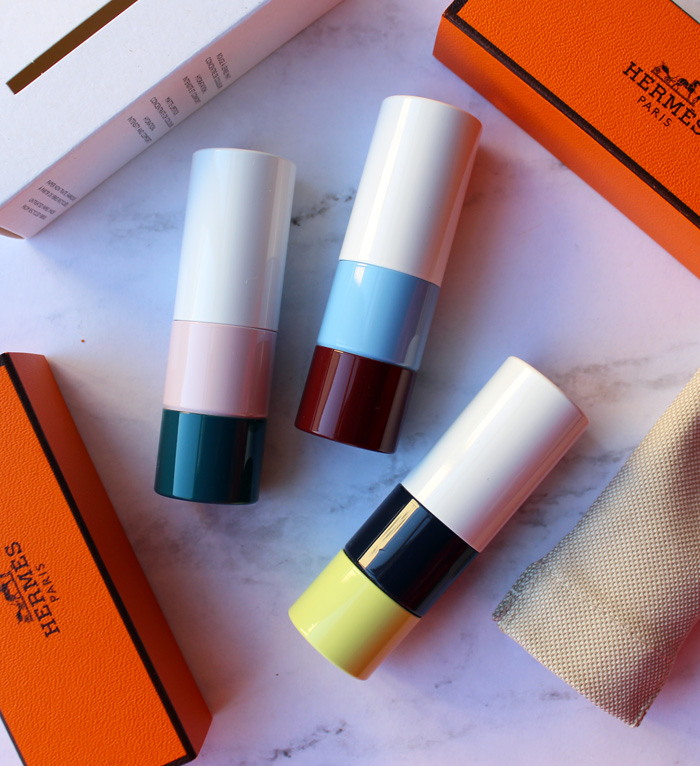
Also, all of the shades of the limited-edition lipsticks are inspired by an 1855 book Touron refers to when creating colors: The Principles of Harmony and Contrast of Colours and Their Applications to the Arts by Michel-Eugène Chevreul (that's a mouthful!)
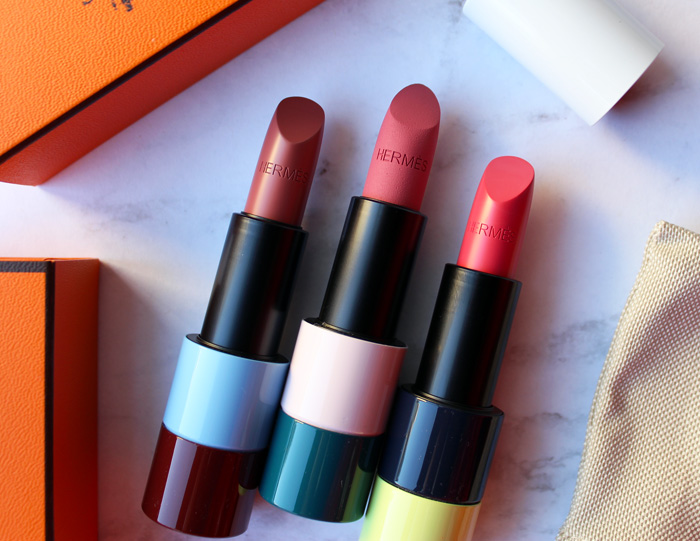
Hermès fall 2020 lipsticks in Rose Ombré, Rose Nuit and Rose Pommette
I'm still scratching my head over what exactly Touron does. I thought for sure he was a makeup artist since most lines have a makeup artist involved, but apparently he is a "product developer" according to the Wall Street Journal. The article reports that the decision not to hire a makeup artist or celebrity face was intentional. "'The idea of one makeup artist giving all the rules was not ours,' says [President and CEO of Hermès Parfums] Agnes de Villers. Touron is a product developer. He used makeup artists to help him test and develop products, but no one is signing a product group or telling anyone how to wear anything. For [artistic director Pierre Alexis] Dumas, that approach infantilizes customers. 'We've always relied on the good sense and intelligence of our clients,' he says. There will be no Hermès 'face of the season' or step-by-step inserts with line drawings. As Dumas puts it: 'Lipstick is not a status symbol, nor a sign of submission to an order, but an affirmation of the self.'" It's certainly a unique approach and only time will tell whether it pays off.
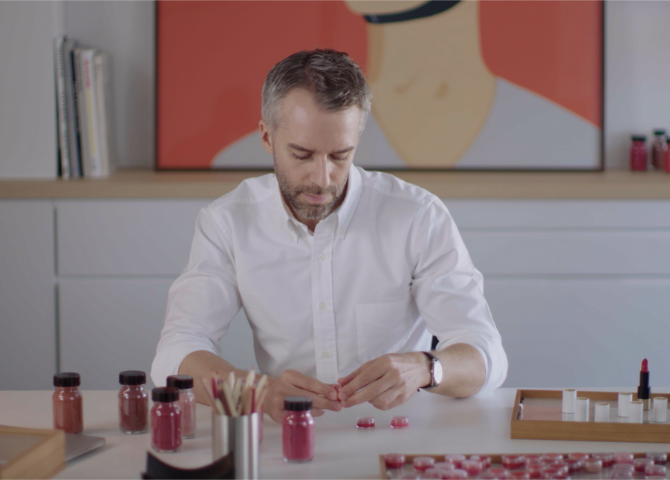 (image from buro247.me)
(image from buro247.me)
I have to say I wasn't impressed with Touron's reasoning for starting with a lipstick or its meaning. "I think the lipstick is special because it has the ability to reveal personality in a few seconds, in a single gesture, in just one application. Instantly, it reveals the colour of the personality. In a way, it exemplifies our conception of beauty: to reveal, not to transform. Hence the desire to start the Hermès Beauty with a lipstick collection. Also, perhaps because a lipstick concentrates in a very small size, our whole approach to the object, the colour, the material and the gesture in other words, some of the great fundamentals of Hermès." Eh. I wish he had been honest rather than trying to spin it into something more profound than what it is: good business sense. Nearly all major cosmetic lines start with one product and it's usually lipstick because it's the most profitable makeup item and a good way to test the waters. Lipstick is really a barometer to see how the line is received and whether there's interest in a full collection. As for the "gesture" nonsense it's really just the brand's tagline of "beauty is a gesture", and I also think makeup can absolutely be transformative, even as it's "revealing" one's true colors. I did, however, enjoy the beautiful boxed set he came up with for the holiday season and his description of the relationship between color and music. The Piano Box set contains all 24 permanent shades. "Laid out in a line with their black and white lacquering, the lipsticks looked just like piano keys…for me, colors are like musical notes; they can be combined to create harmonies and resonance. More fundamentally, color, like music, is at the same time a precise system—like a frame, and something free, artistic, and deeply emotional." That could explain why there are so many music-themed makeup objects!
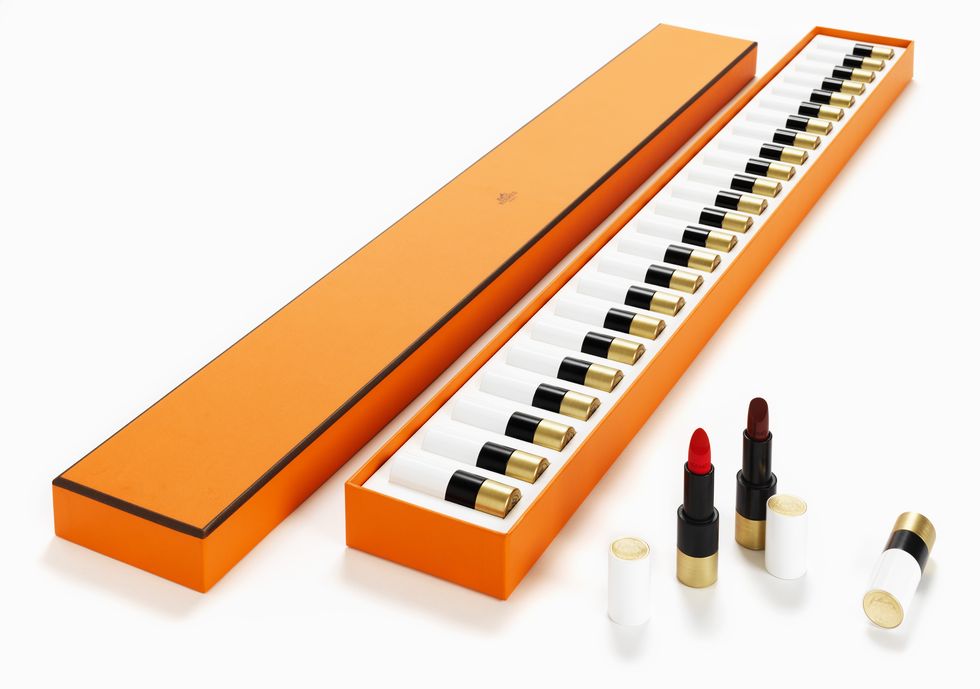
(image from elle.com)
Anyway, what's especially interesting is that nearly every article claims this is the first time Hermès released lipstick. That is not true and I have the photos to prove it. A very kind Museum supporter on Instagram sent me images of a previous lipstick by Hermès. She's not sure exactly when they came out, but according to newspaper articles it debuted in early 2001 in the U.S., selling for $25. The Wall Street Journal cited earlier reports that artistic director Pierre Alexis Dumas had suggested lipstick back in 2000 but that the company turned out not to be ready for a full line. "'I think I was the one who suggested to my father [Jean-Louis Dumas, the late chairman and creative director of the house] that we should register the name for lipstick.' They didn't do it then—instead just once making a single shade of red lipstick in limited edition. They needed to think it through some more." However, this photo shows a number on the lipstick which implies there were more shades. Perhaps in Europe, where this online friend of mine is based, offered more colors and in the U.S. we only got one.
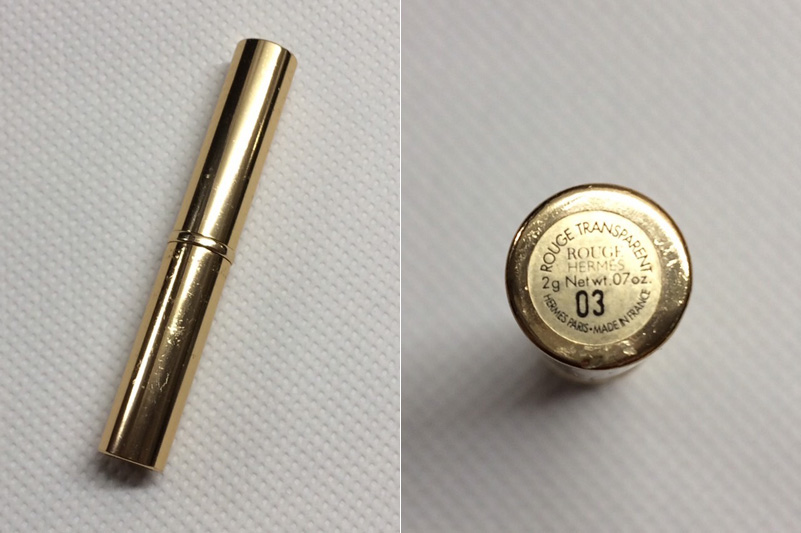
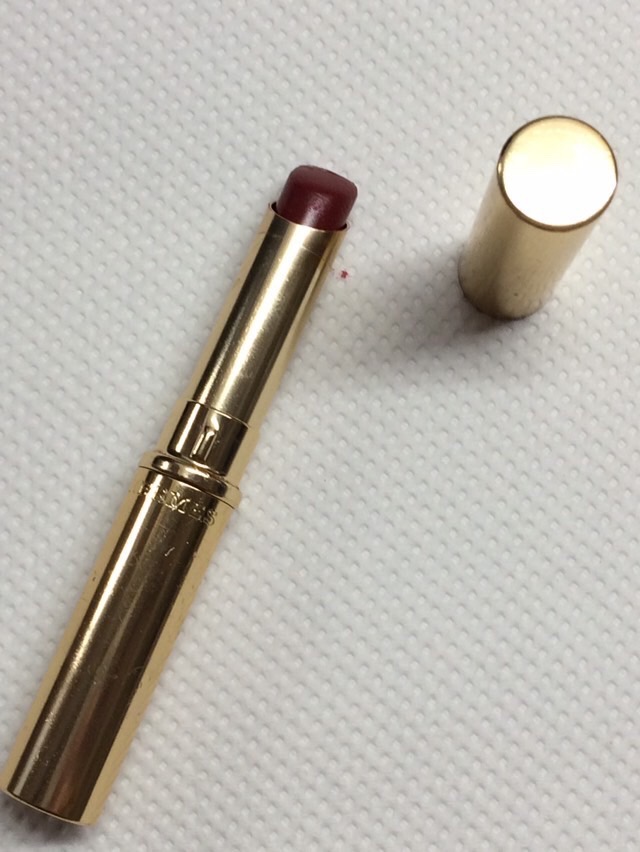
(images from @amalia.vet)
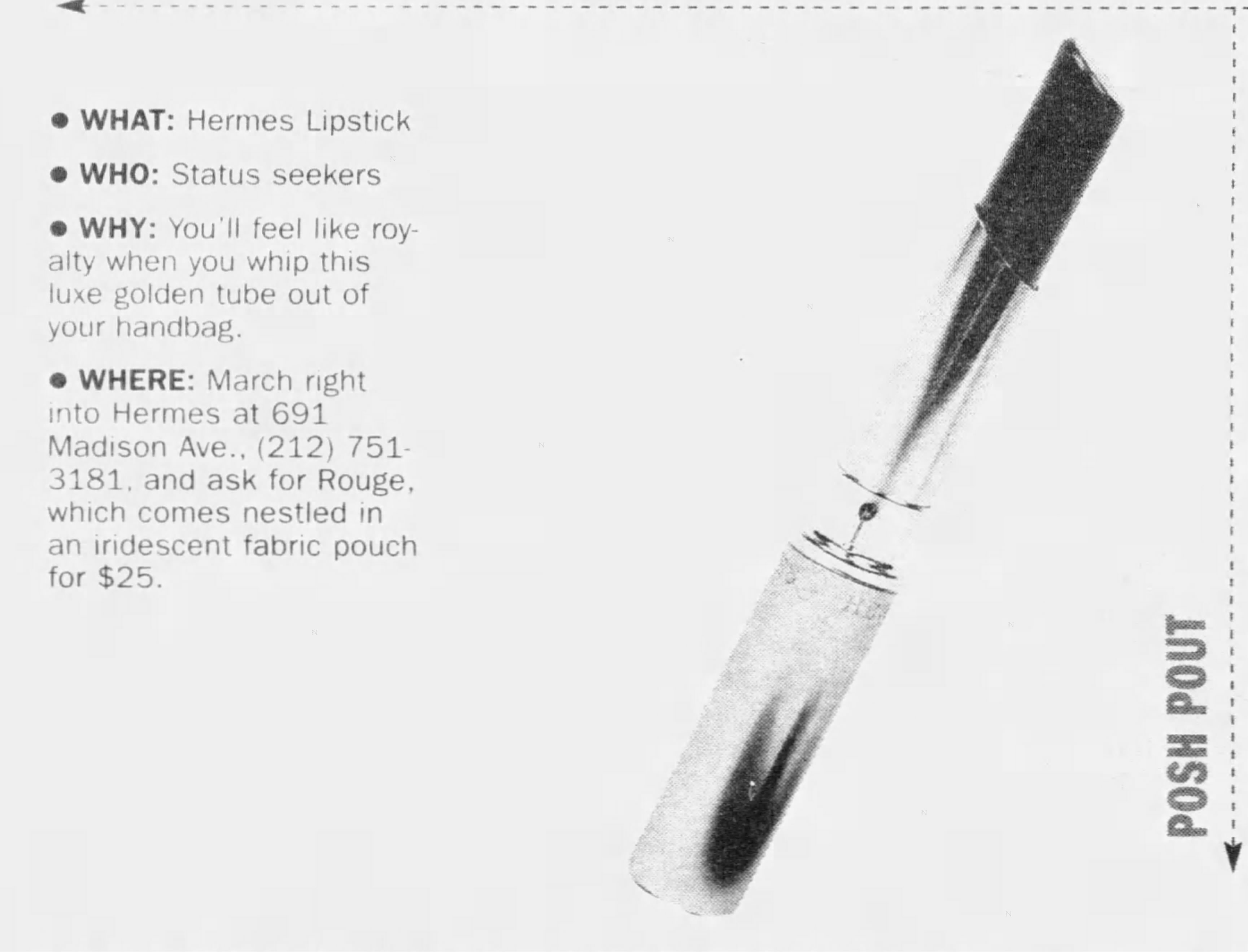
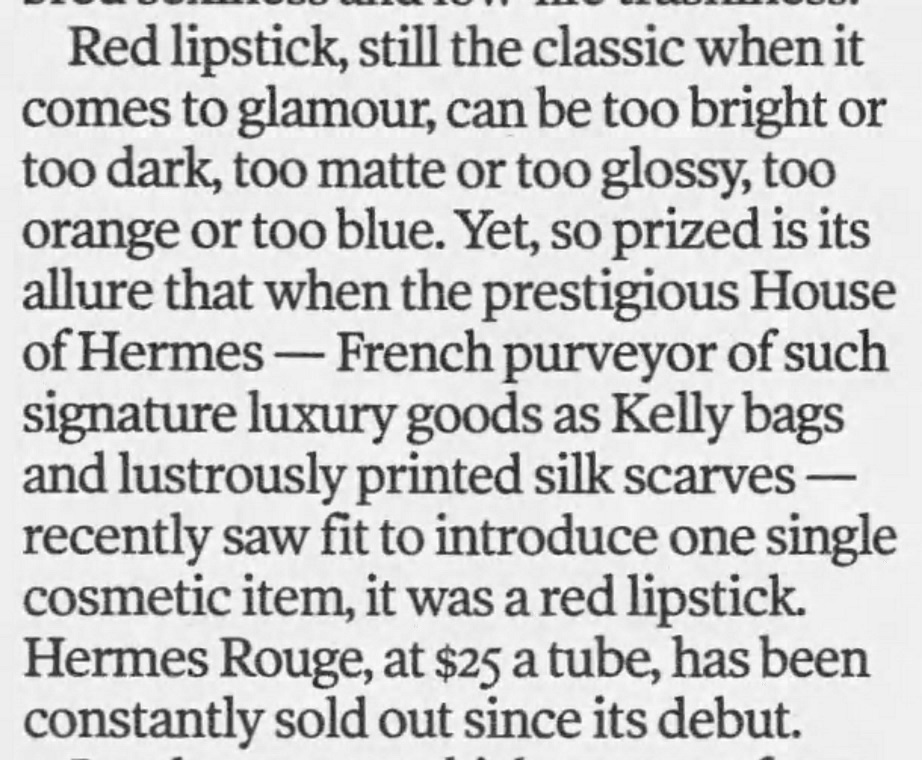
In looking at the older lipstick and comparing it to the 2020 version, I must say the new line is far superior design-wise than Hermès's previous attempt at makeup. It makes sense, since Touron, Hardy, Nagel, Dumas, along with Bali Barret, director of Hermès Women, spent 3 years bringing the cosmetics line to fruition. There wasn't nearly as much fanfare or press for the earlier release, which leads me to believe it was more of a quick money grab led primarily by their marketing department without any real thought put into it – one can tell top executives and designers were not too hands-on. I'm all for minimal style, but the slim, plain packaging reads as very uninspired and not at all distinct from other brands, nor does it really capture Hermès's vision. This could also be the reason why the line failed within a year – I saw no mention of it after March 2002 – and why nearly all the coverage for the new line omits any reference to their earlier foray into cosmetics. In hindsight, the company may see it as a mistake and prefer that it stays buried in newspaper archives…unfortunately for them, beauty aficionados don't forget!
Anyway, as with other luxury makeup, many people will want to know whether Hermès lipstick is worth shelling out a significant amount of money for. On the surface, $67-$72 is an absurd price for a single lipstick. But as I noted with Louboutin nail polish, you're not just paying for the product; you're paying for the Hermès name along with all of the thoughtful details outlined above, not to mention that they are more affordable than nearly any other Hermès item (the leather cases for the lipsticks start at $340). Having said that, there are plenty of other quality lipsticks to choose from if you're not into forking over some 70 bucks for the name or packaging. Most reviews have indicated that Hermès performs well although not necessarily better than other high-end brands, so splurging on one (or several) because of the luxurious feel makes sense. But I don't believe any of the ingredients or technology in the product by itself warrant the price tag – beeswax, shea butter and mulberry extract are not that special, after all. Bottom line: if you're wondering whether it's worth it to buy these, yes, but only if you're really into all the luxurious bells and whistles, a collector or if you love the brand. Again, if you just want a lipstick that performs well and don't care about the label, pretty orange boxes and colorful tubes, there are many comparable lipsticks out there.
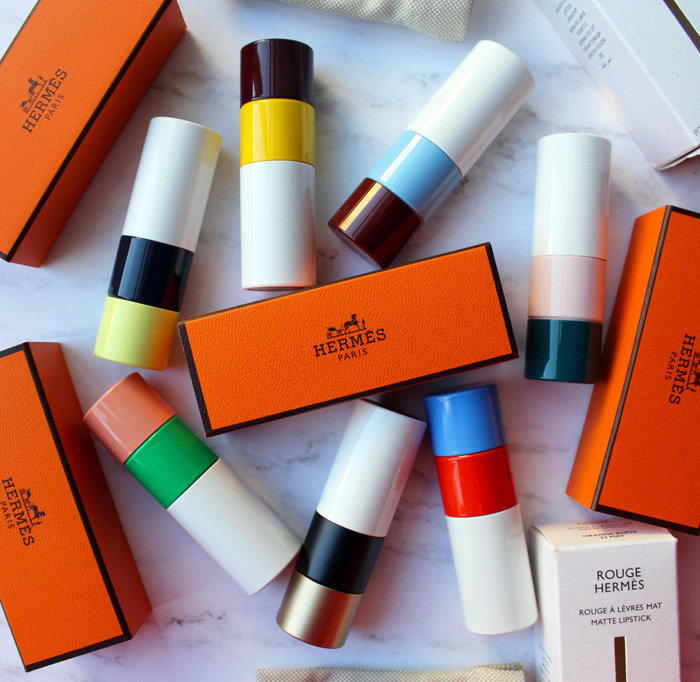
To conclude, I'm really enjoying Rouge Hermès despite the fact that I haven't swatched any of the lipsticks I purchased (although it is very tempting!) You know I admire attention to detail when it comes to makeup packaging and design, and these tick every box. I also think these tie into the company's aristocratic history but look much more approachable than I was expecting. I always perceived Hermès as a sort of blue-blood, old-money type brand – I mean, they started as a company that made fancy leather horse saddles and harnesses for people wealthy enough to consider equestrianism a hobby – but the modern and colorful design of the lipsticks proves they may not be as stuffy as I thought. Still, I'd like to see more adventurous shades and textures, i.e. their Malachite green or a glitter finish. And obviously they need more diversity in their advertising. I can't say I've seen any, ahem, mature-looking models or anyone resembling a gender besides cis women, so hopefully they'll branch out a bit while still keeping true to the brand's heritage. A full makeup line is planned to be in place by 2023, so fingers crossed we'll see some other interesting limited edition items…maybe a Birkin-embossed highlighter or one of their scarf patterns printed on the outer cases. ;)
What do you think of Rouge Hermès? Would you or have you tried them?
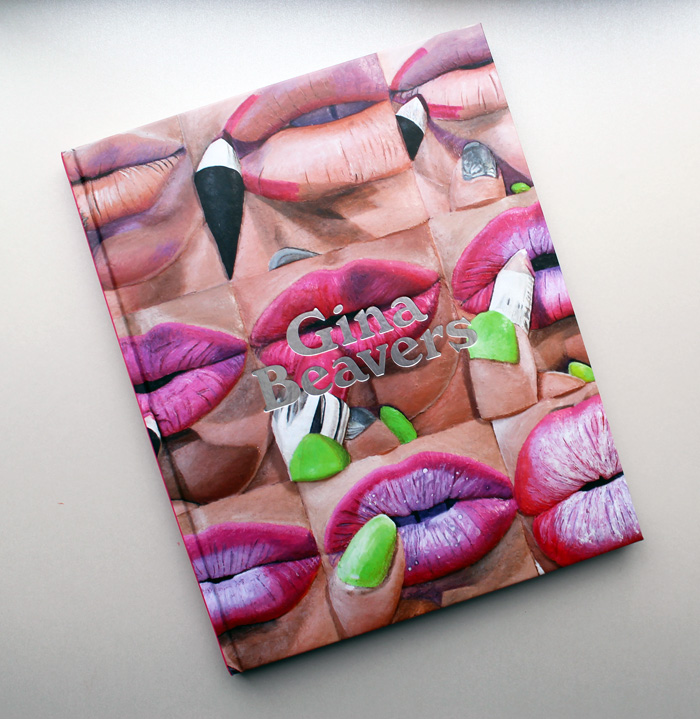
Despite my art history background and general love of art, I am less than eloquent when writing about it. Nevertheless I will continue soldiering forward with the Museum's Makeup as Muse series, the latest installment of which focuses on the work of Gina Beavers in honor of her recent show at Marianne Boesky Gallery. Beavers' practice encompasses a variety of themes, but it's her paintings of makeup tutorials that I'll be exploring. Since I'm both tired and lazy this will be more of a summary of her work rather than offering any fresh insight and I'll be quoting the artist extensively along with some writers who have covered her art, so most of this will not be my own words.
Born in Athens and raised in Europe, Beavers is fascinated by the excess and consumerism of both American culture and social media. "I don't know how to talk about this existence without talking about consumption, and so I think that's the element in consuming other people's images. That's where that's embedded. We have to start with consumption if we're going to talk about who we are. That's the bedrock—especially as an American," she says. The purchase of a smart phone in 2010 is when Beavers' work began focusing on social media. "[Pre-smart phone] I would see things in the world and paint them! Post-smartphone my attention and observation seemed to go into my phone, into looking at and participating in social media apps, and all of the things that would arise there…Historically, painters have drawn inspiration from their world, for me it's just that a lot of my world is virtual [now]."
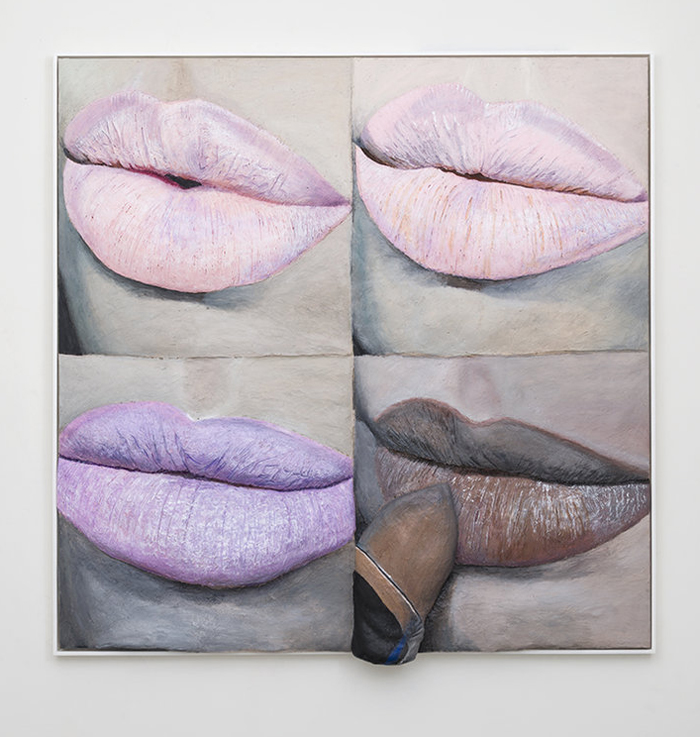
But why makeup, and specifically, makeup tutorials? There seem to be two main themes running through the artist's focus on these online instructions, the first being the relationship between painting and makeup. Beavers explains: "When I started with these paintings I was really thinking that this painting is looking at you while it is painting itself. It’s drawing and painting: it has pencils, it has brushes, and it’s trying to make itself appealing to the viewer. It’s about that parallel between a painting and what you expect from it as well as desire and attraction. It’s also interesting because the terms that makeup artists use on social media are painting terms. The way they talk about brushes or pigments sounds like painters talking shop." Makeup application as traditional painting is a theme that goes back centuries, but Beavers's work represents a fresh take on it. As Ellen Blumenstein wrote in an essay for Wall Street International: "Elements such as brushes, lipsticks or fingers, which are intended to reassure the viewers of the videos of the imitability of the make-up procedures, here allude to the active role of the painting – which does not just stare or make eyes at the viewer, but rather seems to paint itself with the accessories depicted – literally building a bridge extending out from the image…Beavers divests [the image] of its natural quality and uses painting as an analytical tool. The viewer is no longer looking at photographic tableaus composed of freeze-frames taken from make-up tutorials, but rather paintings about make-up tutorials, which present the aesthetic and formal parameters of this particular class of images, which exist exclusively on the net." The conflation of makeup and painting can also be perceived as a rumination on authorship and original sources. Beavers is remaking tutorials, but the tutorials themselves originated with individual bloggers and YouTubers. And given the viral, democratic nature of the Internet, it's nearly impossible to tell who did a particular tutorial first and whether tutorials covering the same material – say, lip art depicting Van Gogh's "Starry Night" – are direct copies of one artist's work or merely the phenomenon of many people having the same idea and sharing it online. Sometimes the online audience cannot distinguish between authentic content and advertising; Beavers's "Burger Eye" (2015), for example, is actually not recreated from a tutorial at all but an Instagram ad for Burger King (and the makeup artist who was hired to create it remains, as far as I know, uncredited).
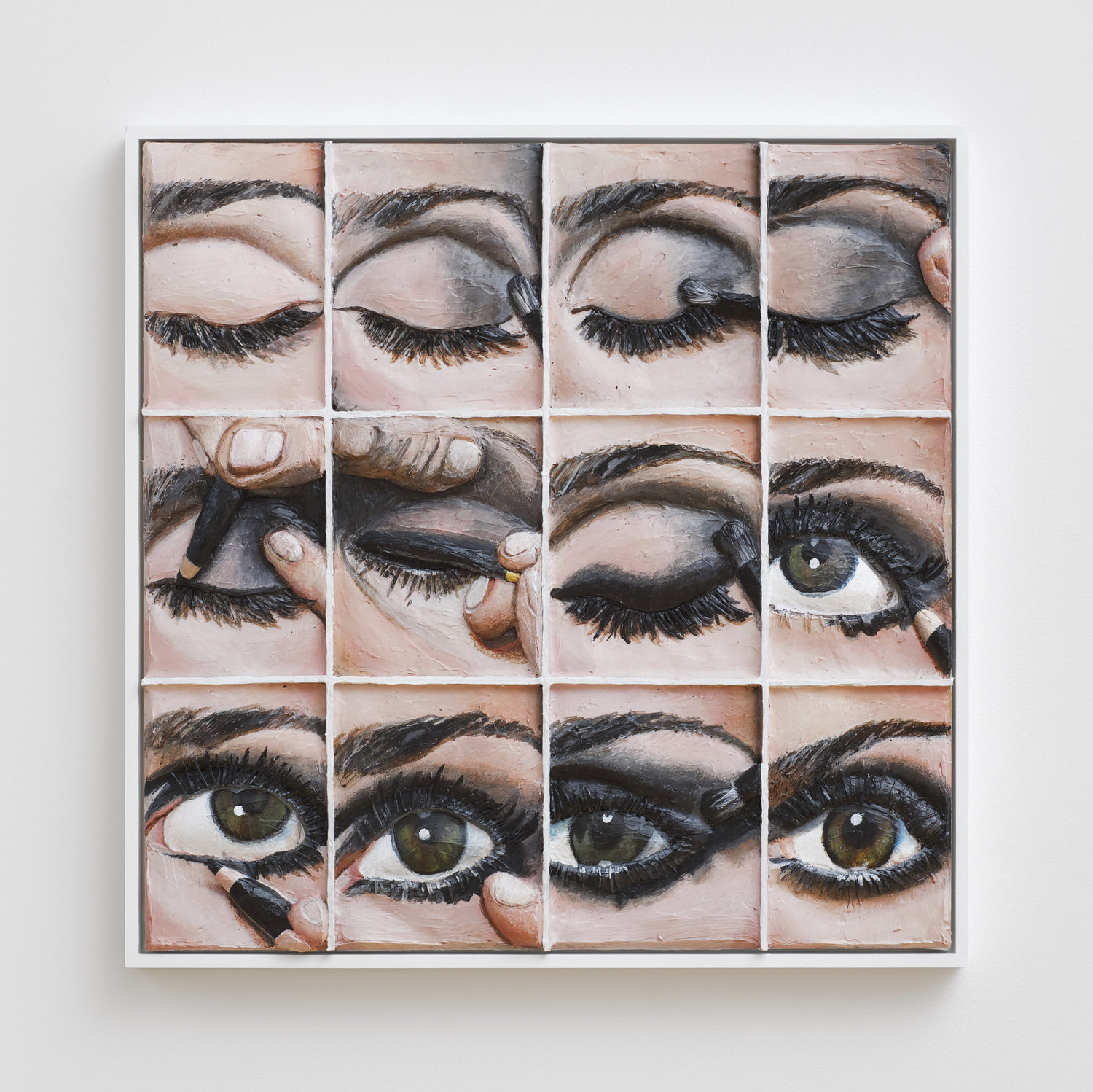
Another theme is fashioning one's self through makeup, and how that self is projected online in multiple ways. Beavers explains: "I am interested in the ways existing online is performative, and the tremendous lengths people go to in constructing their online selves. Meme-makers, face-painters, people who make their hair into sculptures, are really a frontier of a new creative world…It’s interesting, as make-up has gotten bigger and bigger, I’ve realized what an important role it plays in helping people construct a self, particularly in trans and drag communities. I don’t normally wear a lot of make-up myself, but I like the idea of the process of applying make-up standing in for the process of self-determination, the idea of ‘making yourself’."
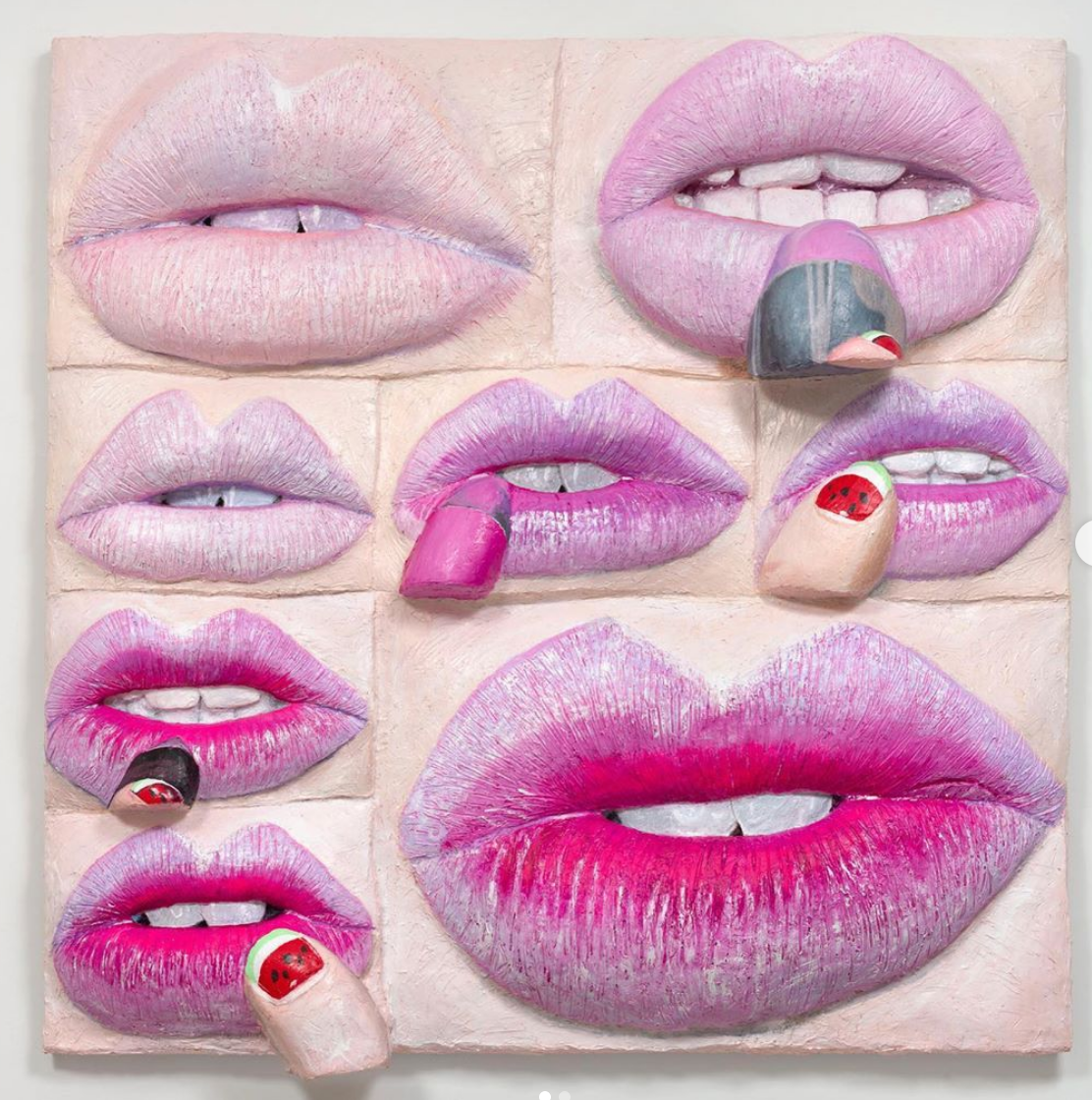
As for the artist's process, it's a laborious one. Beavers regularly combs Instagram, YouTube and other online sources and saves thousands of images on her phone. She then narrows down to a few based on both composition and the story they're trying to tell. "I'm arrested by images that have interesting formal qualities, color, composition but also a compelling narrative. I really like when an image is saying something that leaves me unsure of how it will translate to painting, like whether the meaning will change in the context of the history of painting," she says. "I always felt drawn to photos that had an interesting composition, whether for its color or depth or organization. But in order for me to want to paint it, it also had to have interesting content, like the image was communicating some reality beyond its composition that I related to in my life or that I thought spoke in some interesting way about culture." The act of painting for Beavers is physically demanding as well: she needs to start several series at the same time and go back and forth between paintings to allow the layers to dry. They have to lay flat to dry so she often ends up painting on the floor, and her recent switch to an even heavier acrylic caused a bout of carpal tunnel syndrome.
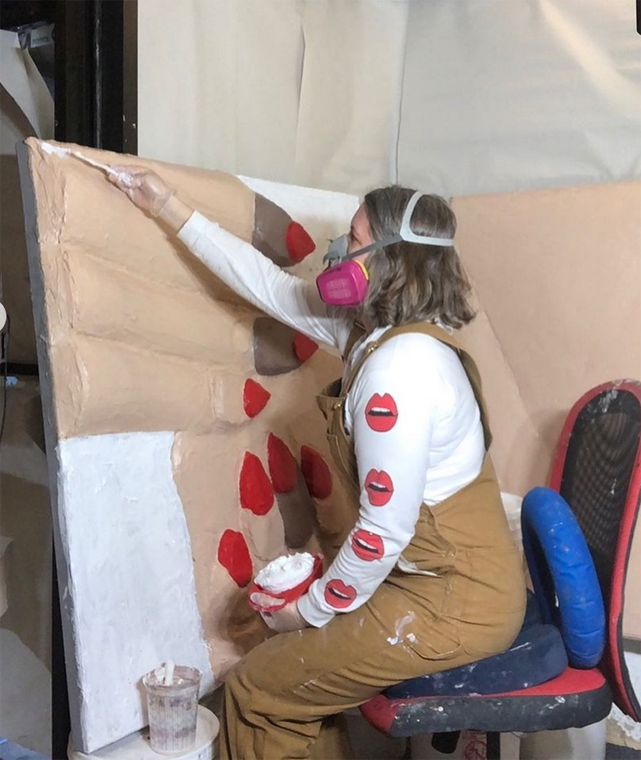
But it's precisely the thick quality of the paint that return some of the tactile nature of makeup application. This is not accidental; Beavers intentionally uses this technique as way to remind us of makeup's various textures and to ensure her paintings resemble paintings rather than a photorealistic recreation of the digital screen. "The depth of certain elements in the background of images has taught me a lot about seeing. I think I have learned that I enjoy setting up problems to solve, that it isn't enough for me to simply render a photo realistically, that I have to build up the acrylic deeply in order to interfere with the rendering of something too realistically," she explains. Sharon Mizota, writing for the LA Times, says it best: "Skin, lashes and lips are textured with rough, caked-on brushstrokes that mimic and exaggerate wrinkles and gloppy mascara. This treatment gives the subjects back some of the clunky physicality that the camera and the digital screen strip away. Beavers’ paintings, in some measure, undo the gloss of the photographic image."
Beavers also uses foam to further build up certain sections so that they bulge out towards the viewer, representing the desire to connect to others online. "Much of what people do online is to try to create connection, to reach out and meet people or talk to people. That is what the surfaces of my painting do in a really literal way, they are reaching off the linen into the viewer’s space," she says. This sculptural quality also points to the reality of the online world – it's not quite "real life" but it's not imaginary either, occupying a space in between. Beavers expands on her painting style representing the online space: "It’s interesting because flatness often comes up with screens, and I think historically the screen might have been read like that, reflecting a more passive relationship. That has changed with the advent of engagement and social media. What’s behind our screen is a whole living, breathing world, one that gives as much as it takes. I mean it is certainly as 'real' as anything else. I see the dimension as a way to reflect that world and the ways that world is reaching out to make a connection. Another aspect is that once these works are finished, they end up circulating back in the same online world and now have this heightened dimensionality – they cast their own shadow. They’re not a real person, or burger, or whatever, but they’re not a photo of it either, they’re something in between."
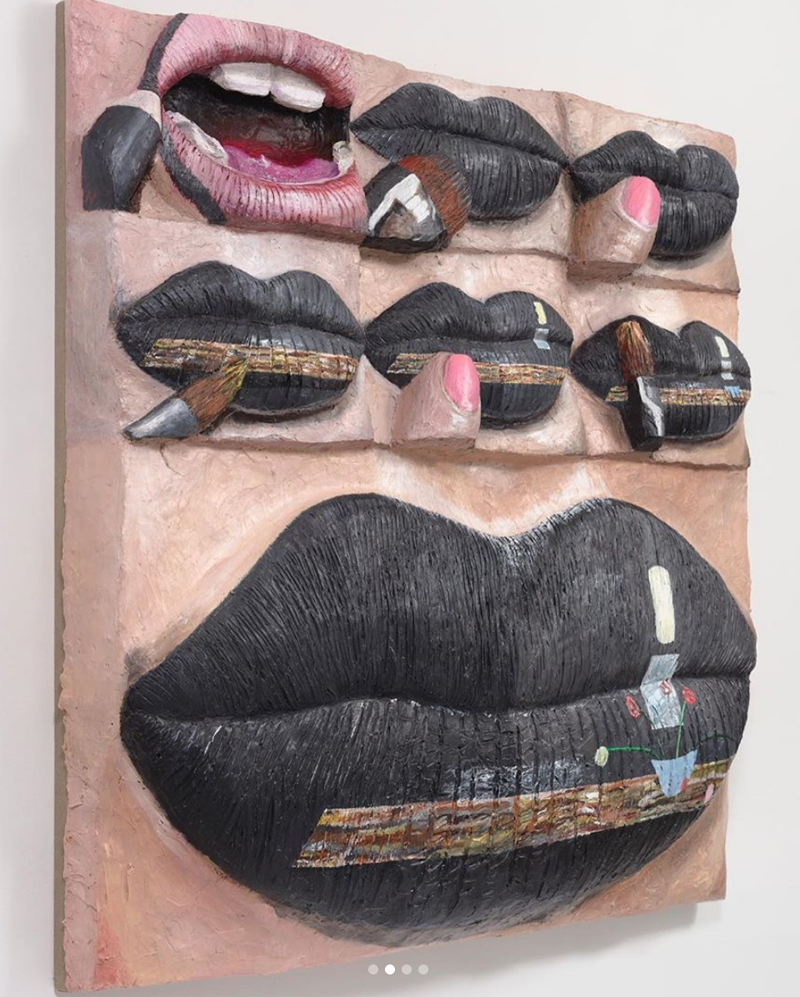
Let's dig a little more into what all this means in terms of makeup, the beauty industry and social media. Beavers' work can be viewed as a simultaneous critique and celebration of all three. Sharon Mizota again: "[The tutorial paintings] also pointedly mimic the act of putting on makeup, reminding us that it is something like sedimentation, built up layer by layer. There is no effortless glamour here, only sticky accretion. That quality itself feels like an indictment — of the beauty industry, of restrictive gender roles. But an element of playfulness and admiration lives in Beavers’ work. They speak of makeup as a site of creativity and self-transformation, and Instagram and other social media sites as democratizing forces in the spread of culture. To be sure, social media may be the spur for increasingly outré acts, which are often a form of bragging, but why shouldn’t a hamburger eye be as popular as a smoky eye? In translating these photographs into something more physical, Beavers asks us to consider these questions and exposes the duality of the makeup industry: The same business that strives to make us insecure also enables us to reinvent ourselves, not just in the image of the beautiful as it’s already defined, but in images of our own devising."
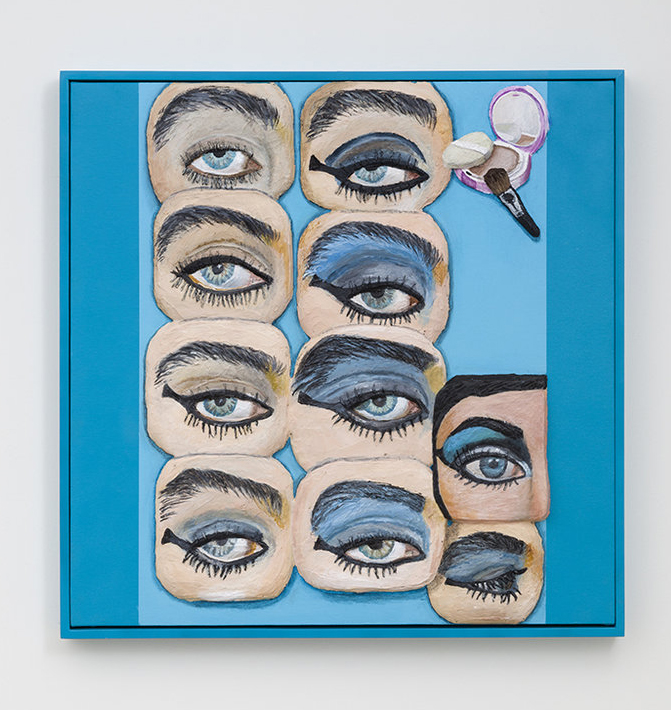
This ambiguity is particularly apparent in Beavers's 2015 exhibition, entitled Ambitchous, which incorporated beauty Instagrammers and YouTubers' makeup renditions of Disney villains alongside "good" characters. Blumenstein explains: "So it isn’t protagonists with positive connotations which are favoured by the artist, but unmistakably ambivalent characters who could undoubtedly lay claim to the neologism ambitchous, which is the name given to the exhibition. Like the original image material, this portmanteau of ‘ambitious’ and ‘bitchy’ is taken from social media and its creative vernacular, and is used, depending on the context, either in a derogatory fashion – for example for women who will do absolutely anything to get what they want – or positively re-interpreted as an expression of female self-affirmation. Beavers also applies this playful and strategic complication of seemingly unambiguous contexts of meaning to the statements contained in her paintings. It remains utterly impossible to determine whether they are critically exaggerating the conformist and consumerist beauty ideals of neo-capitalism, or ascribing emancipatory potential to the conscious and confident use of make-up."
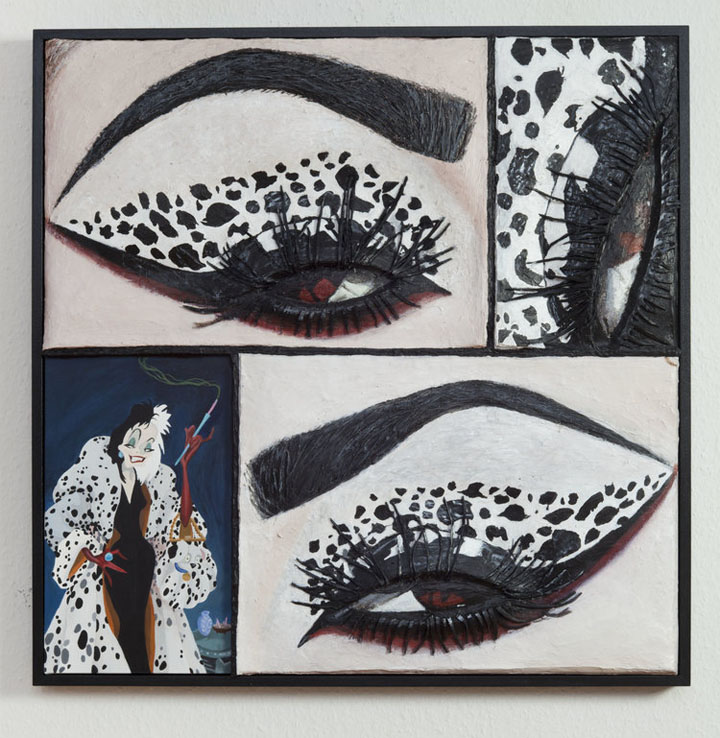
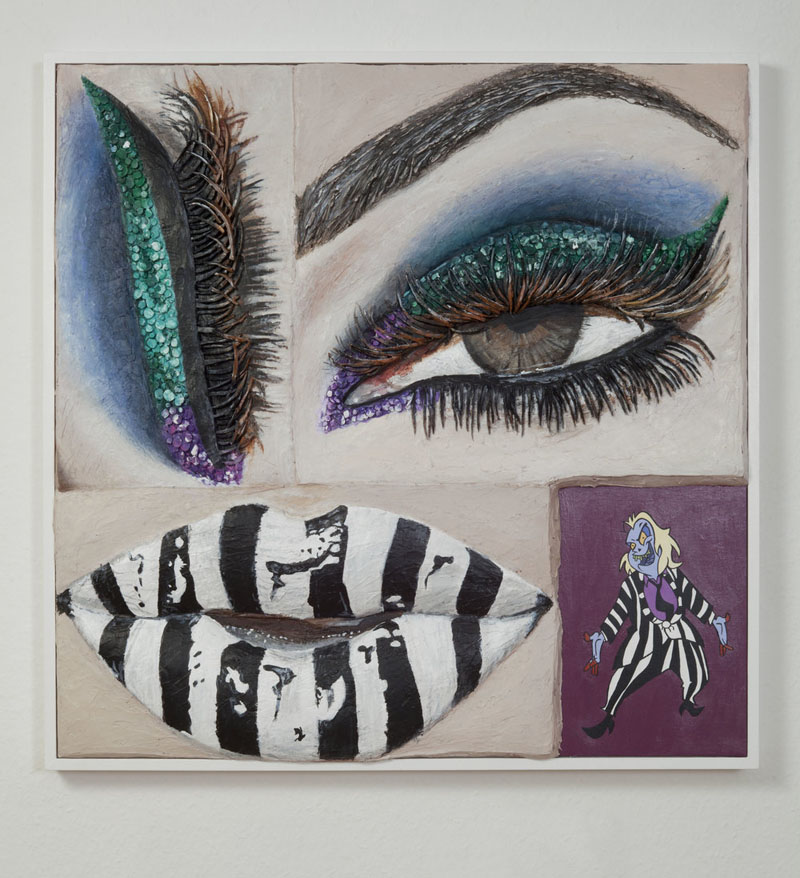
More recently, Beavers has been using her own face as a canvas and making her own photos of them her source material, furthering her exploration of the self. "Staring at yourself or your lips for hours is pretty jarring. But I like it, because it creates this whole other level of self,” she says.
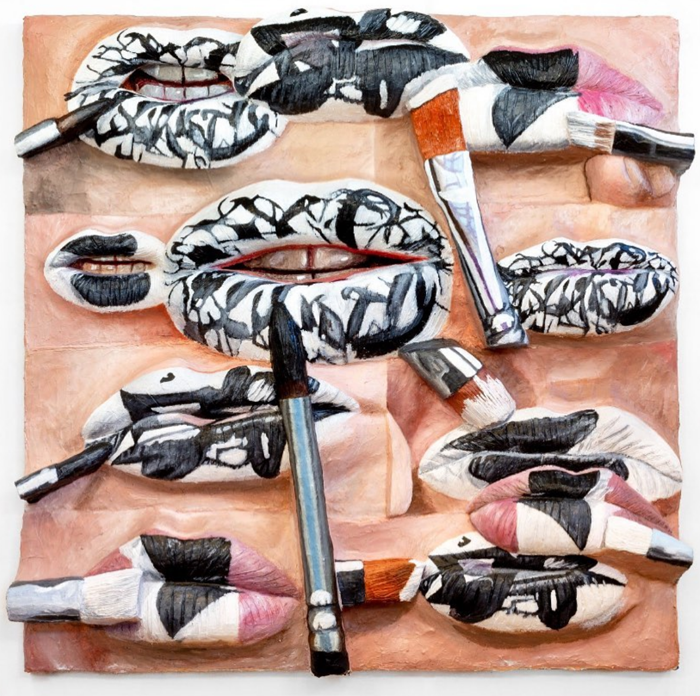
This shift also points to another dichotomy in Beavers's work: in recreating famous works of art on her face, she is both critiquing art history's traditional canon and appreciating it, referring to them as a sort of fan art. "I think a lot of the works that I have made that reference art history—like whether it's Van Gogh or whoever it is—have a duality where I really respect the artist and I'm influenced by them, and at the same time I'm making it my own and poking a little fun. And so, a lot of these pieces originated with the idea of fan art. You'll find all sorts of Starry Night images online that people have painted or sculpted or painted on their body. It comes out of that. And I just started to reach a point where I was searching things like 'Franz Kline body art,' and I wasn’t finding that, so I had to make my own. Then it started to get a little bit geekier. I have a piece in the show where I am painting a Lee Bontecou on my cheek, that's a kind of art world geeky thing—you have to really love art to get it."
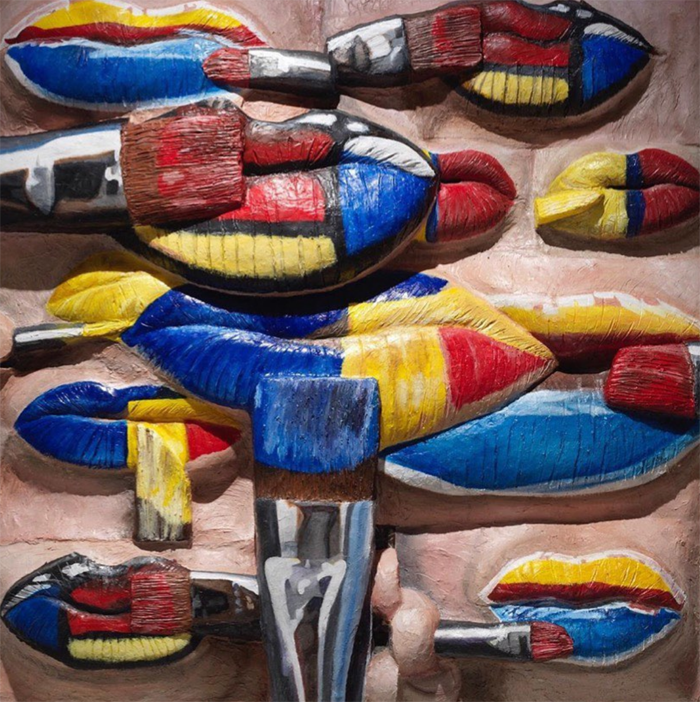
Ultimately, Beavers perceives the intersection of makeup and social media as a force for good. While the specter of misinformation is always lurking, YouTube tutorials and the like allow anyone with internet access to learn how to do a smoky eye or a flawlessly lined lip. "I think for a lot of people social media is kind of like the weather. We don't have a lot of control of it, it just is. It gives and it takes away. There's no doubt that it has connected people in ways that are great and productive, allowing people to find communities and organize activism, it can also be a huge distraction…I approach looking at images there pretty distantly, more as a neutral documentarian, and I come down on the side of seeing social media as an incredibly useful, democratic tool in a lot of ways," she concludes.
On the other side of social media, Beavers is interested on how content creators help disseminate the idea of makeup as representing something larger and more meaningful than traditional notions of beauty. "I was super fascinated with makeup and all of the kinds of costume makeup and things you can find online that go away from a traditional beauty makeup and go towards something really wild and cool…I also had certain paintings in [a 2016] show that were much more about costume makeup, that were going away from beauty. That’s the thing that gives me hope. When I go through makeup hashtags on Instagram, there will be ten or twenty beauty eye makeup images and then one that’s painted with horror makeup. There are women out there doing completely weird things, right next to alluring ones." In the pandemic age, as people's relationships with makeup are changing, "weird" makeup is actually becoming less strange. Beavers' emphasis on experimental makeup is more timely than ever. I also think she's documenting the gradual way makeup is breaking free of the gender binary. She says: "I mean with makeup, and the whole conversation around femininity and makeup—I think for a long time when I was making makeup images, there were people that just thought, 'Oh, that's not for me,' because it's about makeup, it's feminine. But it’s interesting, the culture is shifting. I just saw the other day that Alexandria Ocasio-Cortez did a whole Instagram live where she was putting on her makeup and talking about how empowering makeup is for trans communities…some people see make-up as restrictive or frivolous, but drag performers show how it can be liberating and life-saving." Another point to consider in terms of gender is the close-up aspect of Beavers's paintings. With individual features (eyes, lips, nails) separated from the rest of the face and body and removed from their original context, they're neither masculine nor feminine, thereby reiterating that makeup is for any (or no) gender.
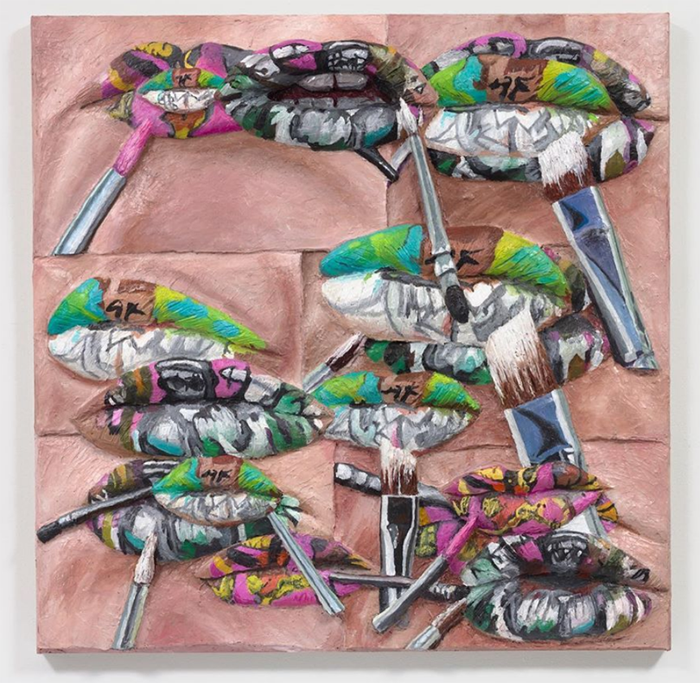
(images from Gina Beavers's website and Instagram)
All I can say is, I love these paintings. Stylistically, they're right up my alley – big, colorful and mimicking makeup's tactile nature so much that I have a similar reaction to them as I do when seeing makeup testers in a store: I just want to dip my hands in them and smear them everywhere! I also enjoy the multiple themes and levels in her work. Beavers isn't commenting just on makeup in the digital age, but also self-representation online, shifting attitudes towards makeup's meaning, the relationship between painting and makeup, and Western art history.
What do you think of Beavers's paintings? If you like it I would highly recommend the monograph, which is lovely and fairly affordable at $40.
I'm doing the #Museum30 challenge on Twitter, and one of the recent prompts was "origin". It got me thinking about the very first makeup museum. While I have no definitive answers, it seems the first cosmetics museum, at least in the U.S., dates back to the 1950s. And there were several others after that but before the Makeup Museum was established. So let's take a quick peek into the origin of the makeup museum and the other spaces that have gone before (along with a a couple that came after).
In October of 1956 it was reported that the House of Cosmetics, a "cosmetics museum and gallery of fame as a historical repository and a tribute to the cosmetics industry", would opening at the former Reed Company on Harrison Street in Newark, NY. It was financed and operated by Pitkin, a cosmetics manufacturer that distributed the Linda Lee line of cosmetics. Among other features, the museum would boast special sections for perfume, lipstick ("Lipstick Lane") and powder ("Powder Puff Parade) , along with gigantic sculptures of a perfume bottle, lipstick and powder box on the roof that would light up at night. The collection consisted of objects donated from the public along with memorabilia from the Pitkin company archives. A perfume fountain at the entrance spouted a brand-new fragrance called Three Coins, created especially for the museum. Visitors would receive samples of the perfume.
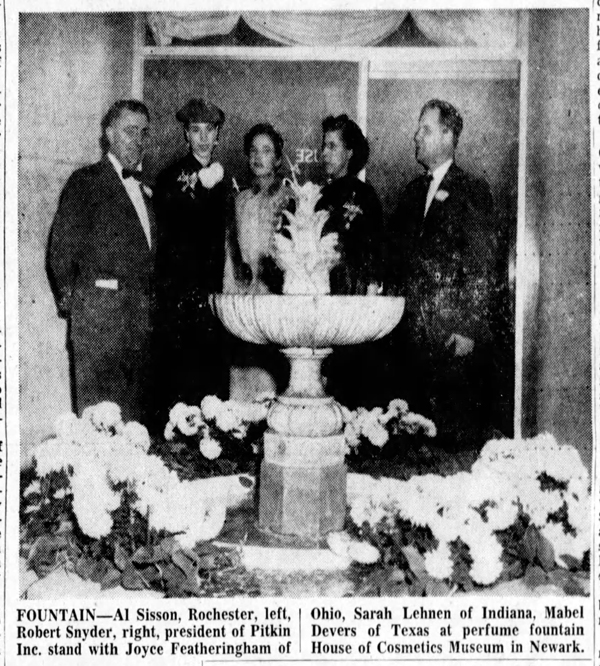
House of Cosmetics Museum, Newark NY, December 1956
The odd thing about the House of Cosmetics is that it allegedly opened in December of 1956, but there is literally no mention of it after that. I could not for the life of me find any information on it following its grand opening, so I can only assume it wasn't successful and quietly closed, perhaps because it was too commercial and focused mostly on Pitkin. The House of Cosmetics was not the vision of a passionate private collector, but that of the current president of Pitkin as a way to raise the company's profile nationwide and celebrate the brand's upcoming 50th anniversary in 1958. The space prominently featured current Pitkin products and it didn't seem as though there were outside curators or historians involved, plus, only Pitkin employees served as tour guides. I know many argue that museums should be run like businesses, and it's a conversation for another time, but I really do think that generally entrepreneurs should not be opening museums.
Fast forward to 1979* when the Pacific Cosmetics Museum, also known as the Museum of Cosmetics History, opened in Korea. While it was established by Pacific Chemicals founder Suh Seong Hwan as part of the company's factory in Seoul, the collection reflects the passion and respect Hwan had for Korean cosmetics history.
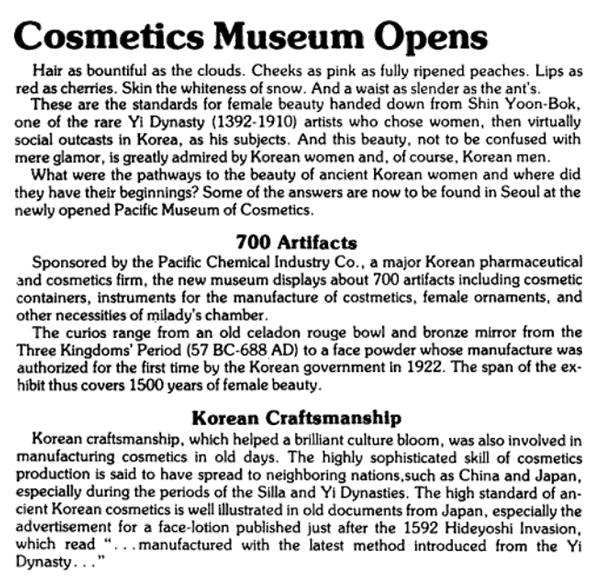
With the help of museum director/curator Chun Wan-gil (Cheon Wan-kil), Hwan continued researching and building the collection, all the while becoming more interested in the cultural aspects of makeup rather than seeing them merely as a way to make money. Not only did Hwan support the museum, he funded research and publications related to Korean cosmetics history. According to AmorePacific biographer Han Mi-Ja, "Chun Wan-gil seemed truly to enjoy working for the museum. He poured all his energy and passion into helping Jangwon [Hwan] with it. As for Jangwon, he was amazed and thrilled to watch how the historic relics seemed to come to life after the hands of Chun Wan-gil touched them. With his guide, Jangwon was able to build his knowledge and awareness of the historic relics, and grew more committed to the cultural activities…Jangwon thought, learned, and discovered a lot while collecting historic relics, building a museum, and presenting the results of his devotion to the world. He was filled with a joy and sense of achievement, which were not the same as he had ever felt from his business."
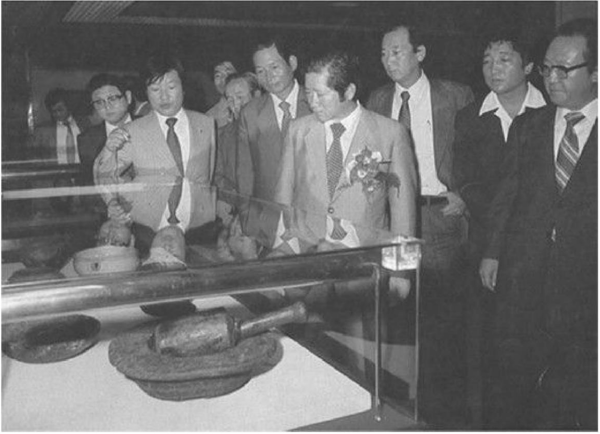
Suh Seong Hwan at the opening of the Pacific Cosmetics Museum in 1979.
In 2009 the museum changed its name to Amorepacific Museum of Art (APMA) and showcases modern and contemporary art rather than cosmetics, although the website states that "it is an institution dedicated to the antiques and artifacts of cosmetics culture in Korea, as well as making a meaningful contribution to local community and education." I really can't tell whether makeup is actually on display there. Ditto for the Pola Museum – while it was established by a cosmetics company president in 1976 and has some makeup on display for special exhibitions, I believe the museum focuses mostly on the founder's personal art collection. So I don't know if either of those really qualify as makeup museums now, but they were at least started that way.
Going back to the U.S., in 1984 the Max Factor Makeup Museum opened in Max Factor's former studio at 1666 N. Highland Avenue in Hollywood, CA. Overseen by Bob Salvatore, a 23-year employee of Max Factor, the museum offered a veritable treasure trove of Max Factor objects and memorabilia. From then it's not clear what exactly happened. Some articles state that the museum closed in 1992, some say 1996; I'm leaning towards 1996 as there are articles from 1995 advertising the museum at that location. In any case, a portion of the collection ended up at the Hollywood Entertainment Museum, which opened in October 1996 and was located at 7021 Hollywood Blvd. The collection remained there until 2004, when it landed at its original location, the old Max Factor studio. The famed Art Deco building had been turned into the Hollywood Museum in the summer of 2003. The Max Factor collection is still there so you can visit (well, maybe if the pandemic ever ends!)

(image from thehollywoodmuseum.com)
During this time, Shiseido opened their corporate museum in Japan as a way to celebrate the company's 120th anniversary in 1992. I've written about this one before so I won't rehash it, but you can check out my post. A decade later, in 2002, an Alabama paper reported on the Avon Fan Club House of one Mira Dawson. Ms. Dawson was a top seller and avid collector of Avon memorabilia, even dressing like one of the company's co-founders to greet visitors. She charged $2 for admission to her home, which functioned as the museum. Here's to home-based museums!!
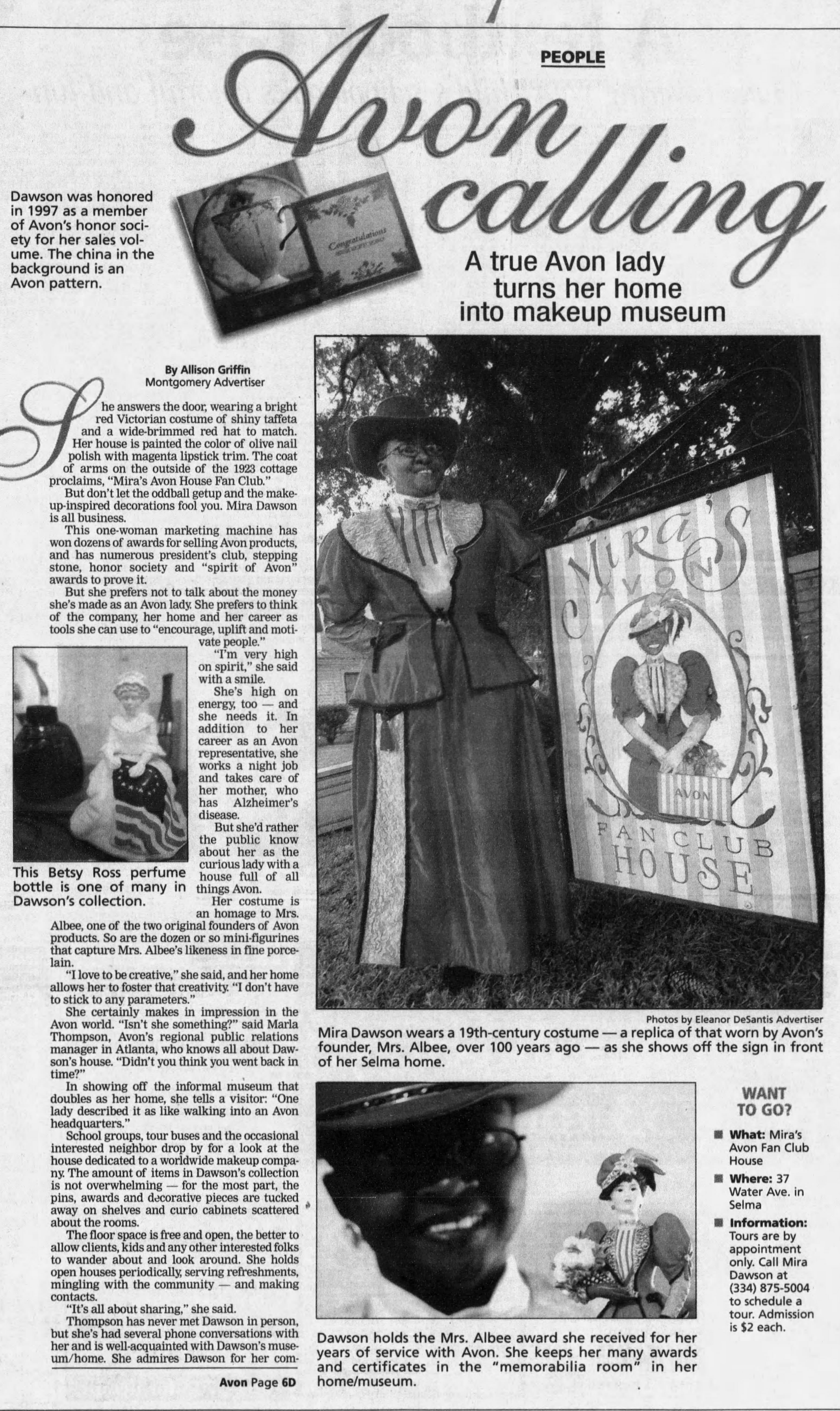
A year later, in November 2003 the Coreana Cosmetics Museum opened in Seoul. This was another one started by the company president; however, like the Pacific Cosmetics Museum, it seems to be far less profit-driven than the House of Cosmetics. The Coreana Cosmetics Museum showcases over 5,300 objects from all eras and seems to have curators and historians working there rather than relying on company salespeople.
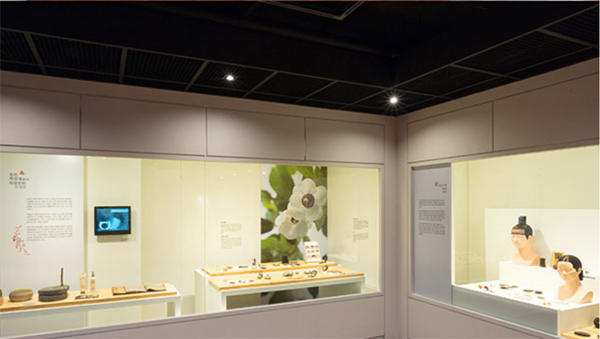
(image from spacec.co.kr)
Just a few years later, in 2006 the Beni Museum was established in Tokyo. I've posted about that previously too so I won't go into it again, but you should really check it out as it's fabulous. So that takes us to late 2007, when I registered the domain for the Makeup Museum. Interestingly, on Instagram I got to chatting with the previous owner of the domain! Oldschoolcosmetics had the idea of a makeup museum all the way back in the '70s and registered the domain around 1995, but realized how difficult it was and ended up walking away from makeup entirely. Here's what she had to say: "I first had the idea for a cosmetics museum in the 70s when I became really aware of makeup, brands and how quickly things disappeared from shelves. My dad had a museum background and my parents took me to museums on every vacation. I started to think seriously about it in the 90s and registered the domain then. There were no odd or new domains then, just .com, .org and .net. I don’t recall if I registered .com or .org or both, but definitely not .net. At the time there was a Max Factor exhibit in the LA area, and at least two active makeup schools there which specialized in special effects and Hollywood film work. I wasn’t as interested in that, but it became obvious that the industry was based in NY and LA, rent would be prohibitive, the industry giants could set up a museum faster than I could, would definitely do so after I started up, anything on display could be permanently ruined if there was a blackout or A/C malfunction, and the bulk of the work would be grant writing, networking and managerial. I abandoned the idea fairly quickly. Ignoring all other beauty like wigs, nails, skincare, fragrance, there was still too much for one building if you showed stage makeup, drag history, failed brands, etc. Back then there were less collabs, less brands, less releases a year, the world wide web was just starting and everything was still paper catalogs, in store displays, etc. Now a museum would have to cover cancel culture, influencers, indie brands, brand owners, many more foreign brands, etc. I used the domain for a private message board about makeup. I wanted to call it makeup mavens but someone had that name and a brand that used it. This was circa 1995? Eventually I got bored with the industry, the sheeple customers, products that disappointed, etc."
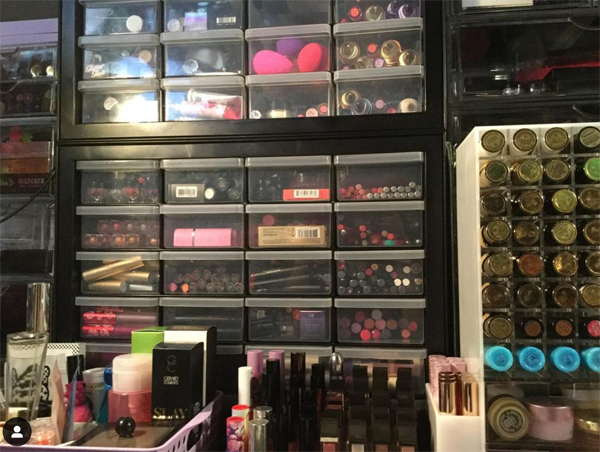
(image from @oldschoolcosmetics)
So it was kind of a downer to hear, but that sort of brutal honesty is needed at times, plus it shows I'm not a total failure – it's basically impossible to open a cosmetics museum without any investors or industry connections, or unless you're independently wealthy. In any case, this person is enthusiastic about makeup again and supports the Makeup Museum. She has been extremely kind in talking with me about the challenges of opening a physical space and digitizing the collection, particularly as they relate to funding sources. She has given me quite a few excellent suggestions so hopefully I'll be able to pursue them. Anyway, in August of 2008 I wrote my first blog post, so I usually consider that to be the Museum's official birthday.
A little bit after the Makeup Museum was established, makeup artist René Koch opened his private collection of lipstick in Berlin to the public in 2009, naturally called the Lipstick Museum. This is still on my must-see list! Known as "Mr. Lipstick", Koch was the head makeup artist for YSL for over 20 years and has amassed a spectacular collection of lipsticks and related memorabilia.
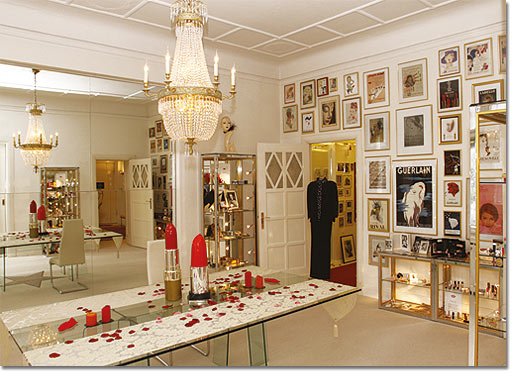
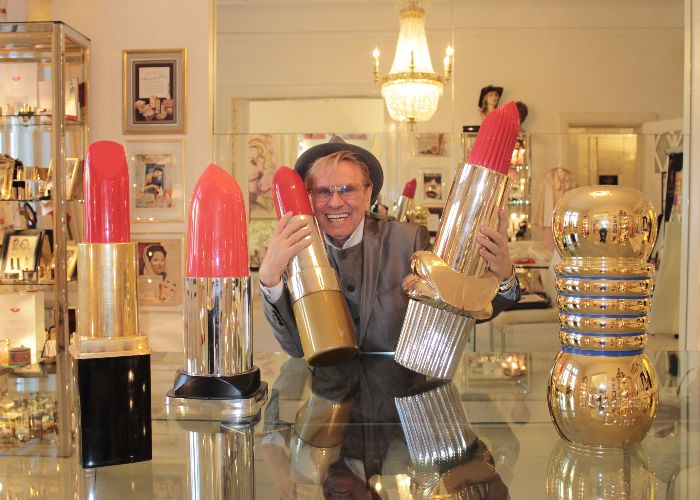
(images from lippenstiftmuseum.de)
Finally, we have the London Cosmetics Museum, founded by makeup artist Xabier Celaya in 2015. Like the Makeup Museum, it's an online-only pursuit for now. However, Xabier exhibits his collection at local universities, stores and cosmetology schools, and I'd be very surprised if he doesn't have a public physical space shortly.
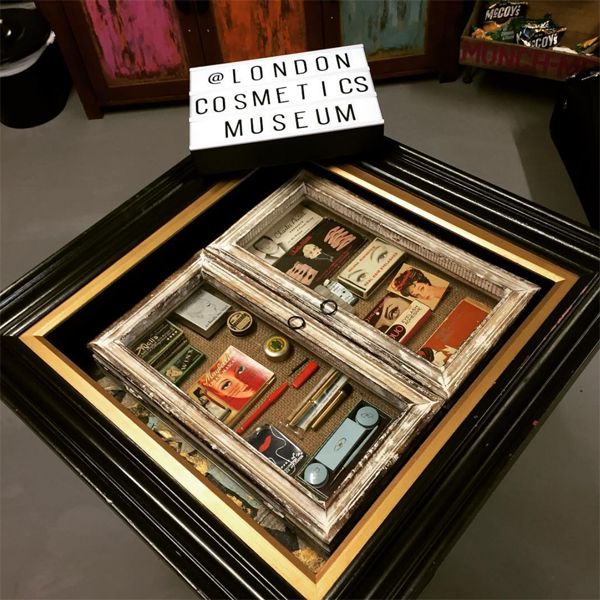
(image from @londoncosmeticsmuseum)
All of this goes to show there's been an interest for many years in exhibiting and preserving makeup history and beauty culture. I certainly was not the first one to have the idea of a cosmetics museum, nor will I be the last – I know of several makeup artists who are actively trying to open their own spaces. However, if they follow in the footsteps of a certain other entity and claim to be the first, well, you know it's a lie. 😉
Thoughts?
*There was a museum started by the president of Merle Norman Cosmetics in 1972, but I believe it was just a private collection of his cars and other non-makeup objects.
It's hard to believe I haven't done a Halloween roundup since 2016, but here we are. Hopefully this post will compensate for the makeup I missed the past couple of years, as cosmetic companies continue churning out spooky and fun collections. I would have purchased some for the Museum, but by the time I made up my mind about which ones to add they had sold out and weren't restocked in time to arrive by Halloween. It says something about the demand when these collections are released in late September and sell out immediately…I think consumers and businesses are feeding off each other, both creating the increased frenzy for Halloween-themed makeup collections.
I'm not the biggest fan of either The Nightmare Before Christmas or Hocus Pocus – I've never even seen the latter – but I will hopefully add them to the Museum's collection as I thought they were cute and culturally significant enough to warrant purchasing.
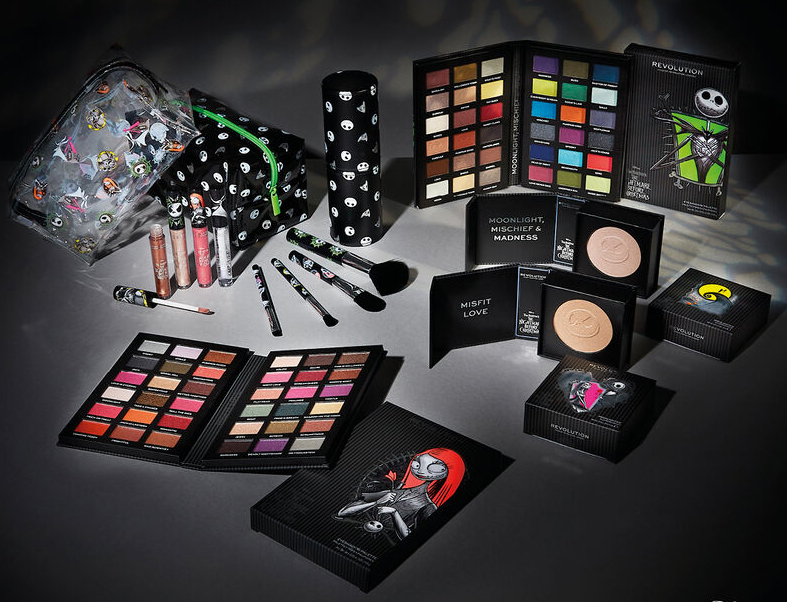 (image from revolutionbeauty.com)
(image from revolutionbeauty.com)
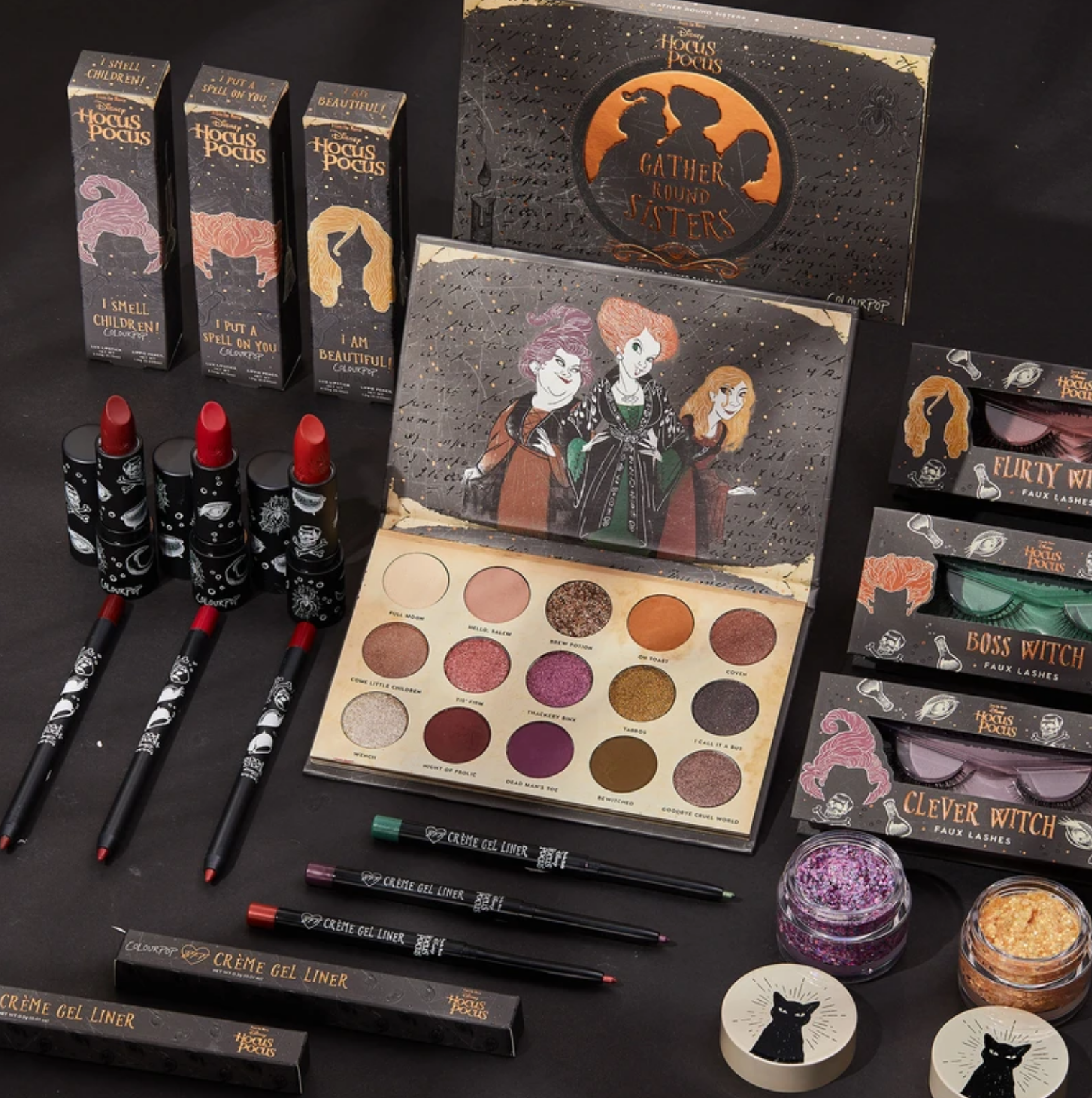 (image from colourpop.com)
(image from colourpop.com)
I should probably re-watch Beetlejuice. As a kid it scared me half to death but obviously as an adult I should be able to handle it, plus it's got a good cast. This Melt collection would go nicely with Hot Topic's Handbook for the Recently Deceased palette I bought in 2018.
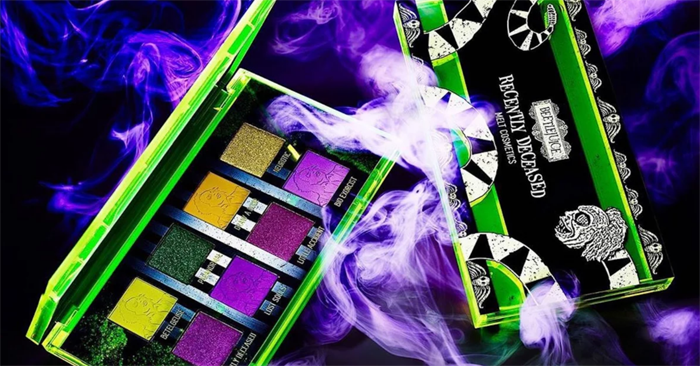
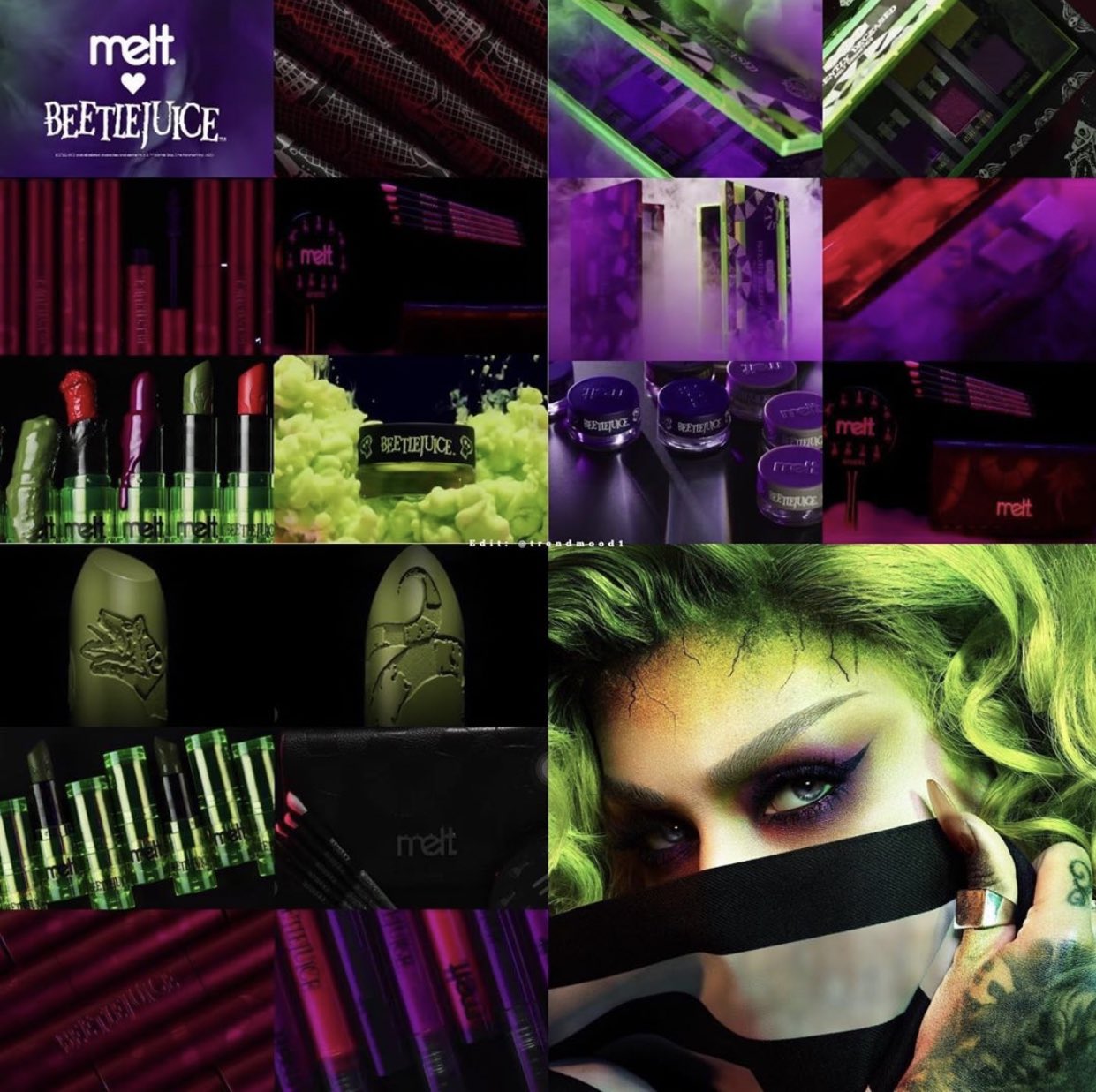 (images from popsugar.com)
(images from popsugar.com)
Here's some other miscellaneous Halloween fun released this year.
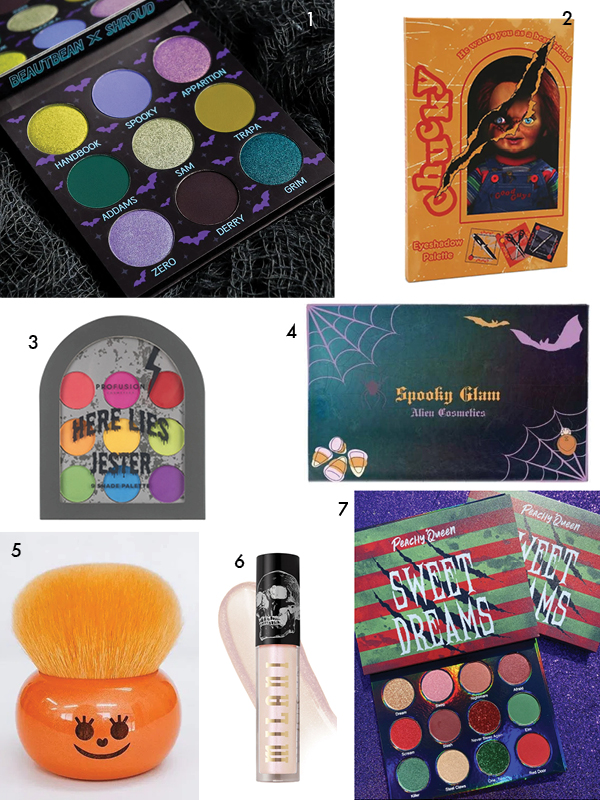
- Shroud Cosmetics It's Freakin' Bats palette
- Hot Topic Chucky palette
- Profusion Here Lies Jester palette
- Alien Cosmetics Spooky Glam palette
- Kihitsu pumpkin face brush
- Milani Halloween edition Ludicrous Lip Gloss in Let's Bone (yes, that's really the name.)
- Peachy Queen Sweet Dreams palette
And now for a couple vintage pieces. I'm pleased to have added this Glebeas (pronounced glee-bay) to the Museum's spiderweb collection. Even though I hate spiders there are some great objects with spiderweb designs. You can read the whole history of Glebeas and see some of their other spiderweb packaging over at Collecting Vintage Compacts.

About three years ago I found a brass version of Volupte's awesome cobweb compact for a very good price in excellent condition and an original ad. The compact dates to about 1946-1952 and there were many variations, including sterling silver and 14kt gold, along with butterflies and ladybugs that had the misfortune of getting caught in the spider's lair.
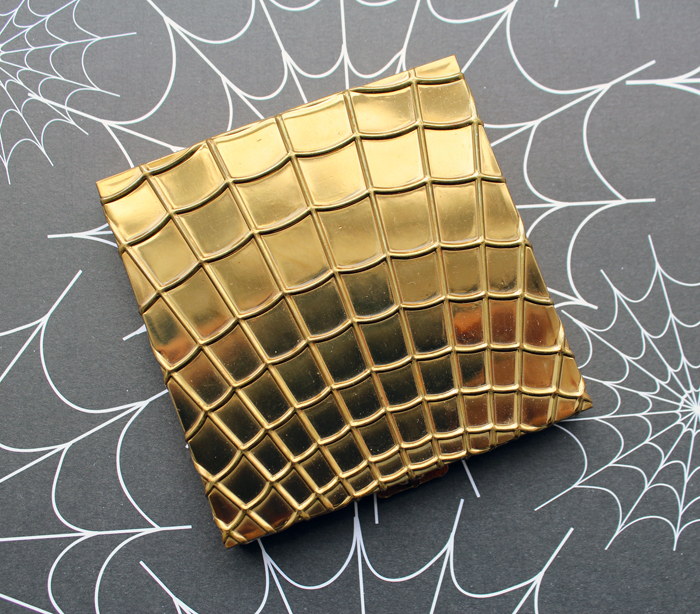
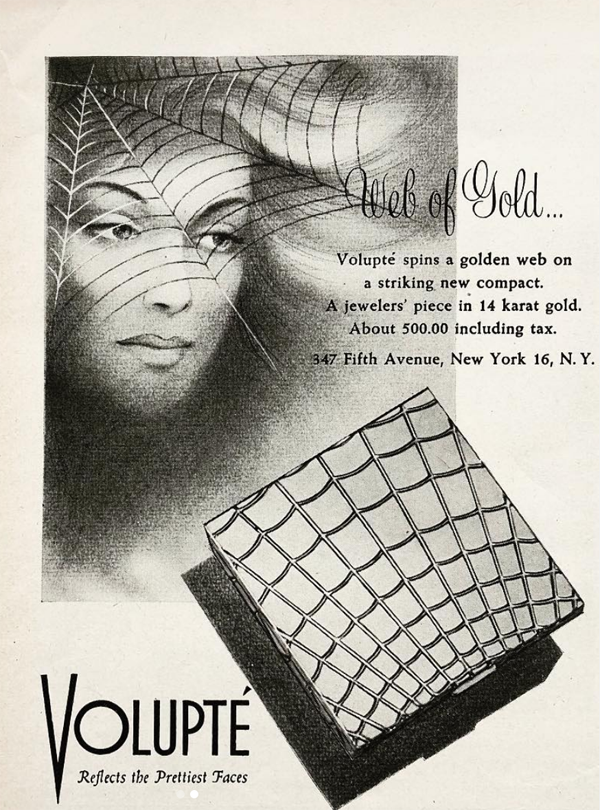
Interestingly, the spiderweb design was created by Josephine Forrestal, a Vogue writer turned military wife. According to the patent the compact was originally intended for Paul Flato, for whom she created other compacts, so how it ended up with Volupte I'm not sure.

(image from books.google.com)
So while it's small now, I hope the Museum's spiderweb collection continues to grow. By the way, do you remember the Elegance eyeshadow on the right?
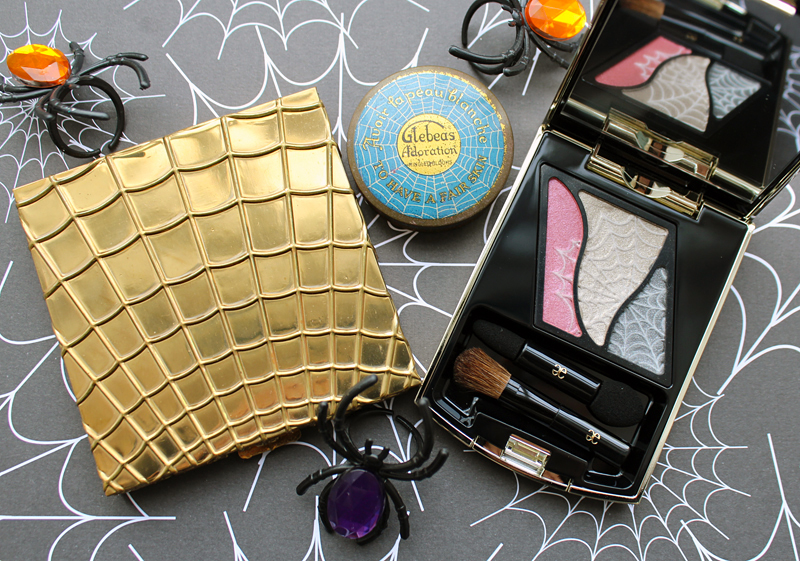
Some other spooky vintage finds include a celluloid coffin-shaped compact:
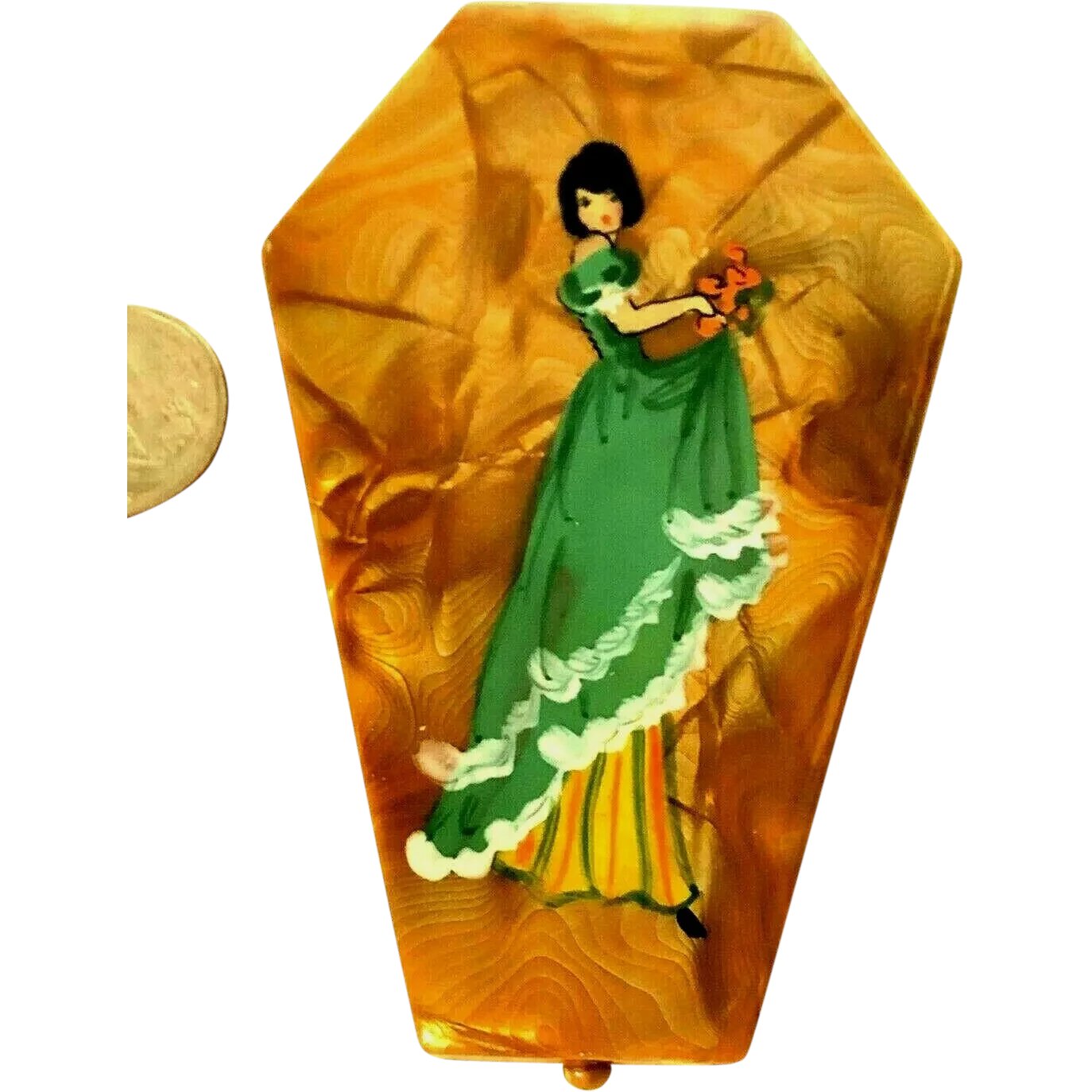
(image from rubylane.com)
Wound filler used in mortuary makeup:
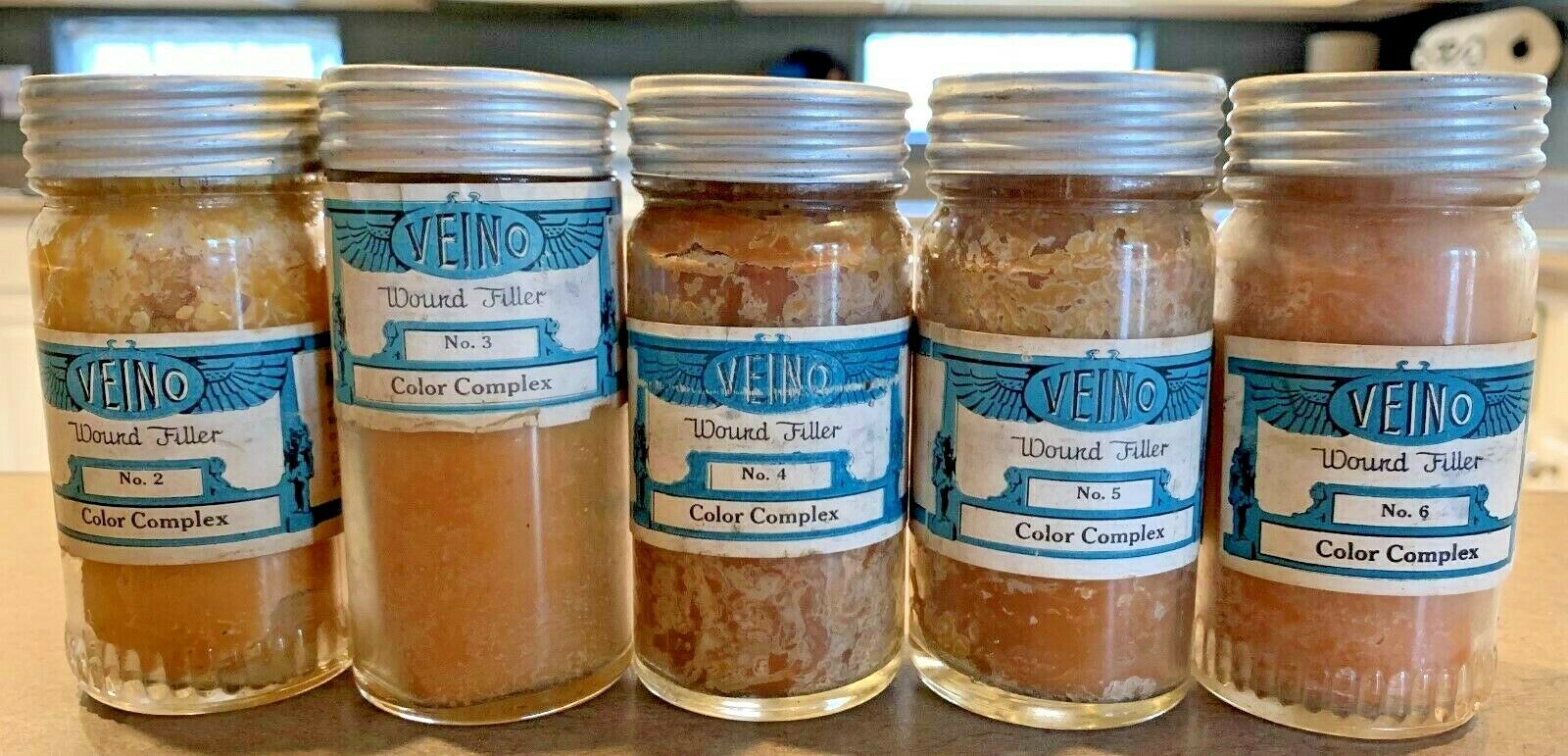
(image from ebay.com)
And a makeup room in Illinois said to be haunted by the deceased director of the Peoria Players Theater:
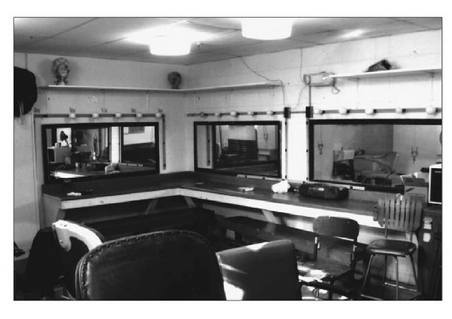
I hope you have a fun Halloween! Are you dressing up? I am not but the plushies and I will be eating copious amounts of candy, of course.
I was hoping to post about Bobbi Brown's collaboration from this past spring, a partnership with British artist Morag Myerscough, but I realized I never got around to writing about an Asia-exclusive collab from last year so I'm covering that first. In the spring of 2019 the brand teamed up with Korean-born, New York-based artist Yoon Hyup, whose abstract urban landscapes, appropriately enough, have been created and displayed in cities across the globe. For Bobbi Brown's cushion compacts the artist made three designs: New York Skyline (Manhattan), Spread Love (depicting the Brooklyn Bridge) and Band of Light (representing Times Square).
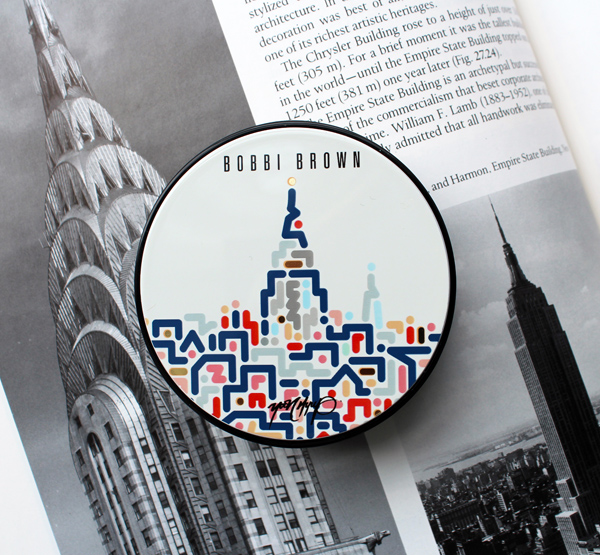
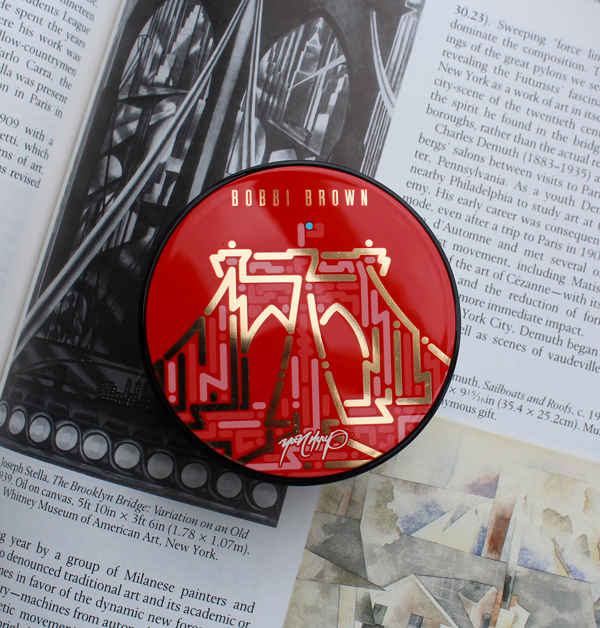
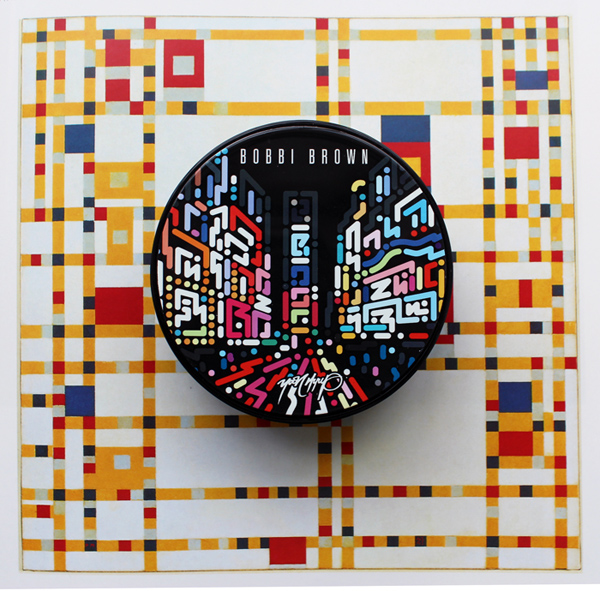
Hyup (b. 1982) was born and raised in Seoul. He began what would become a lifelong love affair with skateboarding and skate culture at the age of 9.
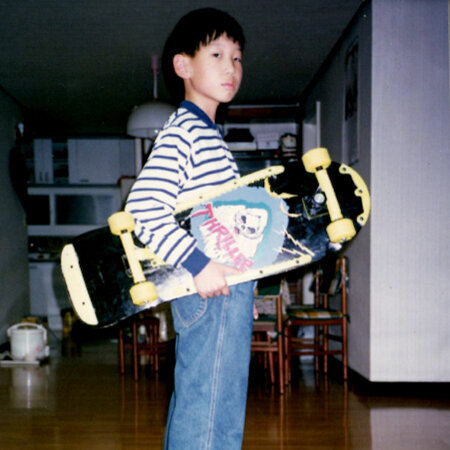
(image from recessnewyork.com)
While skateboarding is a key inspiration for his work – his lines and dots represent how he feels when skateboarding (like "flowing water", he says), music remains his primary influence. He studied violin for most of his childhood, getting scolded for improvising during lessons. As a teenager Hyup discovered hip-hop and graffiti magazines at a nearby U.S. naval base, further feeding his appetite for skate culture, music and art. In college he started out studying graphic design as he wanted to design skateboards, but quickly realized he enjoyed painting more. One night at a party a DJ asked him to paint while he spun, and for Hyup, there was no turning back. He has painted to music ever since. "From the early 2000’s, a hip hop party called “Afroking Party” was getting popular in Seoul. I would hang with DJs, MCs, B-Boys, skaters, writers and photographers there. It was the first place where I exhibited my artworks and perform live painting. A DJ crew wanted me to paint live while he performed his set, a mix hip hop, funk, disco, we’d perform all night. That was when I was 23 or 24 years old, and then I met more and more people, they would learn about me and ask me to do more paintings. I started to use lines and dots when I performed live painting, because I wanted to express something quick while DJ Soulscape and DJ Plastic Kid were spinning." Hyup listens to a variety of jazz, hip-hop, funk, soul and disco. To get an idea of what such a mix sounds like, you check out one of his playlists here.
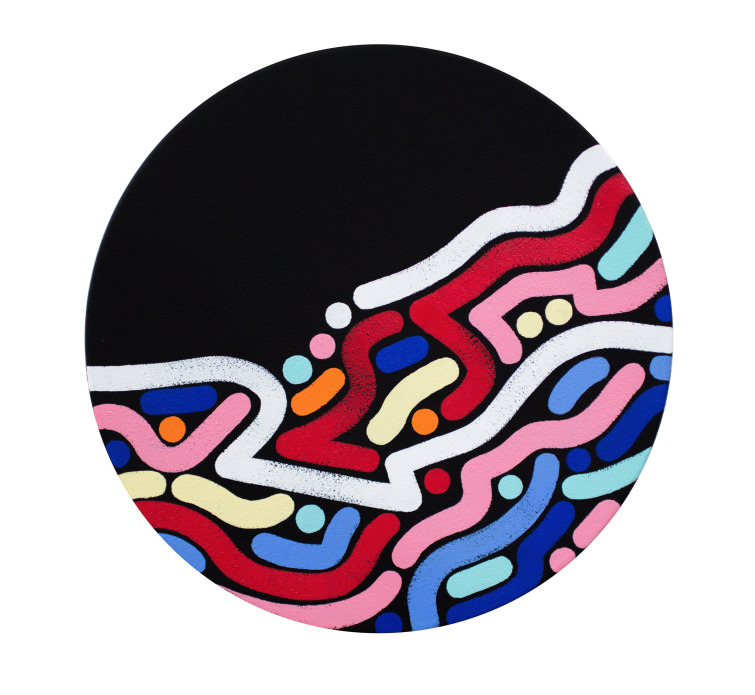
Hyup likens his improvisational process to jazz or rap. For larger projects he sketches the overall structure, but generally does not draw beforehand. "I don’t sketch when I paint. If I need to sketch, I would only put the big structure. Other than this, I only do with free-hands on canvas or wall paintings without sketches. It may be similar to a jazz performance which only has a plan but plays impromptu. It’s similar feeling from listening improvisational music, funk or freestyle rap. When I skate, I feel rhythm and flow…I like to express these feelings with lines and dots."
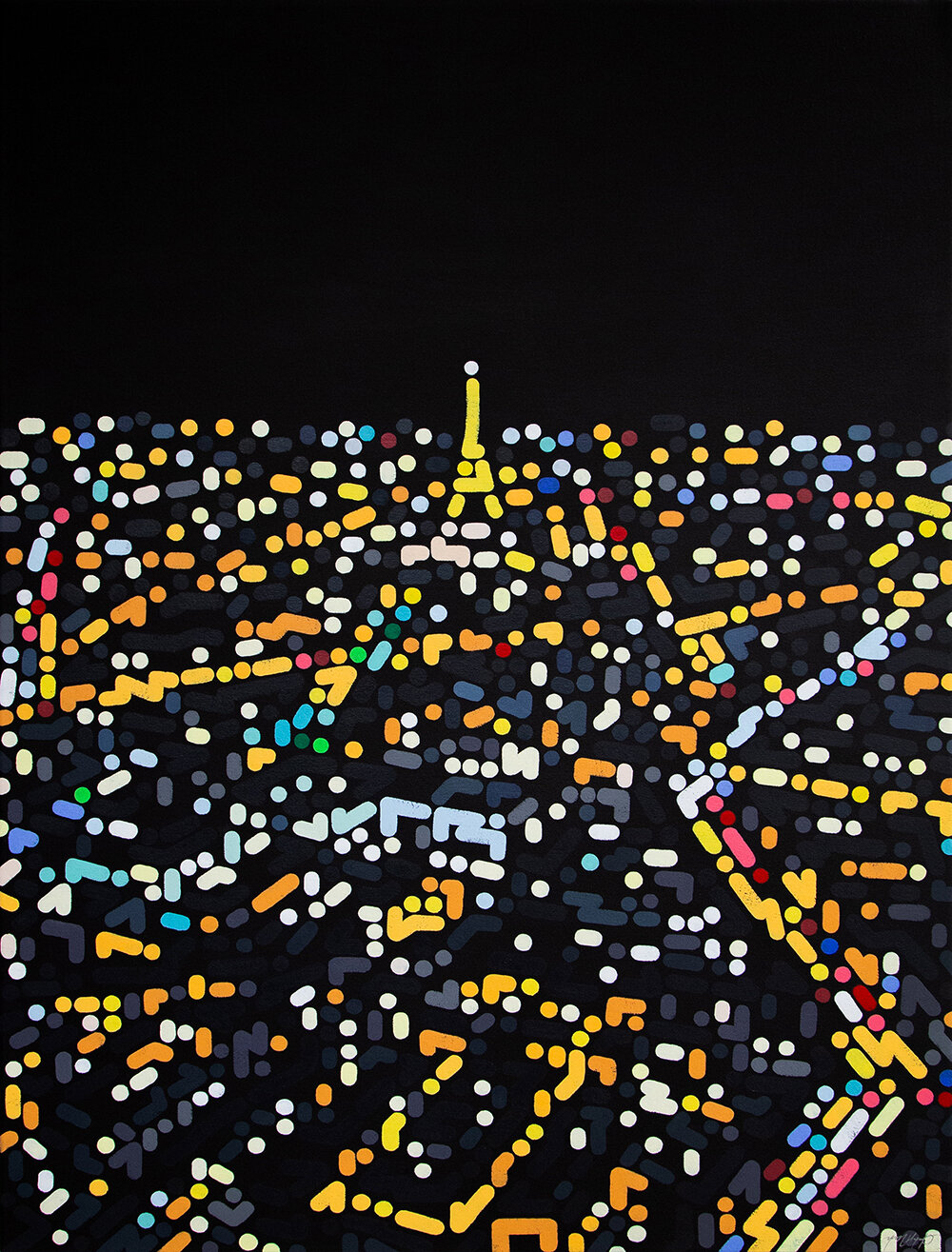
Hyup's forté is vibrant city life, but he is equally adept at representing more calming scenes, such as tropical vistas and clouds. And while he cites American graffiti artists such as Futura, Lee Quinones and Mark Gonzales, along with Jean-Michel Basquiat and designer Don Pendleton as influences (I'd add Mondrian to the list), Hyup also reinterprets elements of traditional Korean art. Paintings of clouds, along with the use of obangsaek – five colors associated with the cardinal directions – are the artist's way of paying homage to his cultural heritage. "Many traditional Korean forms, such as vine clouds and wind clouds, surface in my paintings. I often paint with the five colors associated with my native country – red, blue, yellow, black and white. This color palette can be found in many things that relate to Korean culture, such as art, dress, and the painting for architecture. I use those colors to pay honor to my roots. I also find other colorways from nature and things around me."
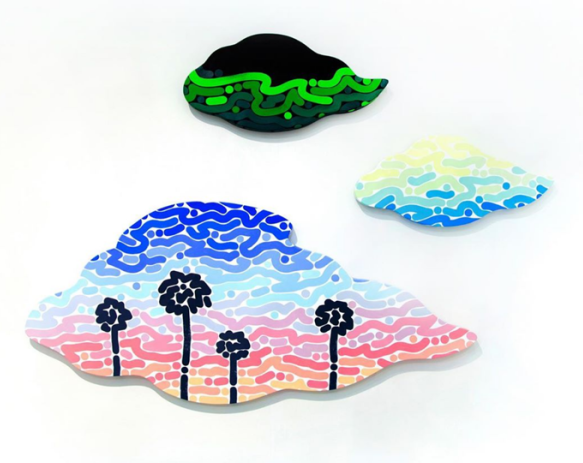
(images from yoonhyup.com)
Hyup's work generally consists of cityscapes, but occasionally his playfulness shines through via characters from pop culture. I'm delighted with these portraits of Cookie Monster and the Pillsbury Dough Boy! Fun fact: I was obsessed with the Pillsbury Dough Boy when I was little and have a decent collection of memorabilia. I'd love to see Pills on a shirt, similar to the Mickey Mouse ones Hyup made for Uniqlo.
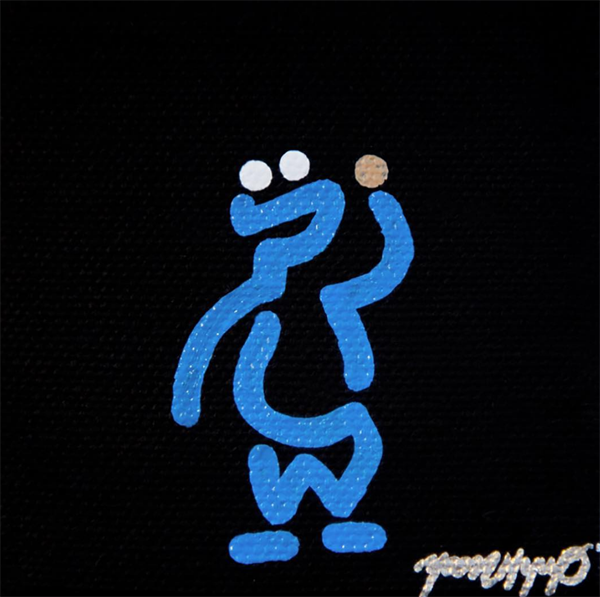
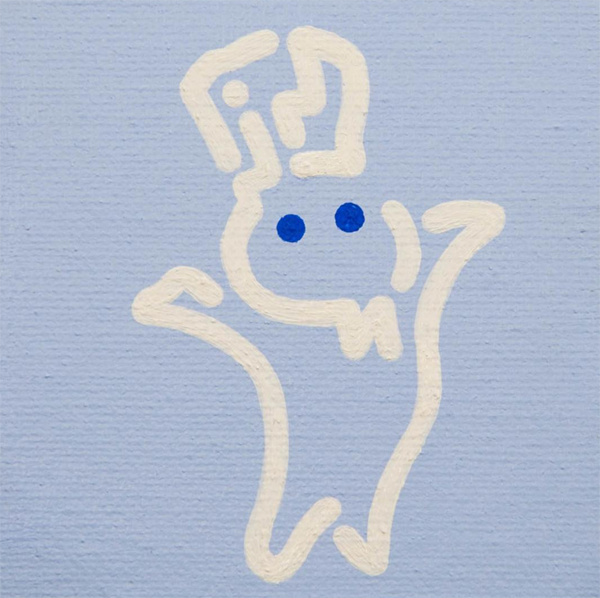
Also, how precious is this holiday wonderland he created in Shanghai last year?

(images from @ynhp and yoonhyup.com)
As for the collab with Bobbi, I'm not sure how it came about or why Hyup decided to partner with the company. (I emailed to request an interview but never heard back, sadly.) "I collaborate when I already know the brand well enough or when it naturally happens. Honestly, I haven't had to think about a brand I want to collaborate with because luckily, clients have always come to me and proposed collaborations. Sometimes I don't do it when I don't understand the brand well enough or it doesn't fit well with my style," he says. A cosmetics collaboration doesn't seem like it would align with the artist's interests, especially given his previous work for sportswear and apparel stores located in urban locations, like Nike's Gangnam headquarters and the Rag and Bone store in Soho.
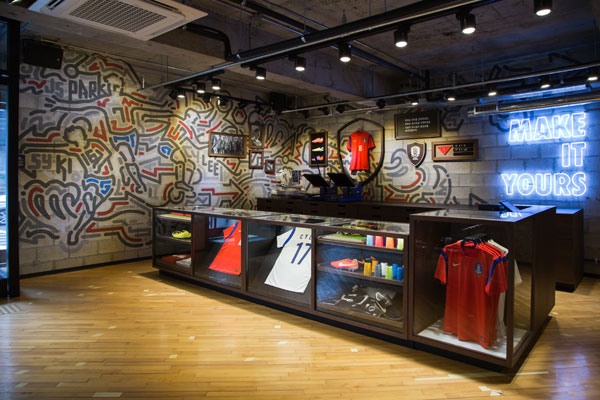
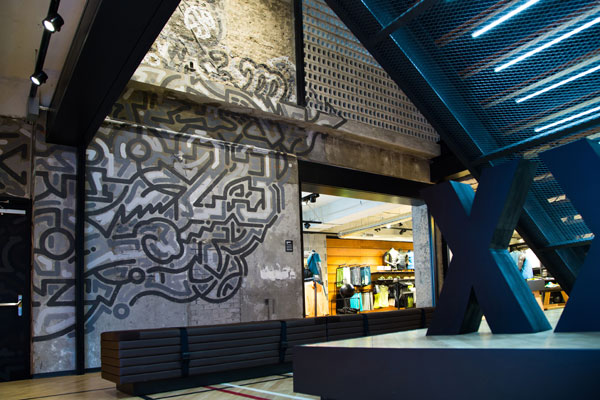
This mural centers on the number 23, worn by basketball star Michael Jordan.
(image from idnworld.com)
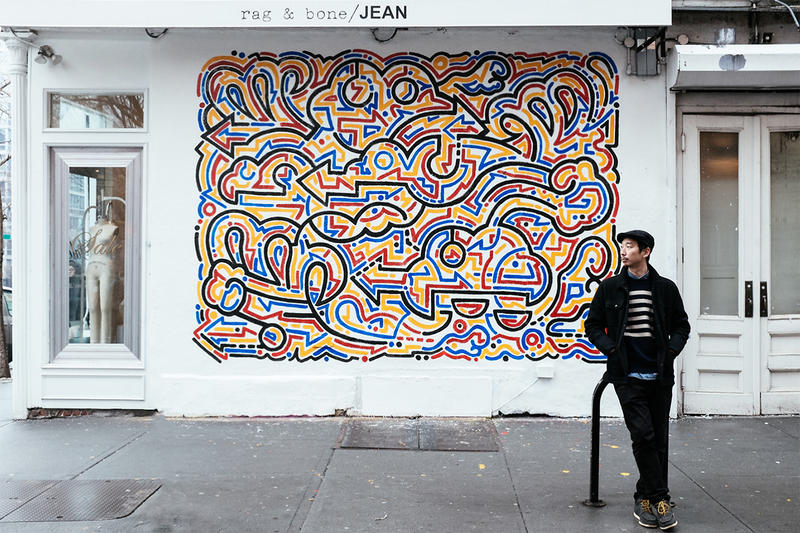
This mural, entitled Wishing a Bright Sunny Day, has rightfully drawn comparisons to the work of Keith Haring.
(image from hypebeast.com)
Hyup also designed the cover art for a CD box set for Ella Fitzgerald in honor of the singer's 1ooth birthday in 2017, which was fitting given jazz's influence on his process.
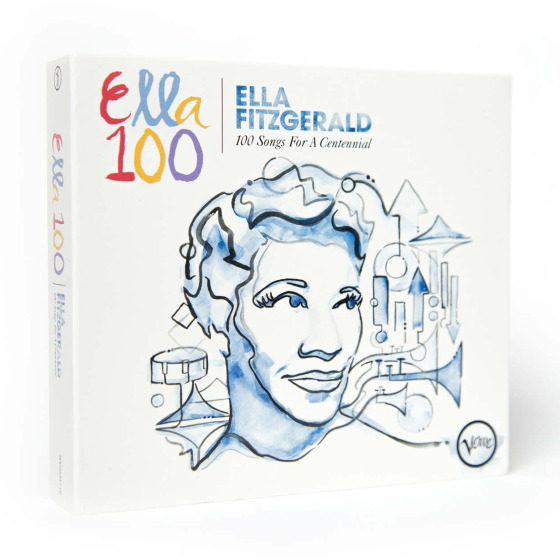
So makeup seems a little out of left field. I also can't figure out why only the city of New York was featured on the compacts, as these were Asia-exclusive…it would have made a bit more sense to include Seoul as well. Perhaps it's Hyup's love for NYC that propelled the focus on New York. In any case, I believe all three of the designs were new for Bobbi Brown, but there are similarities. Here's Rooftop Jam (2019) and Spread Love (2014) – the latter has the same name as the cushion compact showing the Brooklyn Bridge.

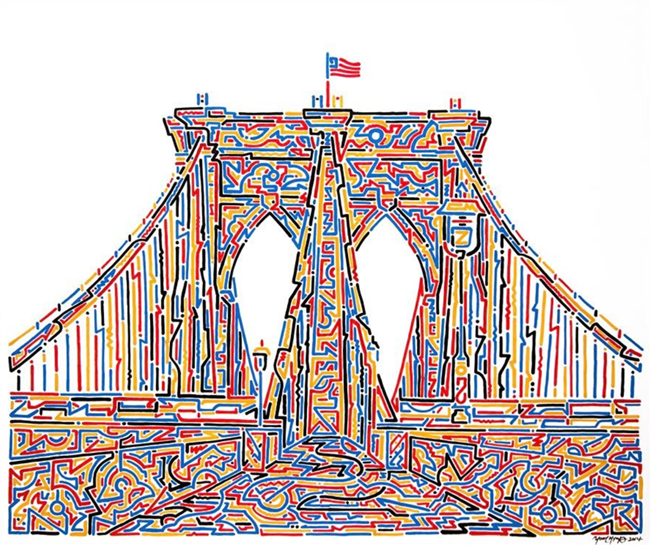
(images from yoonhyup.com)
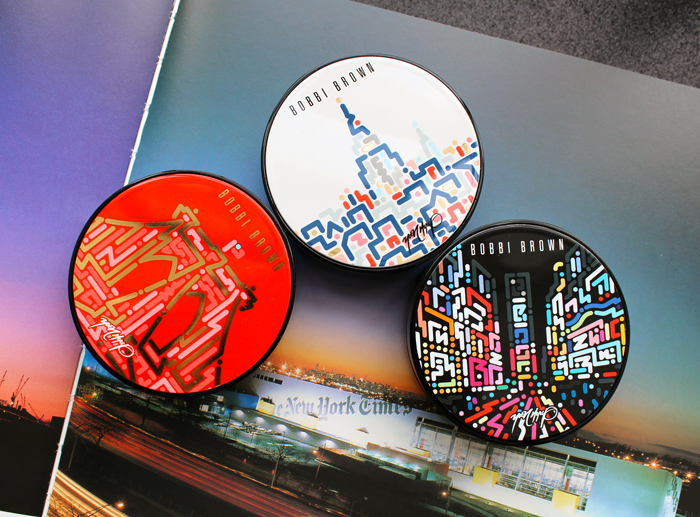
While I'd still like to unravel the mystery of the collaboration's origin, I enjoyed this collection nevertheless. Hyup's improvisational method perfectly captures the frenetic pace of cities, and I don't think his work would have the same effect if he painted without music. And New York is always magical so if they had to focus on any one city I'm glad it was the Big Apple.
What do you think? Which case is your favorite? Mine is Band of Light. I don't like to actually visit Times Square in person, but this image is so vibrant I can practically hear its pulse.
I distinctly remember ordering this Paul & Joe collection in April of 2019, as my dad was still in the ICU and I felt guilty for taking a few minutes to place an order before visiting him. But I knew the collection would sell out immediately so I had to go for it. Adorable though it is, I kept putting writing about it until this year, and then when I finally got around to doing some research I discovered this little guy's birthday is September 3, 2112 so I waited a bit more (although obviously I couldn't hold off for another 92 years unless cryogenics actually worked.) Please give a warm welcome to Doraemon, a robotic cat from the future!
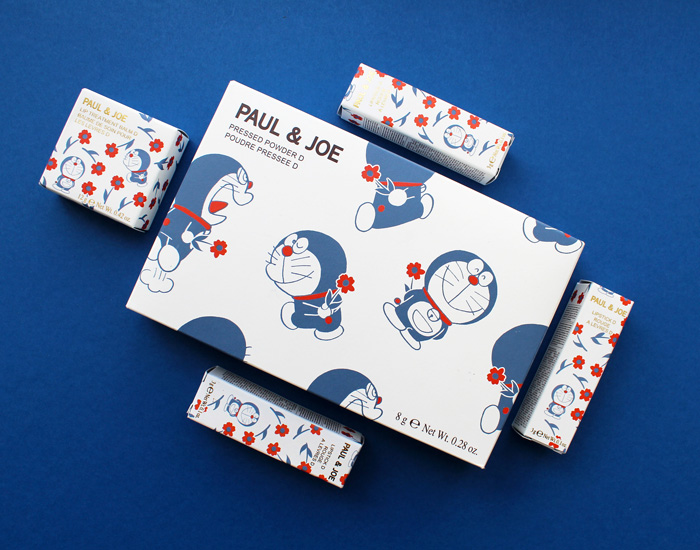
Doraemon is a manga series created by a duo of Japanese writers Hiroshi Fujimoto and Motoo Abiko, better known by their pen name, Fujiko Fujio, in 1969. Fujimoto was inspired by three specific events: his wish for a machine that would come up with ideas for his writing, his daughter's toy that caused him to trip, and the sound of some neighborhood cats fighting. The story chronicles the misadventures of Nobita Nobi, a preteen boy who is described as goodhearted and kind yet lazy. He gets bad grades due to his laziness and is frequently bullied.

(image from doraemon.fandom.com)
Doraemon is sent back from the future by Nobita's great great grandson, Sewashi Nobi, to help Nobita grow up to be successful and alter history so that his descendants will be more prosperous. However, since Nobita's misfortunes continue as an adult which affects his future offspring, Sewashi is poor, so he can only afford a mediocre and not particularly helpful robot.

(image from vsbattles.fandom.com)
That premise sounds interesting in and of itself, but there's more. Doraemon has a special four-dimensional pouch on his tummy where he stores various futuristic gadgets intended to help Nobita. Some examples, according to the Doraemon Wiki page: "Bamboo-Copter, a small piece of headgear that can allow its users to fly; the Anywhere Door, a pink-colored door that allows people to travel according to the thoughts of the person who turns the knob; Time Kerchief, a handkerchief that can turn an object new or old or a person young or old; Translator Tool, a cuboid jelly that can allow people to converse in any language across the universe; Designer Camera, a camera that produces dresses." These sound like fantastic ideas, but you can see where they're heading. While the devices were supposed to make Nobita more successful, the series focuses on the hijinks that ensue as he uses them incorrectly or for the wrong purposes.
 (image from doraemon.travel.blog)
(image from doraemon.travel.blog)
As with nearly all the protagonists in Japanese series, Doraemon's character is carefully conceived with a complete backstory. The "Dora" part of his name derives from "dora neko" (stray cat), while "-emon" is an archaic suffix for male names – just Fujimoto having a bit of fun by giving a character from the future an obsolete moniker. The reason for Doraemon's blue color and rounded head is that shortly after his creation in the robot factory, a mouse nibbled his ears off and frightened Doraemon so badly he turned blue – he was originally yellow in color. Poor thing!

(image from says.com)
As for Paul & Joe, they spared no details. All of the products are covered in a delightful floral print featuring Doraemon in a variety of poses.
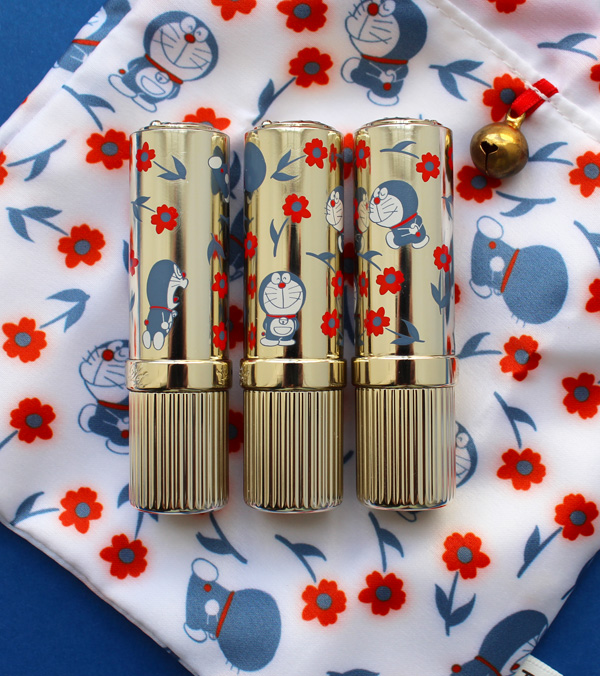
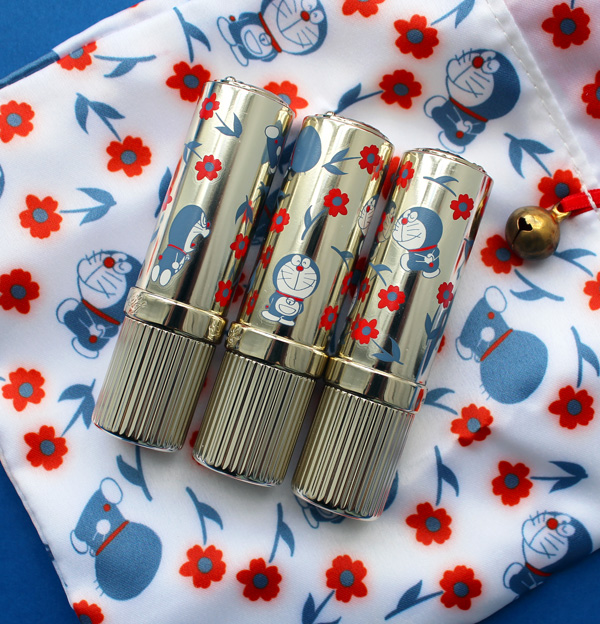
The lipstick caps as well as the lipsticks themselves are engraved with Doraemon's face. These lipsticks, you might recall, use a technique known as kintaro-ame.
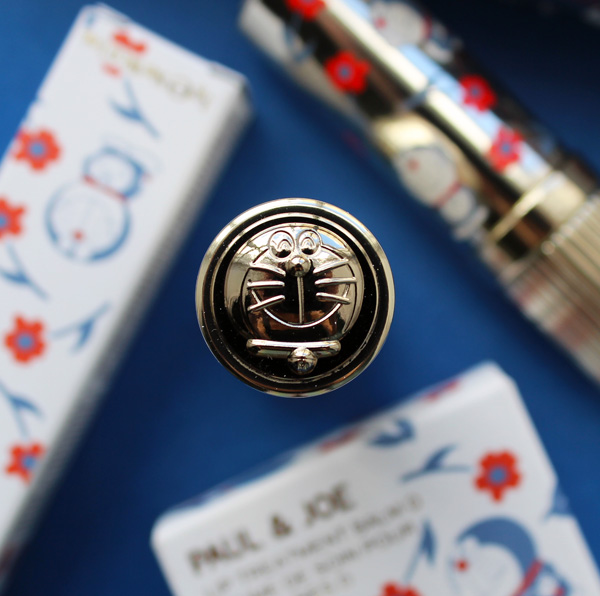
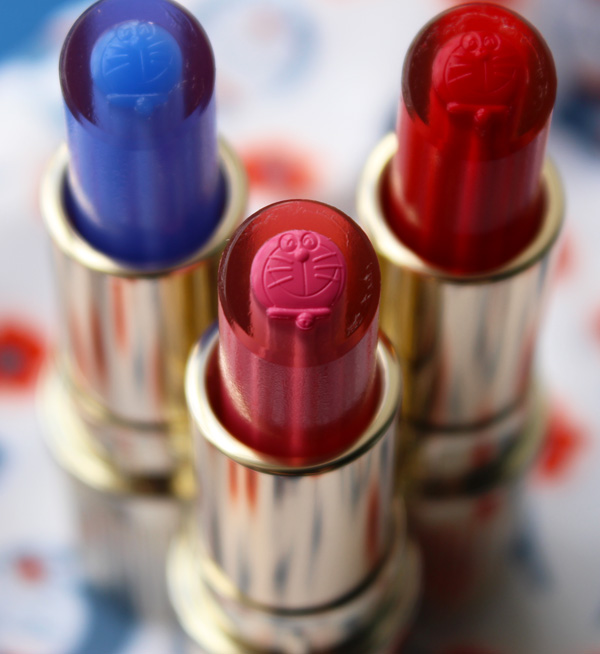
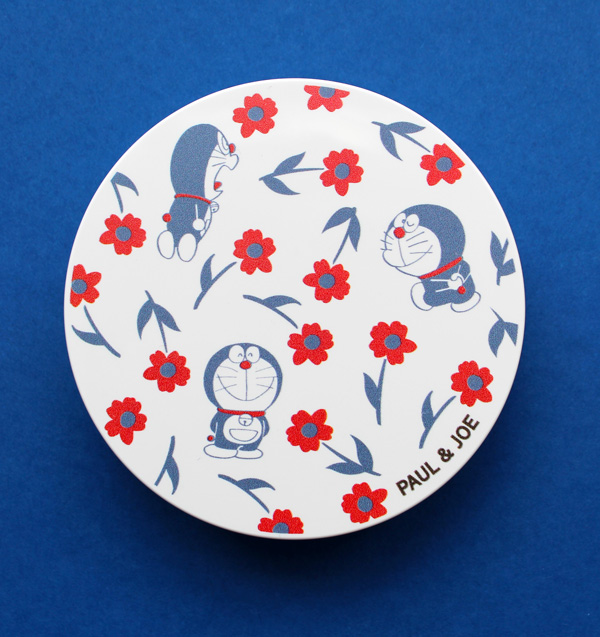
How cute is the embossing?! And the bell on the pouch recalls the one Doraemon wears around his neck.
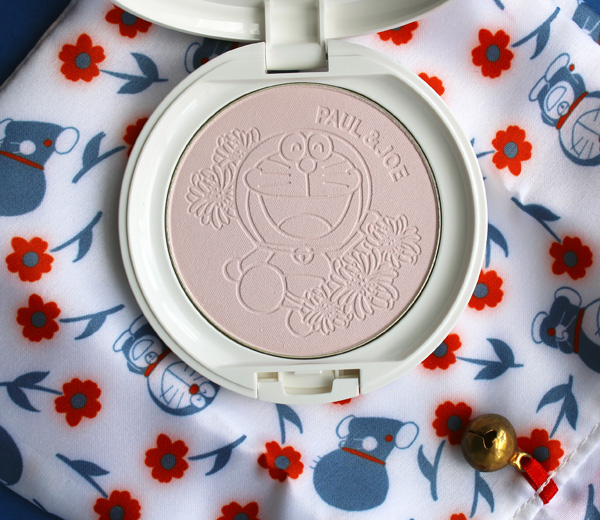
This is perhaps my favorite piece of the whole collection. Not only is the outline precious, the balm is scented like dorayaki, pancakes filled with a sweet red bean paste that are Doraemon's favorite snack.
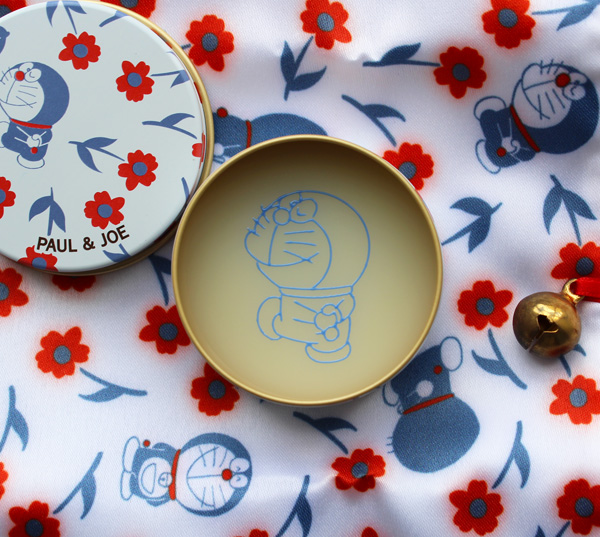
Doraemon's cultural impact cannot be overstated. After 1,465 stories in the original manga and 2,372 episodes between two TV series to date, in his native country the character became as iconic as Mickey Mouse is in the U.S. The popularity of the Doraemon series in Japan can be attributed to several factors, such as the dawn of a new technological age in the late 1960s and economic prosperity starting in the late '70s (the first animated Doraemon show premiered in 1979). And while it was intended for children, it's also relatable for Japanese adults, whose workaholic culture perhaps makes them envious of Nobita's lackadaisical style. However, Doraemon's appeal is universal. Despite varied receptions in different countries, people from all over the globe generally identify with Nobita's struggles and Doraemon's attempts to help. As Caitlin Casiello, a Yale Ph.D. candidate in Japanese and film and media studies, explains to the Japan Times, "A lot of the appeal of 'Doraemon' is actually that Nobita is so familiar and relatable — he’s average, goofy, lazy, a bit uncool, but still a good kid — so we recognize him. Therefore, Doraemon would be our friend, too. This contrast between a normal boy and time-traveling robot cat makes us feel connected to Doraemon, like participants in their adventures."

As with Sanrio characters, there are literally thousands of Doraemon-branded products and collaborations, which raked in $5.6 billion in sales as of 2016. Even Takashi Murakami got in on the Doraemon action.
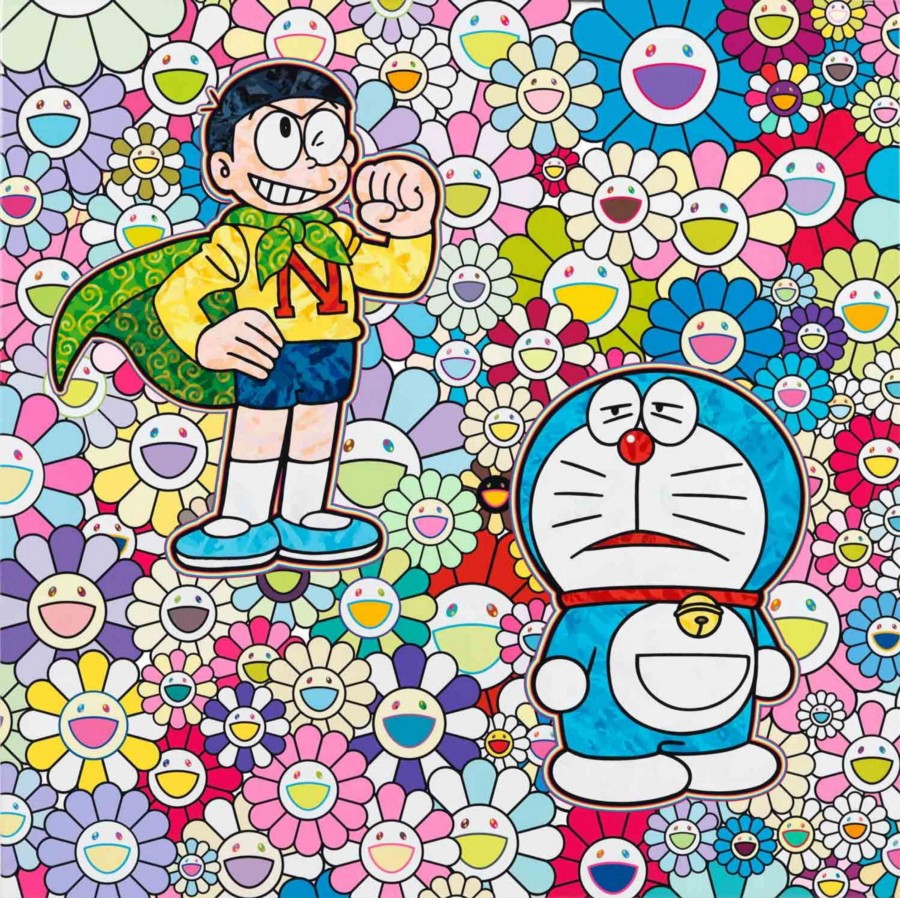
(image from jw-webmagazine.com)
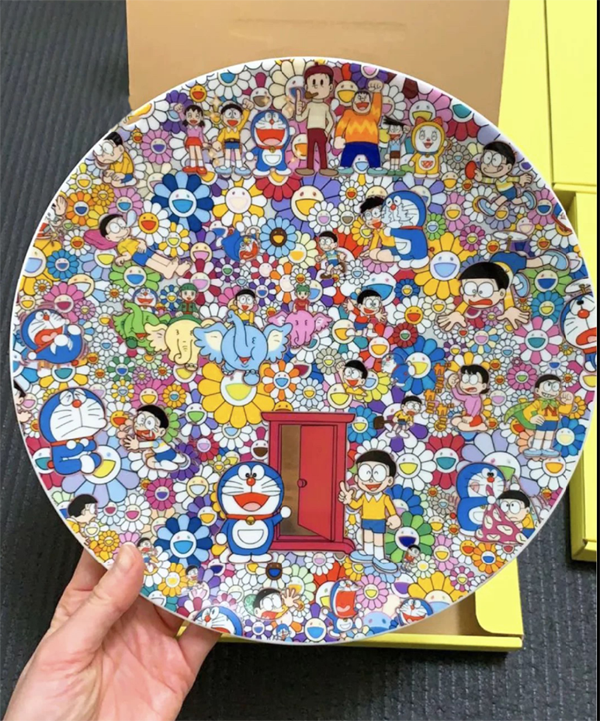
(image from artsy.net)
Naturally I checked to see if there was a Doraemon museum since Japan seems to have one for everything, and lo! There is a Doraemon museum a mere 30 minutes outside Tokyo. The museum is technically named the Fujiko Fujio Museum after Doraemon's creators. The displays run the gamut of original sketches and a recreation of Hiroshi Fujimoto's study to a life-size Anywhere Door.
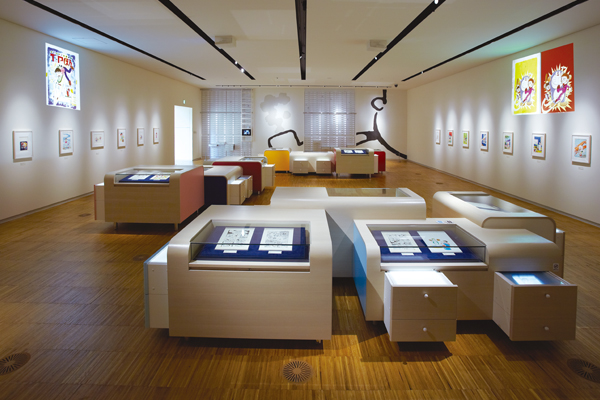
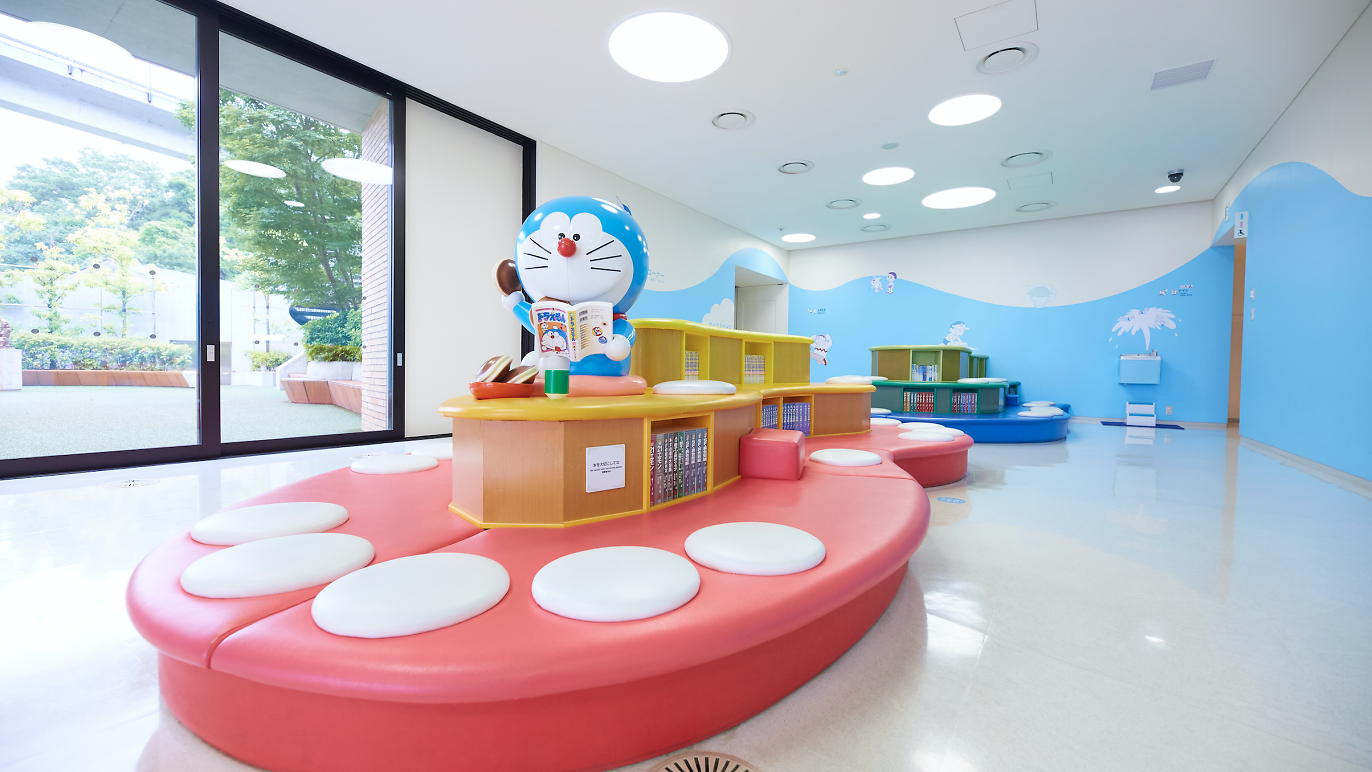
(images from fujiko-museum.com)
Speaking of collabs, if you think Paul & Joe's collection is the first makeup brand to feature Doraemon, you would be mistaken. In the fall of 2015 Korean brand A'Pieu unveiled a Doraemon collection. The Paul & Joe one is different not just in terms of packaging but in the product lineup. A'Pieu offered eyeshadow palettes, cushion compacts and lip gloss and also incorporated Doraemon's younger sister Dorami in the packaging.
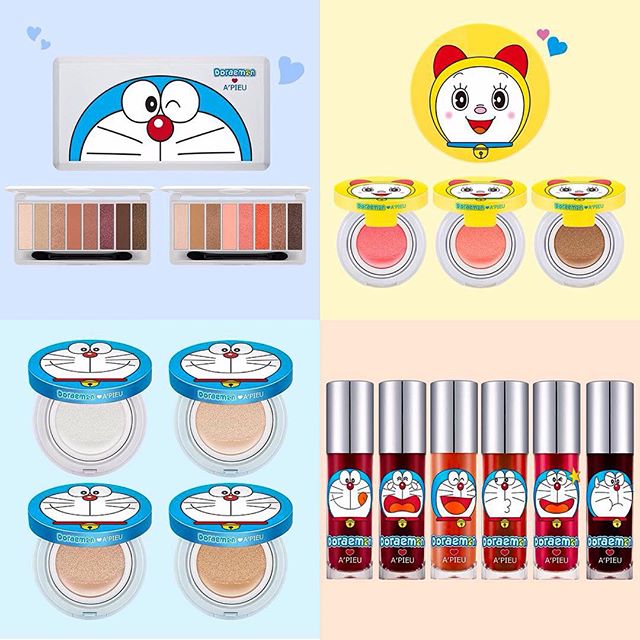
(image from rinesoo.wordpress.com)
To sum up, the Doraemon collection is absolutely on brand for Paul & Joe, given their previous dalliances in cartoon collaborations, the founder's love of cats, and the fact that Paul & Joe makeup is produced by Japanese company Albion. Still, I'd love to know more about how the partnership came about and why in 2019, as Doraemon's other "birthday" is 1970 when the manga made its official debut. In any case, it's adorable and I'm glad I was able to learn about an important Japanese cultural icon from this collection. And if you missed it, don't despair – word on the street is that a second Paul & Joe Doraemon collection is coming for the holidays. So maybe that will be more appropriate for the series' 50th birthday.
What do you think of this collection? Had you heard of Doraemon previously? I obviously had not! I watched a few clips from the TV series and while he's cute, he did not capture my heart the way another Japanese character did.
Not sure how I missed Mimi Choi's fantastic makeup optical illusions on Instagram, but I'm grateful to Jen of Coffee Sundays for introducing me a few months ago. One look in particular caught my eye: Choi's hilarious "twin", Knee-Knee.
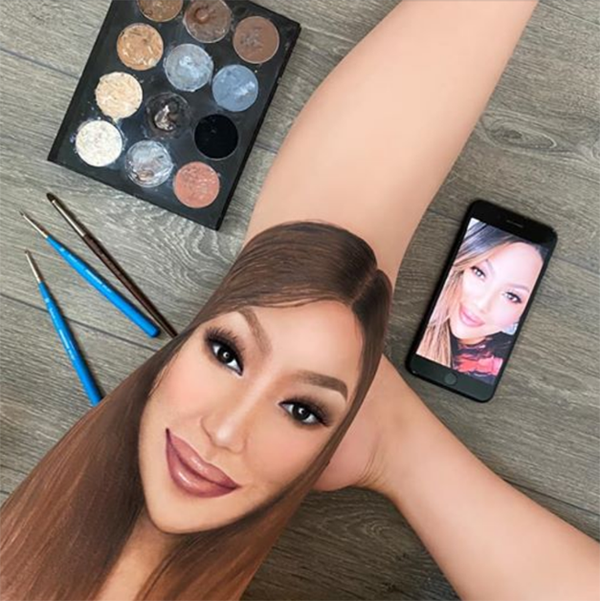
(image from @mimles)
And with that, I decided I had to find out the history of knee makeup in modern times.1 As usual this post will be heavily reliant on newspaper archives, sigh…I wish I could find more sources, especially since, as we'll see, newspapers are not always truthful. Anyway, knee makeup been around much longer than you would think. Flappers used rouge (blush) to decorate their knees, an are that was more exposed than ever despite the fact that hemlines were just below the knee (the '20s version of a miniskirt). They'd either roll their stockings down or (gasp!) forgo stockings altogether – made it much easier to do the Charleston. Adding some blush further drew attention to the knees, emphasizing the rebellious nature of the new fashion. Side note: I'm dying to figure out the shift from the word "rouge" to "blush". I'm old and even when I was a kid I remember cheek color always being referred to as blush. I wonder how and why mainstream makeup vocabulary changed. But that's a project for another day.
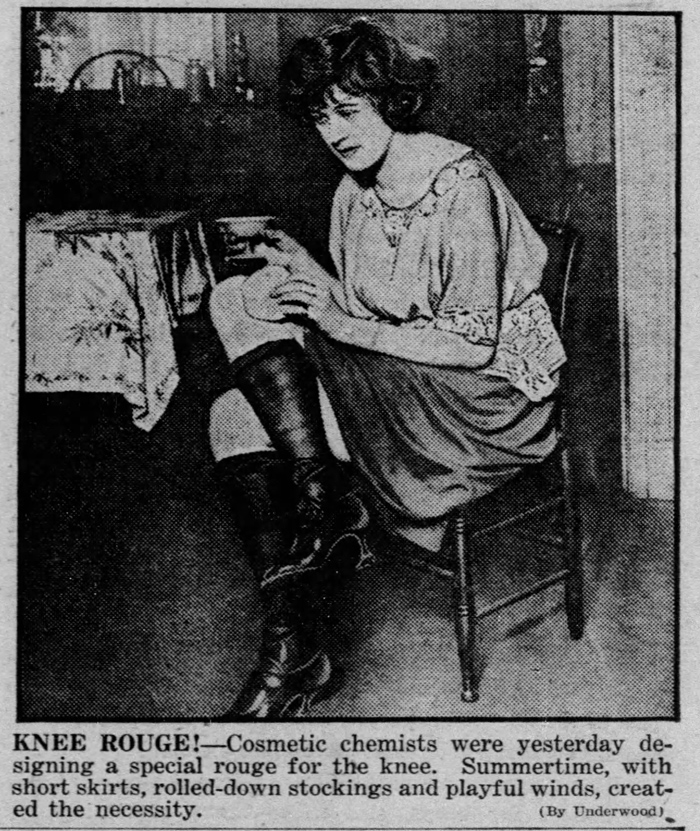
Knee rouging became full-on knee painting by the mid-1920s, although it had been reported in Paris in 1920. Unlike knee rouge, it doesn't seem as though makeup was actually used – at least one article discusses regular oil paints and another mentions watercolor – but the average woman as well as traditional artists engaged in the practice. The designs ranged from incredibly detailed portraits and landscapes to simple flowers and butterflies.
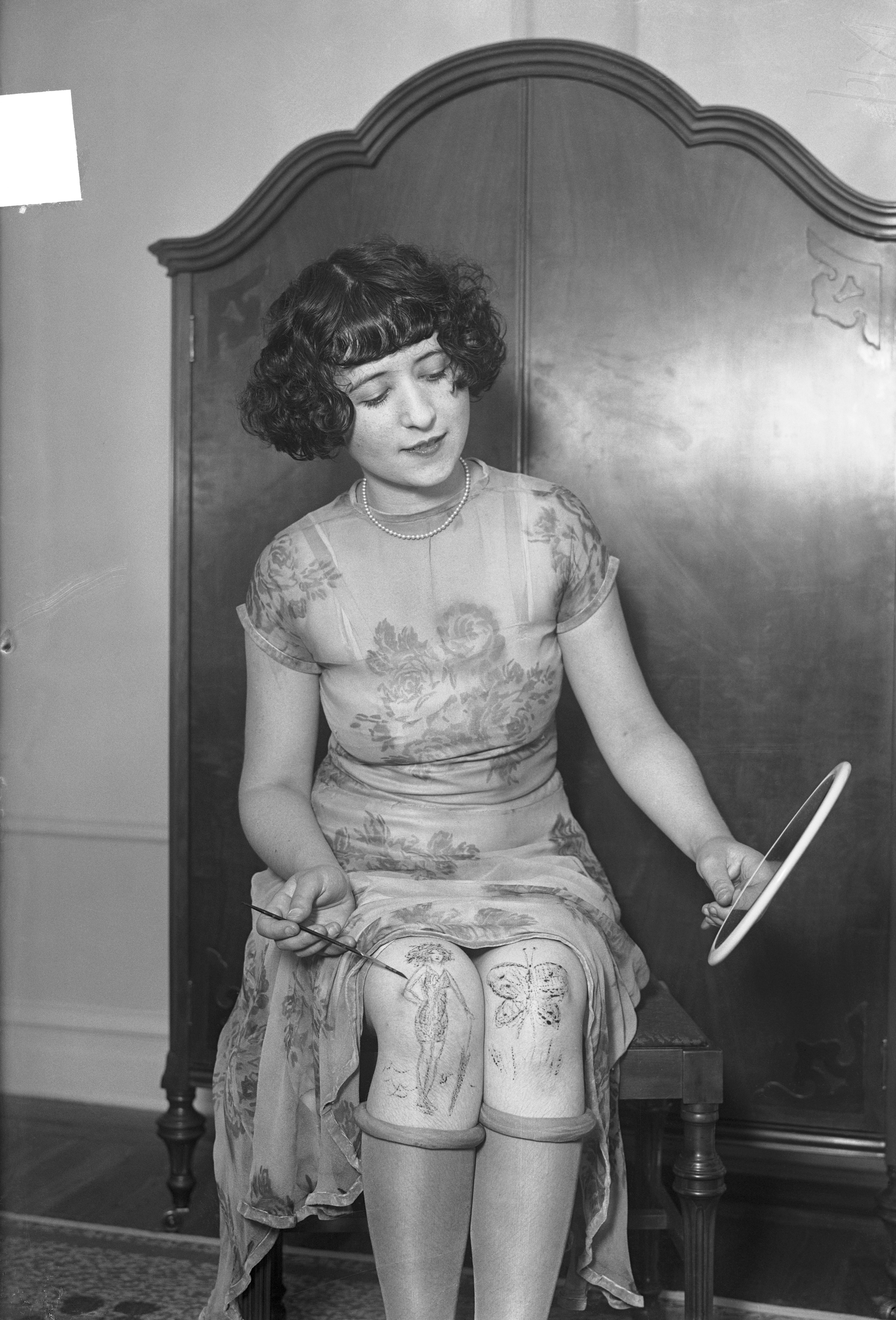
(image from livingly.com)
One could argue that knee painting was a good way to pique the interest of boys. Teenage girls would paint the initials of their boyfriends or desired boyfriends, while one woman, who wasn't keen on the idea of carrying a portrait of her fiance in a locket, had his likeness painted on her knee instead.
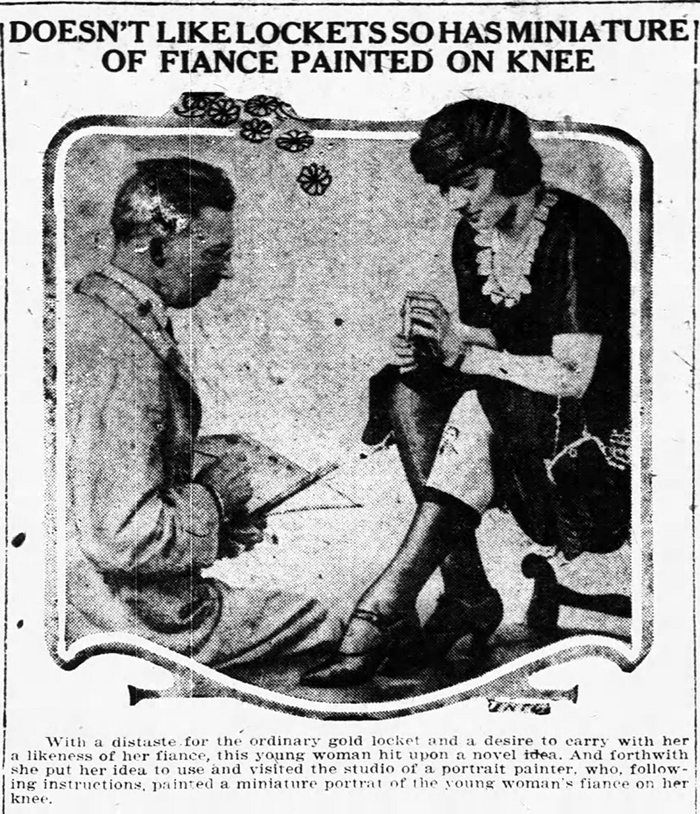
But like regular knee rouging, it was also a demonstration of creativity, provocation and rebellion, which led to either encouraging men to further sexualize women's bodies or a total backlash against the practice. "And, my, here comes a beauty; I watch as it walks by – a painting like that always seems to catch my eye. As one sees a comely miss with both knee-caps ablaze, studying art becomes a treat to all of us these days," a 1925 poem reads. One housewife by the name of Clarice Wilson, well aware of her husband's hatred for the new dogs she recently acquired, painted them on her knees for a passive-aggressive dig. Her husband, Arthur X. Wilson, retaliated by painting the likenesses of two of the most attractive women in town on his own knees. While adult women may have been mildly shamed for knee art, teenagers were soundly punished. Seventeen-year-old Mary Bell was spanked by both of her parents for painting Clarence Darrow and a portrait of a monkey on her kneecaps and a high school basketball team (from Baltimore!) was nearly expelled for showing school spirit via knee painting. (Click to enlarge.)
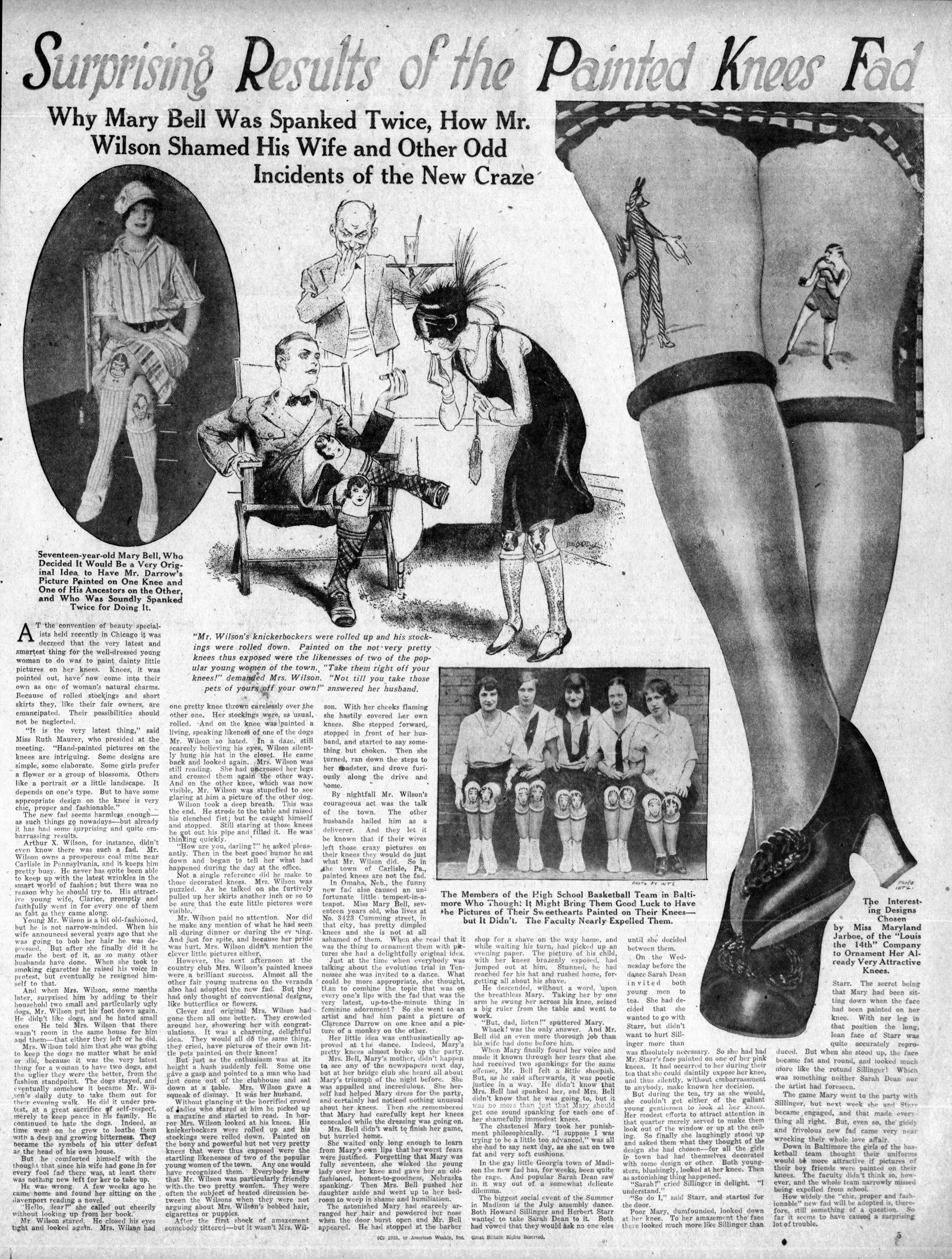
Between the 1920s and 1960s there was scant mention of knee makeup. Besides a couple of 1939 articles and a nostalgic look back in 1957, knee makeup simply wasn't on the radar.
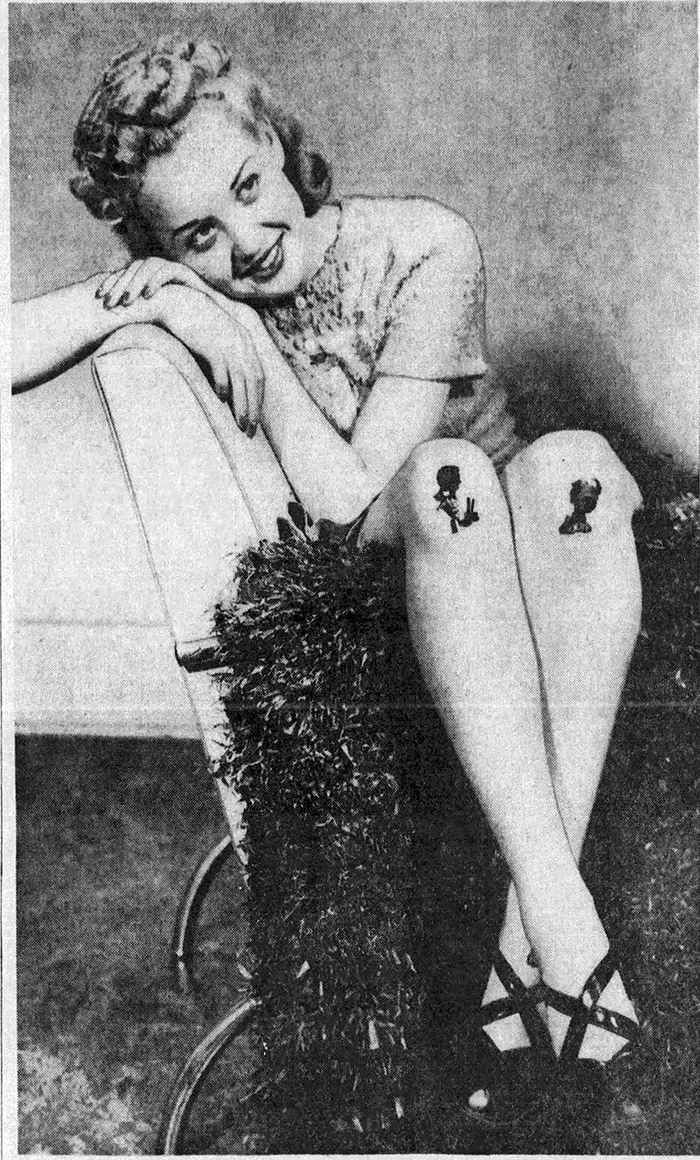
Yes, I shamelessly stole the title of my post from this article.
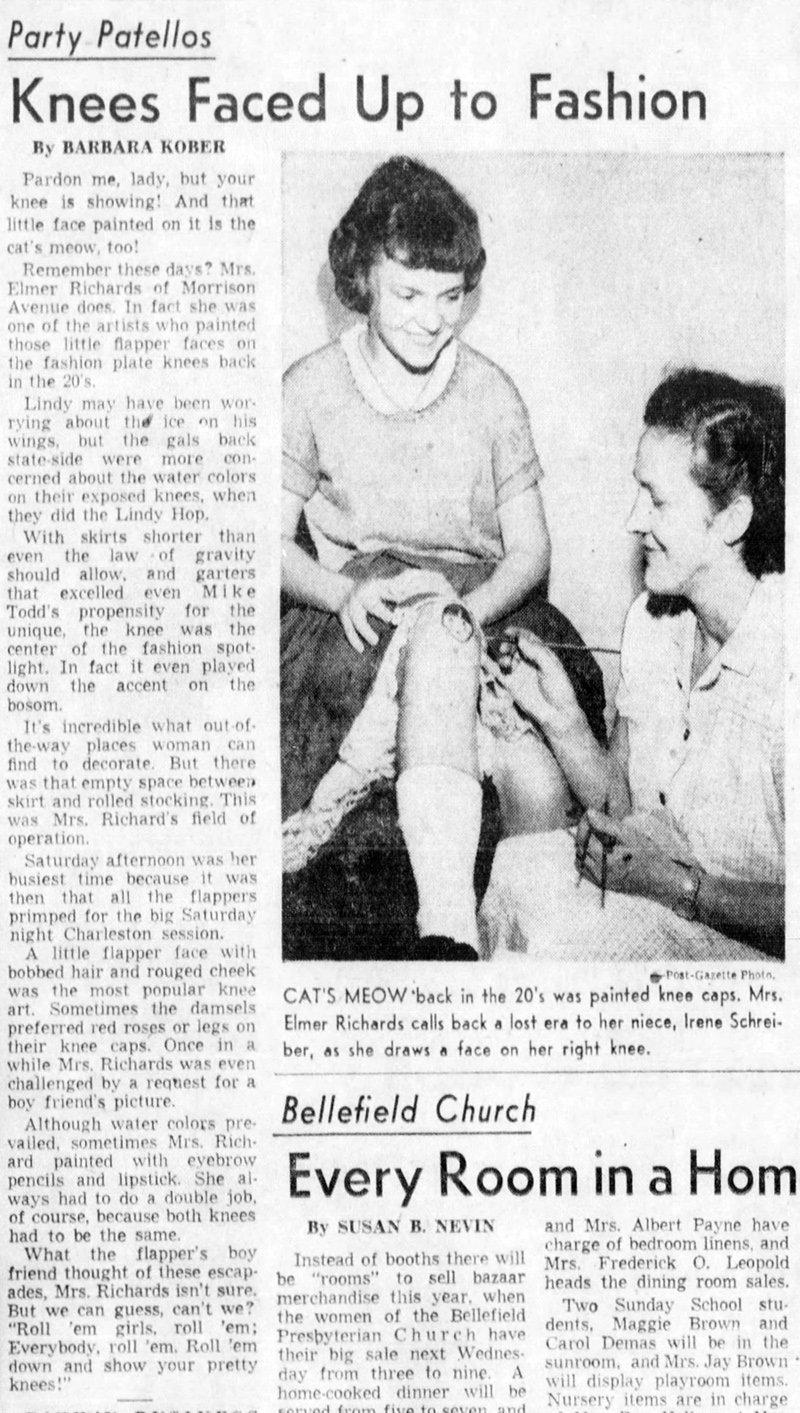
But the craze for knee painting returned with a vengeance in the '60s, albeit with a slightly different flavor. Makeup artists were now finally starting to be considered "real" artists on par with traditional painters, which is reflected in their leading the way for knee makeup and the use of cosmetics rather than oil paint or watercolor applied by a regular artist. Possibly the first documented instance of knee makeup from an actual makeup artist came from William Loew, makeup director for Charles of the Ritz. In late February 1965 he painted a pair of eyes on a model's knees for a party. Touted as the "latest in pop-op beauty" and inspired by the emerging pop and optical illusion art of the time, Loew declared the pop-op movement in fashion and beauty as a step forward for women's freedom from relying solely on her looks for success. I can't help but wonder if Loew had somehow stumbled across the knee art displayed during the 1920s. In any case, I'd kill to see his work in color!
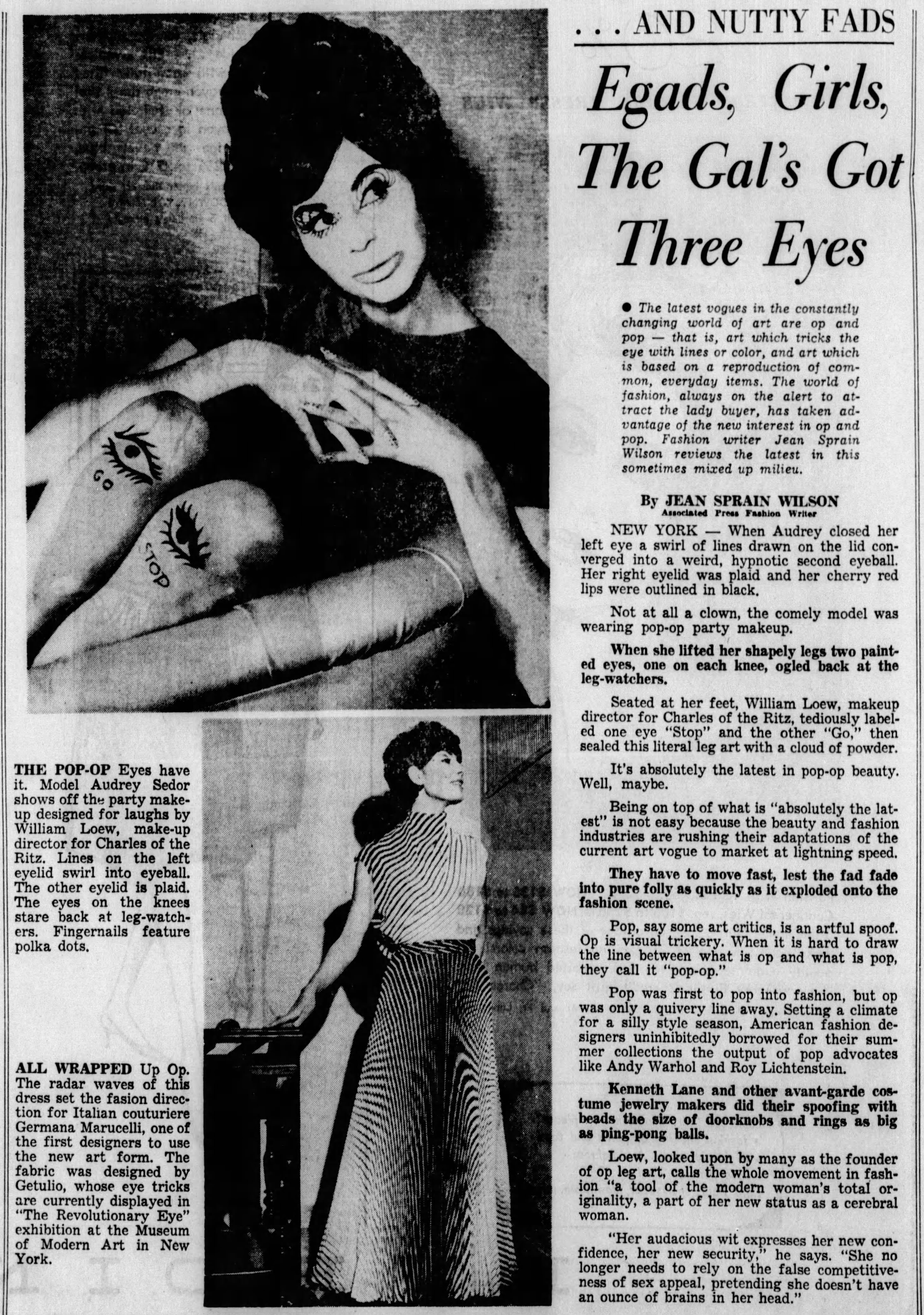
By the summer of 1965 the fad had trickled down to the masses. A suburban Pittsburgh housewife and representative for Vivianne Woodard cosmetics, Mary Metzler, took responsibility for creating the look in May 1965, admitting that she devised the idea mostly to sell more cosmetics. Over the next year the trend grew, despite Loew himself claiming it was over by late 1966. Prior to his statement, by the summer of 1966 the big makeup brands were releasing leg and knee makeup kits, with the notable exception of Elizabeth Arden, whose "face designer" Pablo "refused to have anything to do with [knee makeup]".3 Estée Lauder introduced a fairly regular line with makeup, contouring powder and highlighter, but also offered an art kit complete with stick-on jeweled beauty spots (mouches).
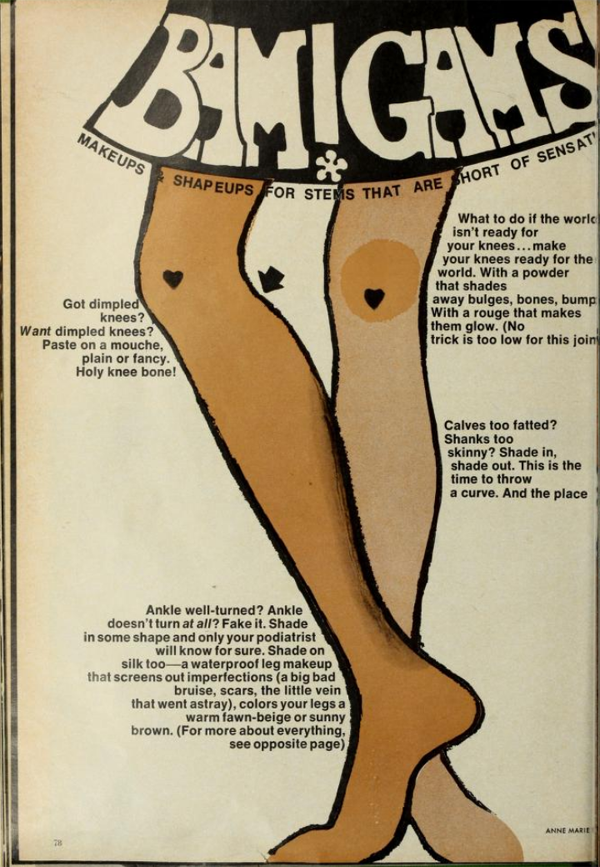
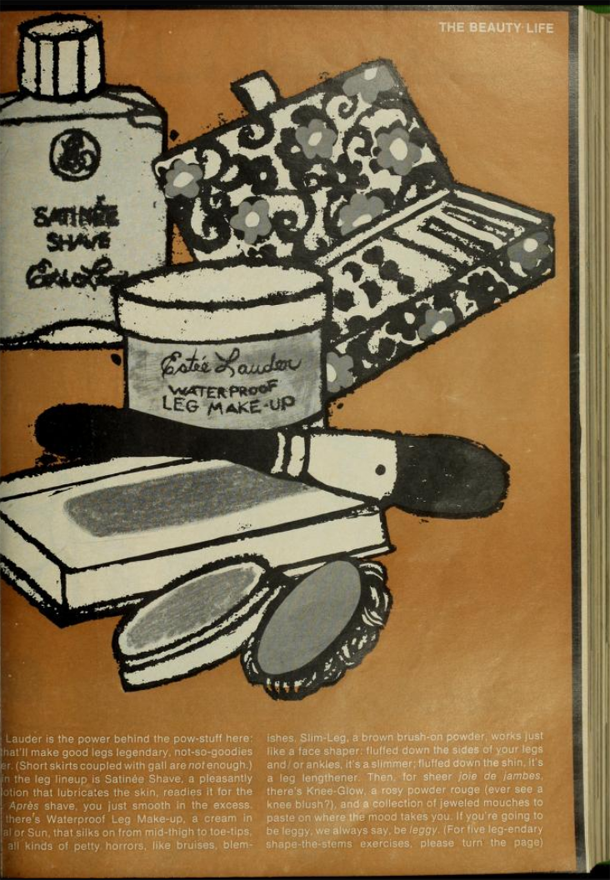 (images from archive.org)
(images from archive.org)
Fabergé had their makeup director, Evan Richardson, create their "Kneesies" kit, which contained red, blue and yellow paints.
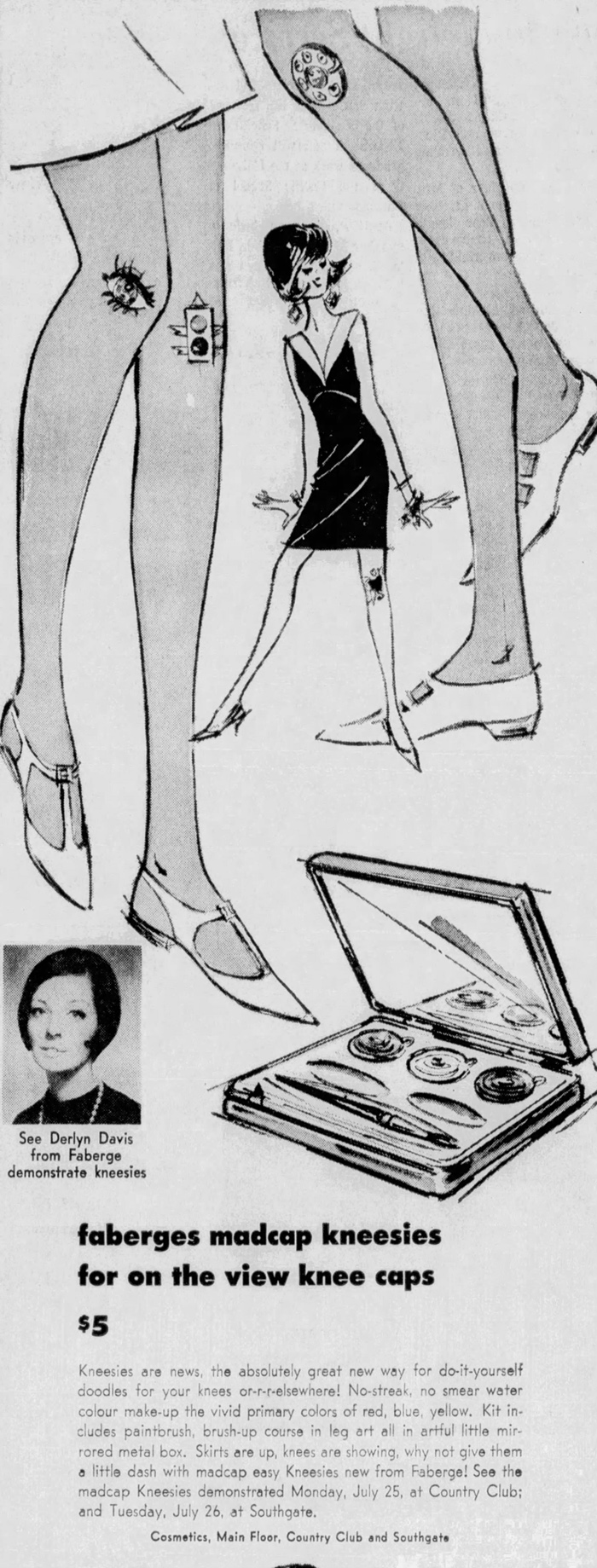
Revlon Ultima II's cleverly named Stemwear collection included both a "leg complexion" kit for those who desired basic coverage (hiding bruises and other imperfections) as well as a Leg Art kit with four colors that could be mixed: Chalk White, Chrome Yellow, Chinese Red, and Marine Blue, that came packaged in an artist's palette.

The company also enlisted fashion illustrator Joe Eula to create custom designs, which were featured in the May 20, 1966 issue of Life magazine along with the July 1966 issue of Harper's Bazaar.
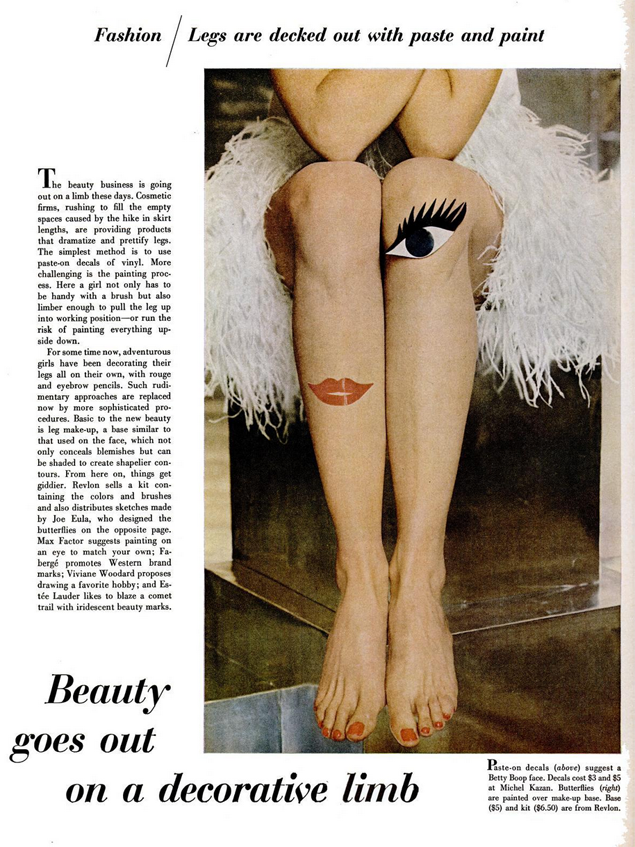
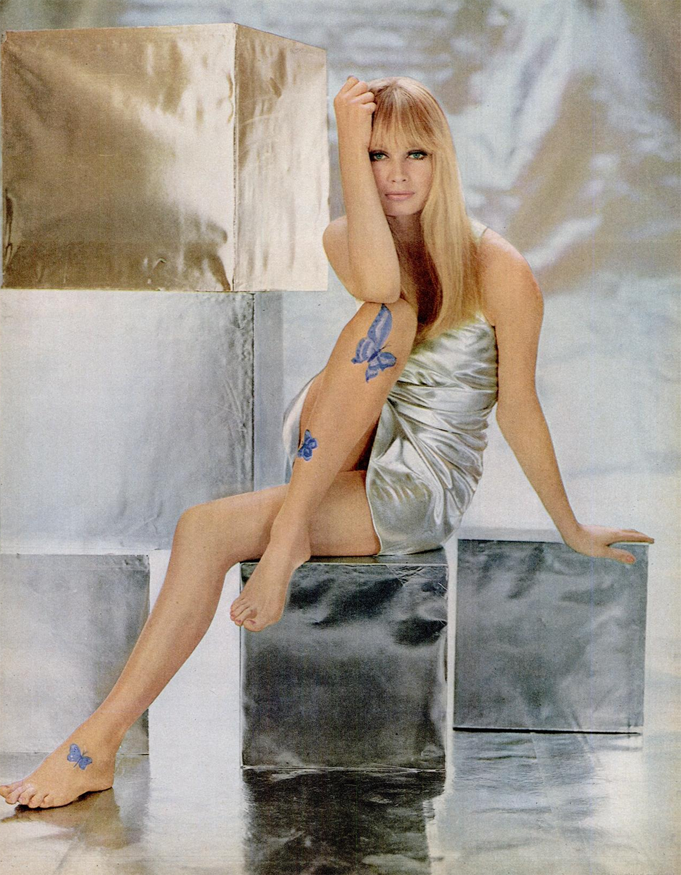
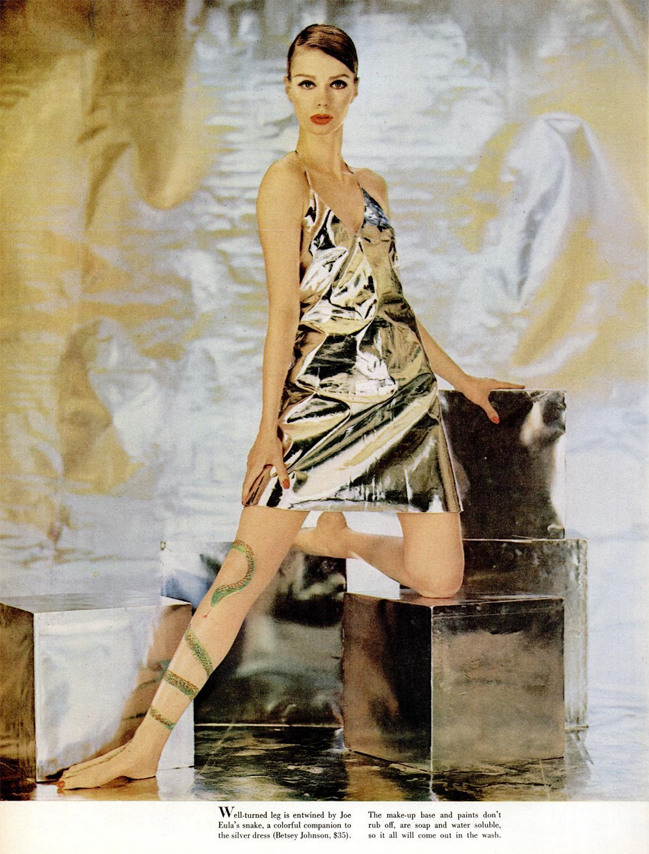 (image from books.google.com)
(image from books.google.com)
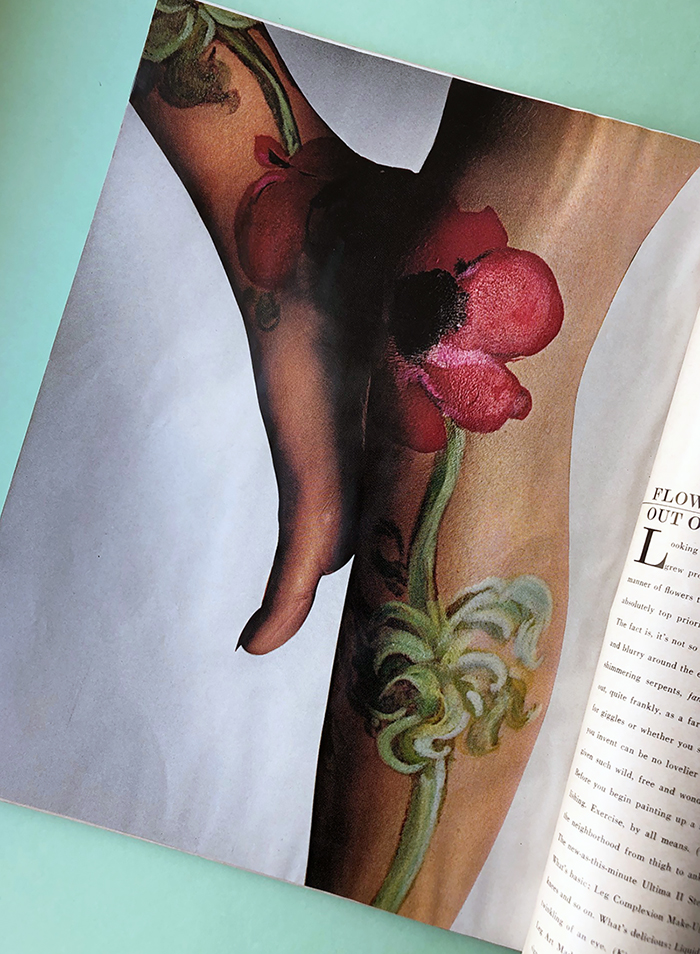
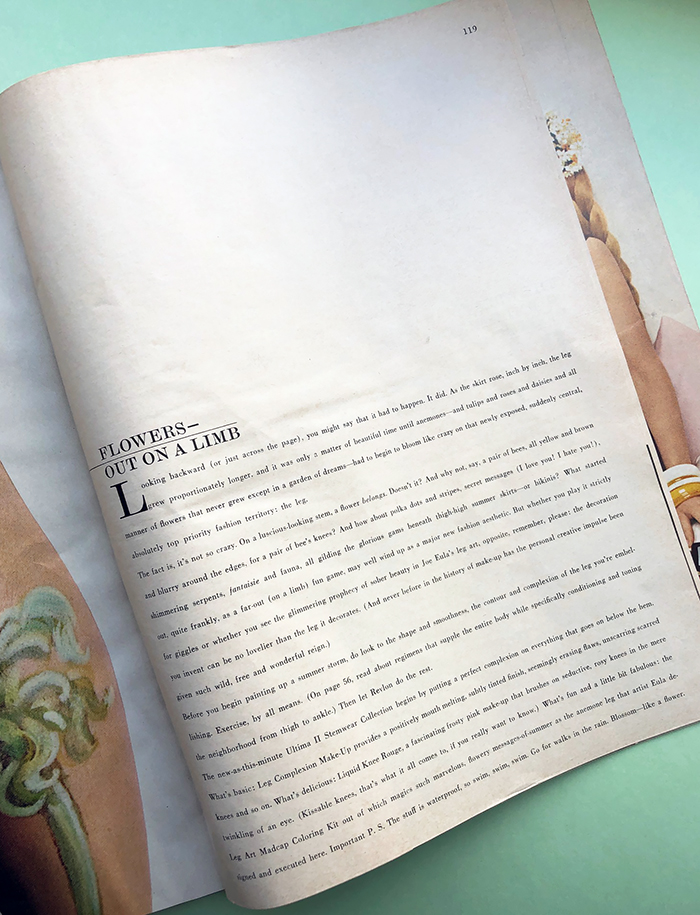
While Revlon's kit was reported to be the first leg makeup kit on the market, in July 1967 one reader of the Mercury newspaper remarked that Mary Quant, widely considered the inventor of the miniskirt, had come up with the concept of body paint first, and an indelible one at that (along with "freckle paint," which reminds me that my article on faux freckles is in dire need of updating). While I couldn't find any proof whatsoever, I have a very strong feeling that Mary Quant probably offered a fun leg makeup kit.
Anyway, as it had the previous year, knee makeup soon made its way from fashion magazines to your garden-variety middle-class teens.
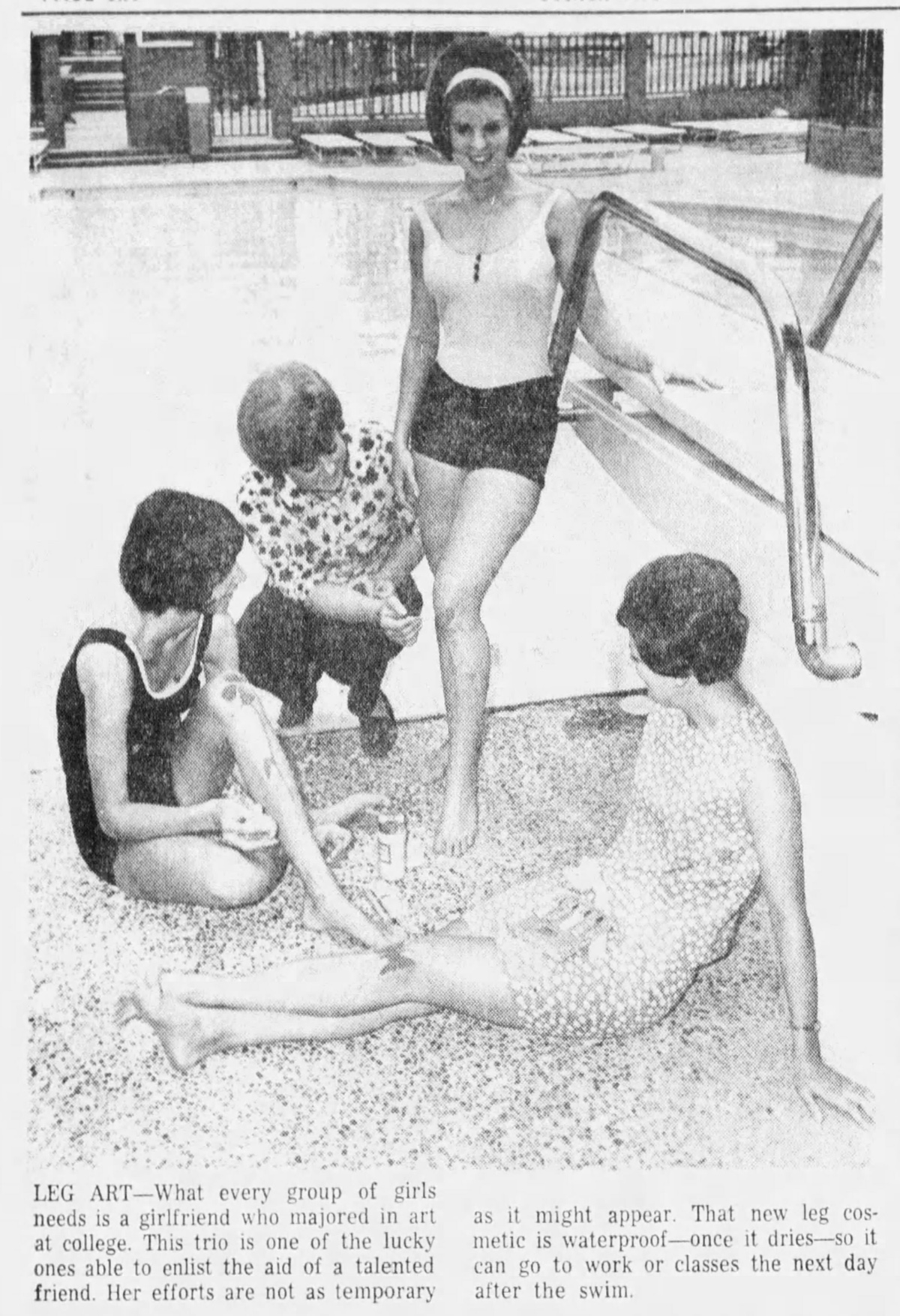
Glad to see these girls were not thrown out of school or spanked by their parents.
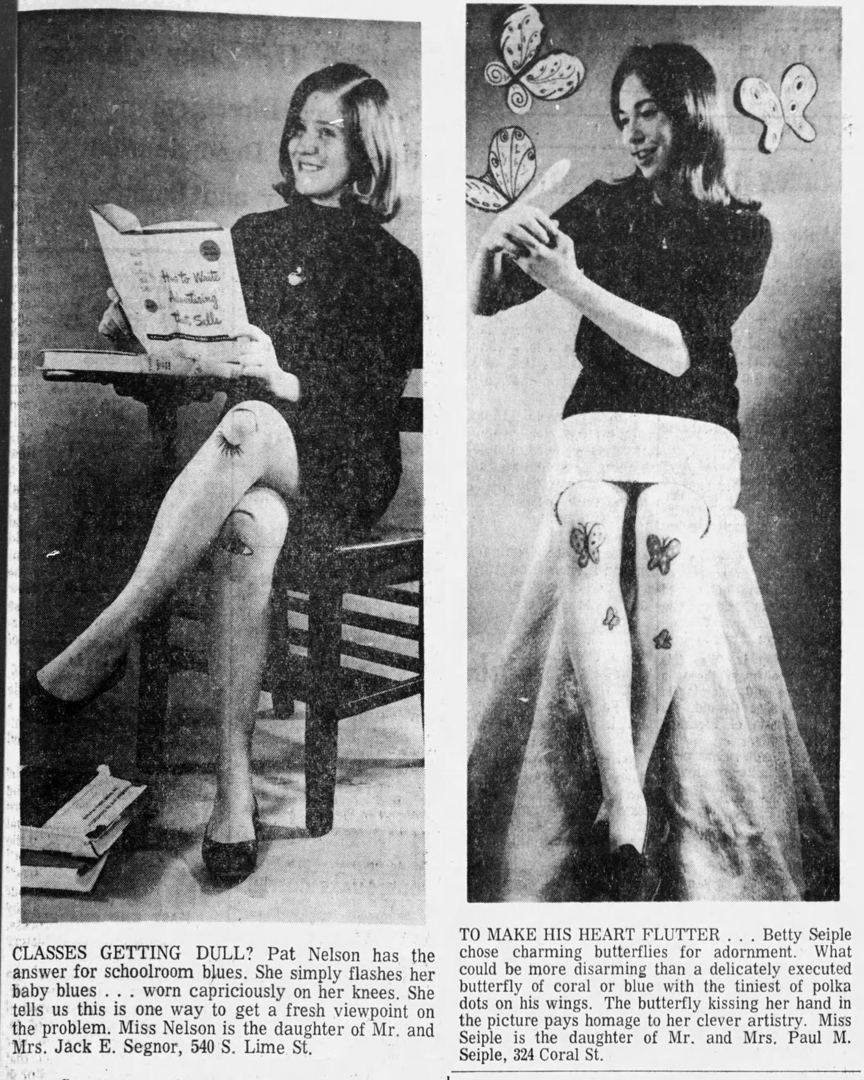
Knee makeup art morphed into painting the entire leg by the summer of 1967, with Coty and Givenchy both releasing leg paint kits in shades meant to mimic colorful stockings.
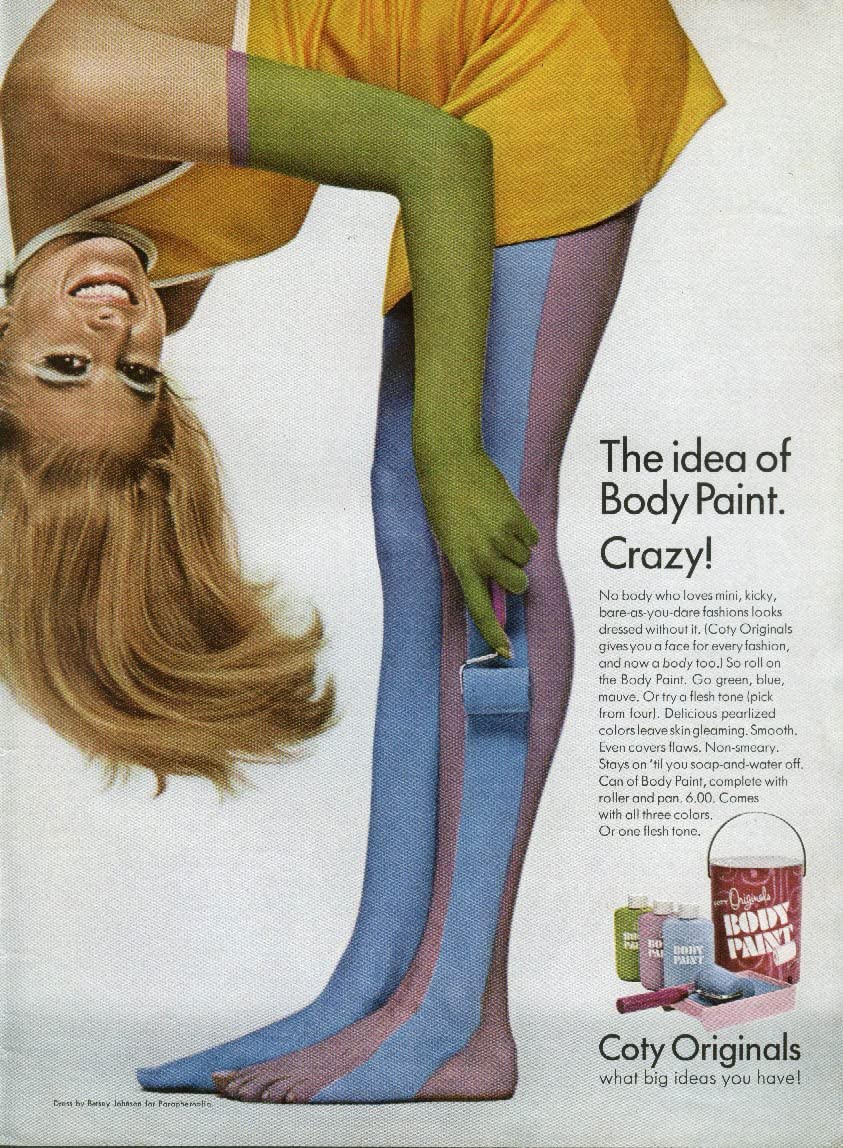
(image from amazon)
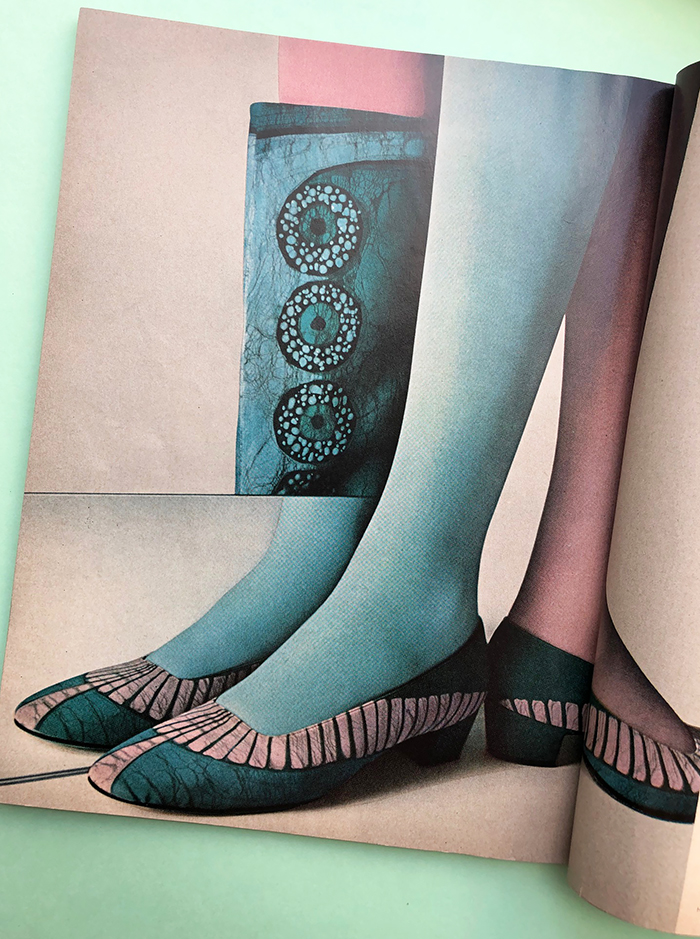
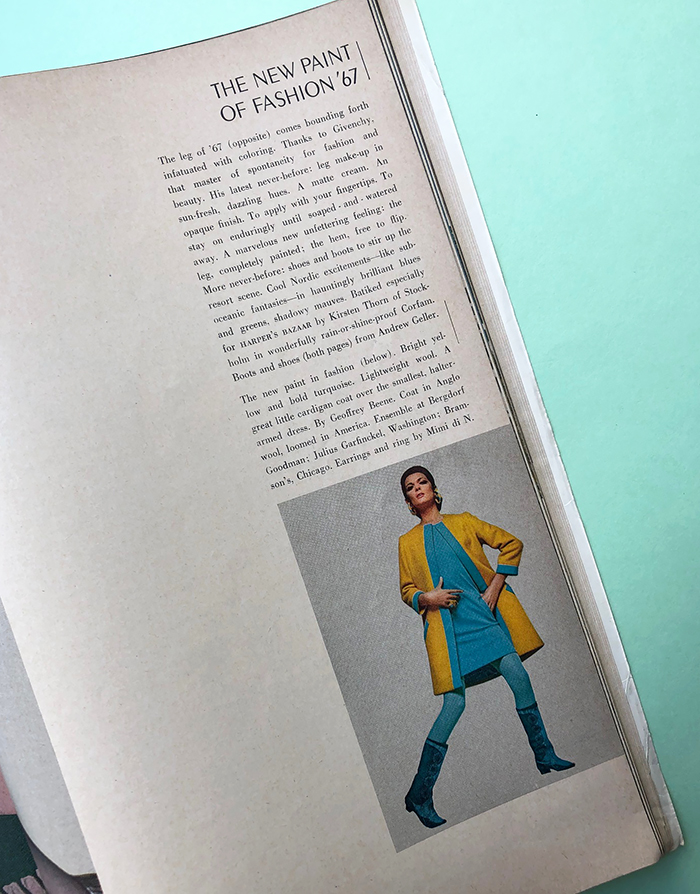
And everyone remembers the body painting popularized by hippies and mainstream shows like Laugh-In. In 1968 Tussy released a Hieroglyphics paint kit meant to be used all over the body. However, this is getting a bit off track and an entire book could be written about body paint, so I'm not going to go further with the concept now. Suffice it to say that knee makeup hit its peak in 1966 and had mostly fallen out of favor in the '70s through, well, now, partially due to the fact that pants were becoming more acceptable for women's wear. Maxi skirts and bell-bottoms took over around 1970 and lasted through the decade, while trousers became equally popular to skirts and dresses in the '80s and '90s. If body makeup were to be used artistically, all-over body paint took the place of knee makeup over time. And that's the reason Mimi Choi's art got my attention – it's rare nowadays to see only one specific part of the body adorned with makeup.
While most of the knee makeup was predicated on the ideas of creativity and self-expression, the notion of attracting boys or painting a boyfriend's name or initials was frequently noted. Girls painted "available" and "need a date?" onto their kneecaps, while Metzler, self-proclaimed inventor of the trend, "It gives [girls] something to do at the beach, but most important it's the kind of gimmick that helps them attract boys. That, after all, is the primary purpose of most cosmetics." Yikes.
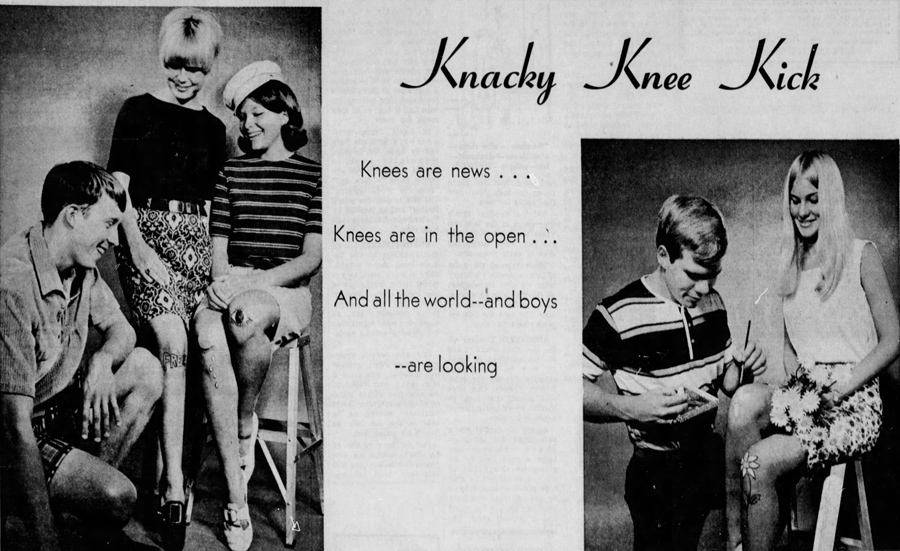
Then as in the 1920s, one of the reasons for knee makeup was presumably to attract guys or express one's affection for their beau, although I don't believe it was the main reason. I tend to think it was more about having fun and allow oneself to be a bit more daring than with face makeup, since the knees, despite being on display, are not as immediately noticeable as the face. As Harper's Bazaar noted, "Never before in the history of makeup has the personal creative impulse been given such wild, free and wonderful reign."
So why did knee makeup trend in the 1920s and 1960s? Some factors for these two very different decades overlap. First, knee makeup in both eras was primarily fashion-driven.2 Leg makeup were ostensibly the result of new, seemingly shocking clothing styles for women, an example of the direct influence of fashion on makeup. Freed from the burden of stockings, either by rolling them down or skipping them entirely, 1920s women realized there was room to decorate this newly acquired space. And the latest miniskirt styles in the mid-1960s placed a bigger spotlight than ever on legs, with Harper's Bazaar declaring 1966 to be "the year of the leg".
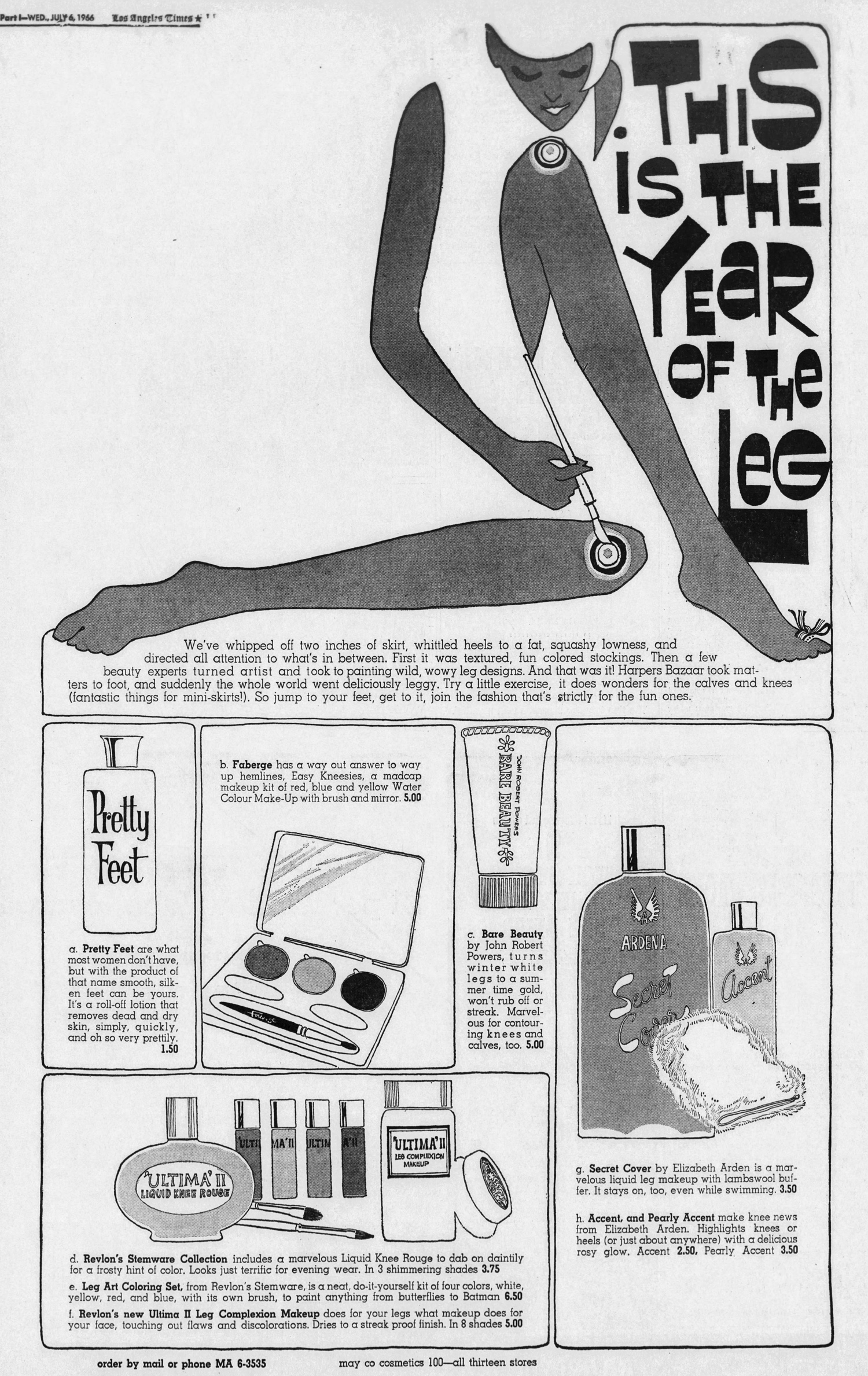
I acknowledge makeup doesn't exist in a vacuum and that there is a definitive link between cosmetics and clothing, but generally I don't think fashion affects makeup trends as much as we think. Having said that, knee makeup seems to be a clear case of fashion dictating makeup.
The other factor at play for the knee makeup fad peaking in the 1920s and 1960s besides leg exposure in and of itself was a celebration of freedom from both an expectation of modesty and clothing that restricted movement. Not coincidentally, (White) women's rights gained significant ground in both eras, and perhaps knee painting was a byproduct of women's social advancement. As fashion historian and writer Marlen Komar points out, "Whether it was the '20s or '60s, women turned to knee painting to not only flex their creativity and have a bit of fun, but also to assert their autonomy, own their sexuality, and label themselves as a new generation of modern women. Makeup bags are often more political than we give them credit for." I'm inclined to agree for the most part. Miniskirts may not have been as liberating as history makes them out to be as they were originally intended only for the younger crowd and women today continue to get blamed for sexual assault for wearing too short a skirt, but by and large shorter silhouettes were revolutionary. Knee makeup, along with shorter hems, could be viewed as another way women were enjoying their newfound freedom.
Of course, precisely because of the rebellious and assertive nature of knee art, there were detractors in both decades as well. The loudest were those who harped on the ugliness of the knee. While fashion designers hiked up hems in the name of emancipation during the '60s, others simultaneously (and hypocritically) discussed the need to make knees less offensive via makeup rather than demanding skirts and dresses get back to a lower length. Or, you know, making pants acceptable or just letting women show their legs without feeling pressured to prettify them with makeup. Knees were apparently hideous, which is exactly why any woman donning a miniskirt was automatically declared brave. (Sort of like how we talk about celebrities going bare-faced in public now.) As Gil, makeup director for Max Factor noted in 1966, "Exposing the knee is the most daring thing a woman can do. After all, let's be clear about it. The knob is terribly ugly." Says one columnist: "One cannot help wondering why this usually rather ugly thing must at all costs be displayed. But it is never worthwhile to try to figure out fashion." Another article's headline sums it up thusly: "Glorifying the Ugly: Knees Take on Decorative Look". And going back to 1925, critics claimed that not even painting could help offset the visual offensiveness of the knee. In their view, knee art was a dubious endeavor or an entirely lost cause. "Must be quite a task to make the old joints look attractive…I don't believe that painting the knees will help them any. It would take more than paint to make the average knee worth looking at."
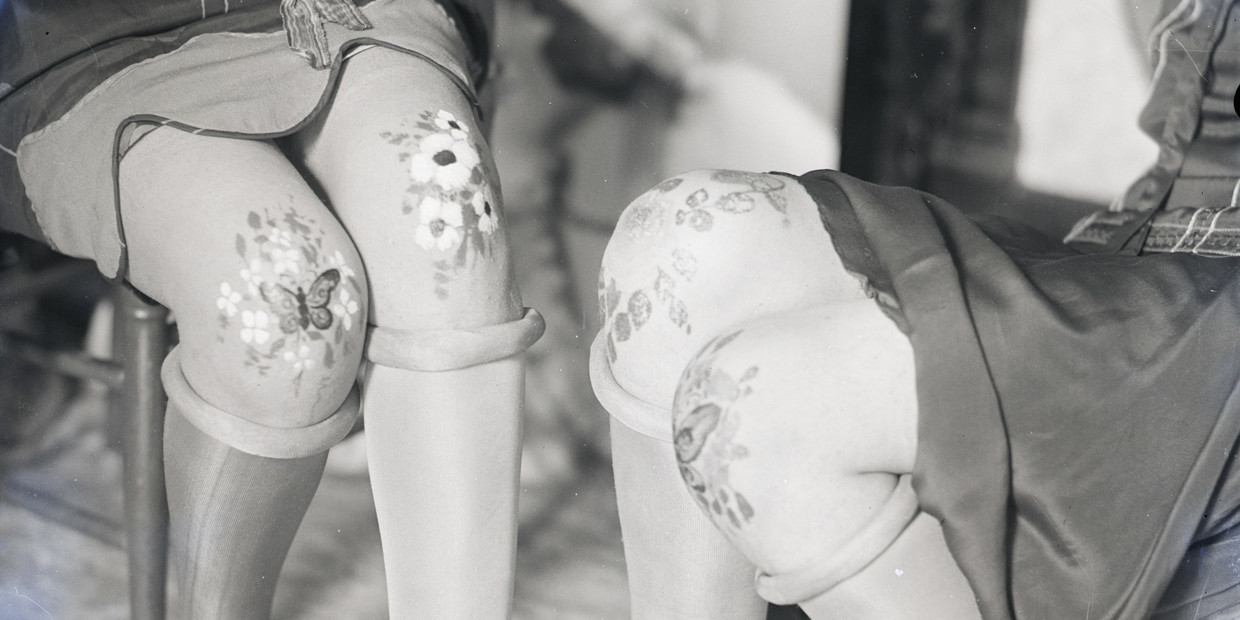 (image from livingly.com)
(image from livingly.com)
Naturally, random men had to make their opposition heard too. One Charles Denton wrote in a 1966 opinion column for the San Francisco Examiner, "Having discerned that the knee has all the esthetic charm of a pickled pig's foot, did the style setters lower the skirt back over it? (With a thigh?) They did not! Instead they started concocting cosmetics to glamorize it. Which is about as logical as shaving your beard and then putting on a phony beard…I hardly need to tell you guys where this trend is leading. Because aside from adding to the upkeep on your favorite dame, not to mention your wife, this places yet another strain on the male psyche…the next time you're pacing the floor waiting for her to get ready to go out and you holler, 'What's taking you so long?' she'll chirp back, 'Just a few more minutes, I'm doing my knees.'" Oh, poor delicate Charles with your already fragile "male psyche"! He was not concerned about the expectation that women must attempt to make their legs look more attractive given the new short styles in addition to their normal beauty regimen, but that the extra time required for them to complete their makeup routine may inconvenience him. STFU, Charles. No one asked you.
The other thing the trend had in common in 1920s and 1960s was that it's unclear how many women actually adopted it. As the very wise author of Cosmetics and Skin told me, "One swallow does not make a spring." Despite the wealth of magazine articles in the '60s and the newspaper articles in both decades, I have a feeling it was akin to Instagram (or Tiktok, shudder) "trends" where one makeup artist or influencer does something crazy and it goes viral. All the news outlets latch onto it and declare it a trend, when it fact only a handful of people tried it or even just the one person who started it. I suspect the same thing happened with knee makeup. It may have been fun at the occasional teenage party, but by and large I doubt many women were actually wearing it, at least not regularly. "This so-called painted knee fad seems to be one of those things everybody knows all about but nobody's ever seen," was a common quip in 1925. Dovetailing on the idea of backlash, one columnist by the name of Cynthia Grey stated that it was actually men who were trying to popularize knee makeup by putting it on every front page in order to make women look stupid. "It's funny how seriously men take freak styles and how ready they are to believe that women are morons…apparently for women to paint their knee is as important as a revolution in China or a monkey trial. The implication is, of course, what fools we women are!" Additionally, the spat between the Wilsons in the article shown earlier apparently never happened, because no one by the name of Arthur X. Wilson near Carlisle, PA existed.
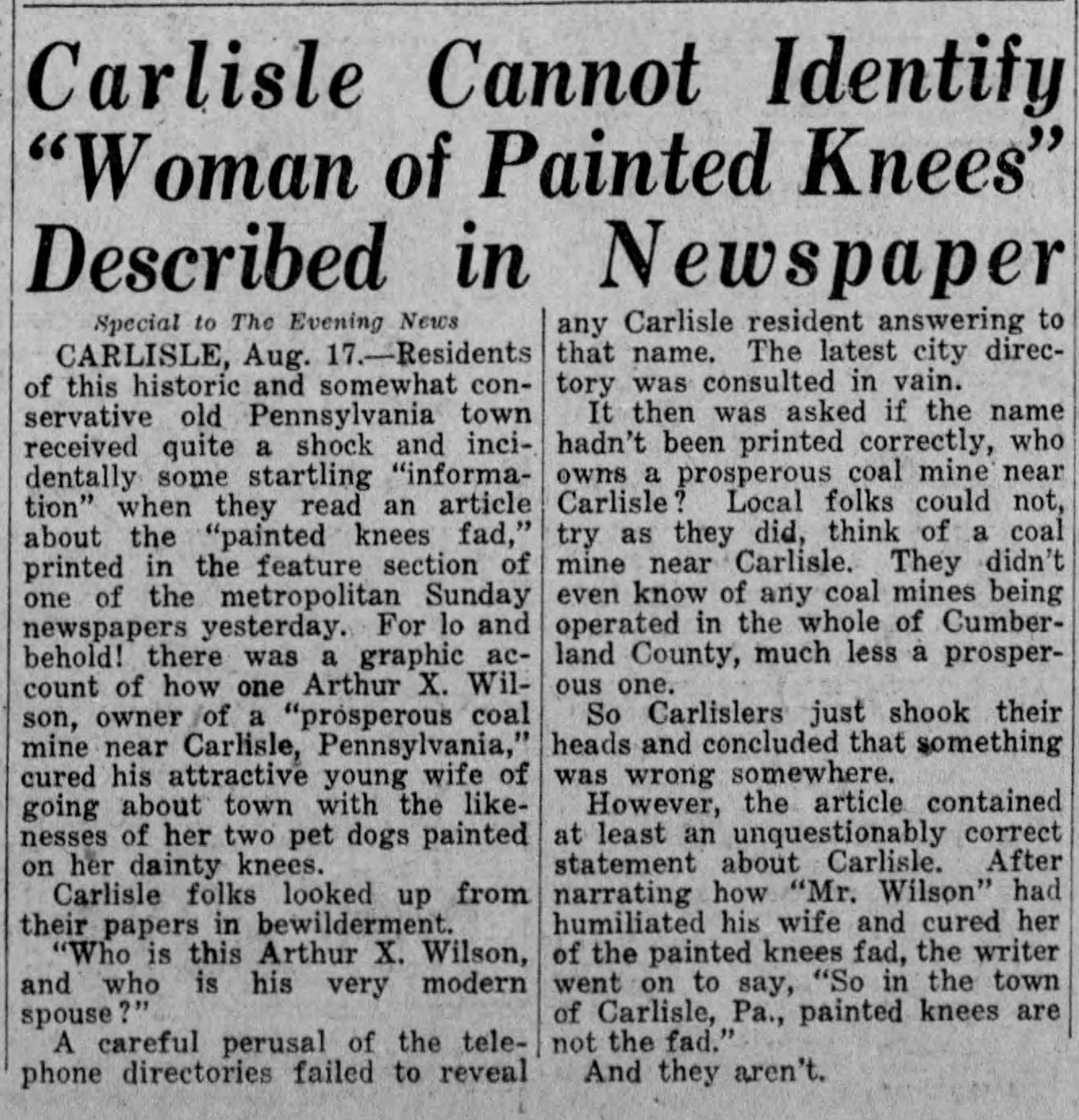
It was a work of total fiction that also demonstrates the hostility towards the trend and men's need to keep women in their place. The feature included two somewhat true accounts4 of girls being punished for knee makeup (although now I have my doubts about the basketball team from Baltimore) but also felt it necessary to come up with a third example that was a complete fantasy, just to "prove" how idiotic women were for adopting the trend. As for the how widespread it was in the '60s, I asked my mom, who was 21 at the peak of knee makeup in 1966 and she had absolutely no recollection of seeing it in the news, let alone in real life. I understand that's purely anecdotal, but it goes to show that even young, stylish and progressive women – the key demographic – weren't necessarily adopting knee makeup. I'm also thinking some of the newspaper coverage of the trend in the '60s may have been the suggestion of editors who needed a fun story for a slow summer news day rather than teens picking it up of their own accord. (Click to enlarge.)
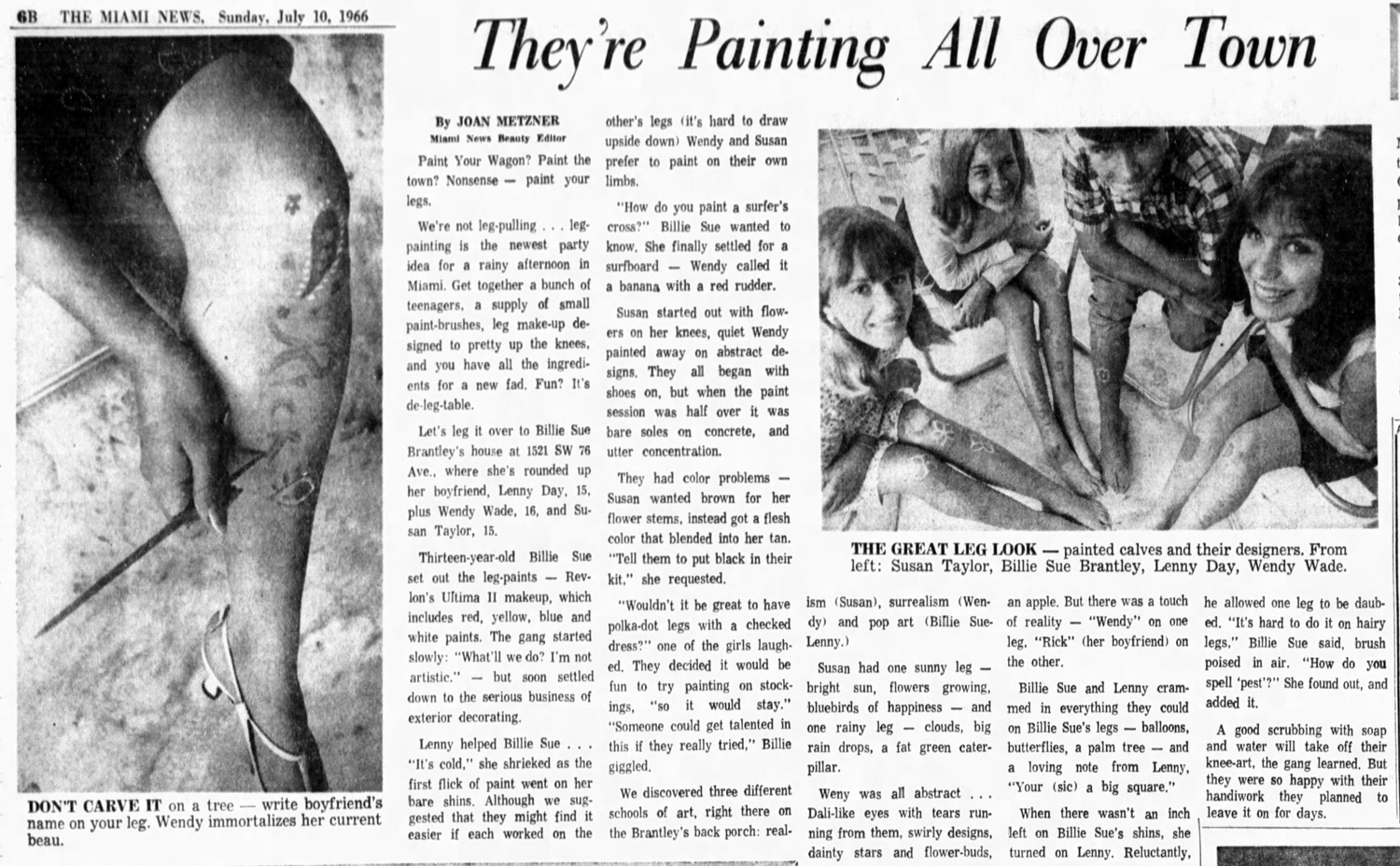
Finally, the fact that I've never seen any of these kits for sale or even an actual photo, only illustrations, suggests that knee makeup was not widely used.
Anyway, while knee makeup may have had a moment in the '20s and '60s, there were differences between two decades. In the 1920s, knee rouge and painting was associated primarily with flappers and other rebellious young women. In the 1960s, knee makeup did express freedom and was intended for youngsters, but it was less about mimicking or assimilating a particular group. While some fashion observers claimed that knee makeup was mostly the domain of mods, its appeal seemed to be more widespread, reaching those who simply saw it as a fun activity rather than allegiance to a certain style or outlook. Swim parties, summer camps, 4th of July were all occasions where friends could paint each other's knees – again, at least according to the local newspapers.
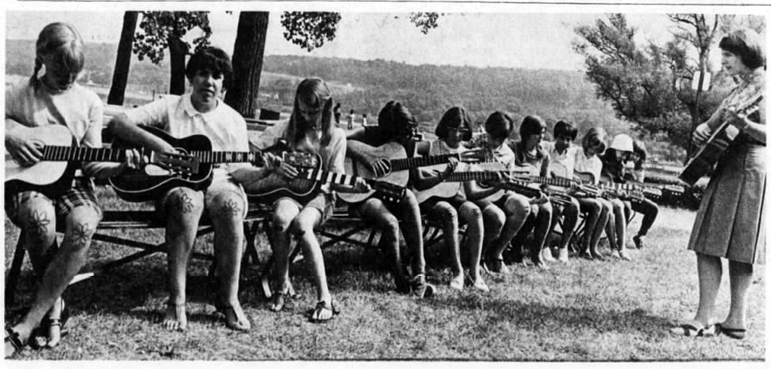
Plus, while most are accustomed to applying makeup on their face, painting one's knees is trickier as you have to paint upside down. Many articles noted that it was best to use the buddy system to ensure the design came out right. In this way knee makeup helped build camaraderie in a slightly different way than regular makeup play dates. In the 1920s it seemed that a lot of knee painting was done by traditional artists. Some salons were flooded for knee painting requests and felt as though the only option was to hire an outside artist on to meet the demand, so girls like Mary Bell and salon employee Mrs. Richards may have been exceptions. The shift during the '60s from hiring a painter to either a makeup artist, DIY or having a friend do the painting switched up the dynamic, as evidenced in these photos.
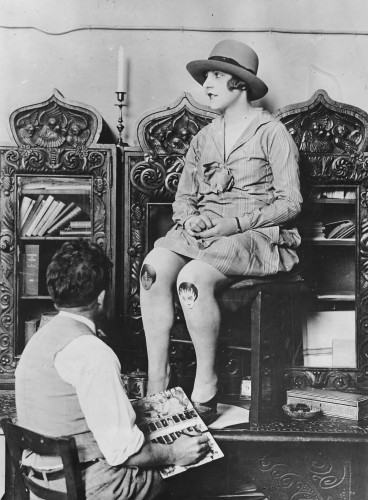
(image from marymiley.wordpress.com)
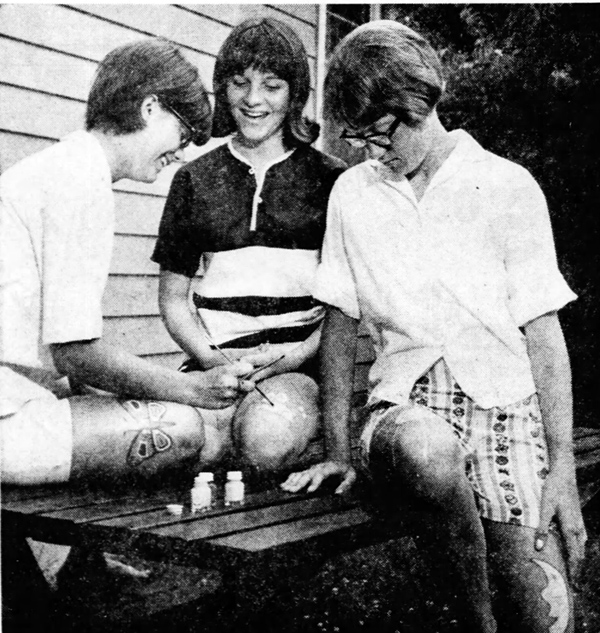
Another difference was that there more emphasis on fashion in addition to art. Besides Revlon's use of a fashion illustrator to sell their kit and the trend being spotted primarily on local fashion runways and department stores, some proponents recommending matching or coordinating one's knee makeup with clothing. Helena Rubinstein recommended making your own stencils to coordinate with any outfit. (Click to enlarge.)
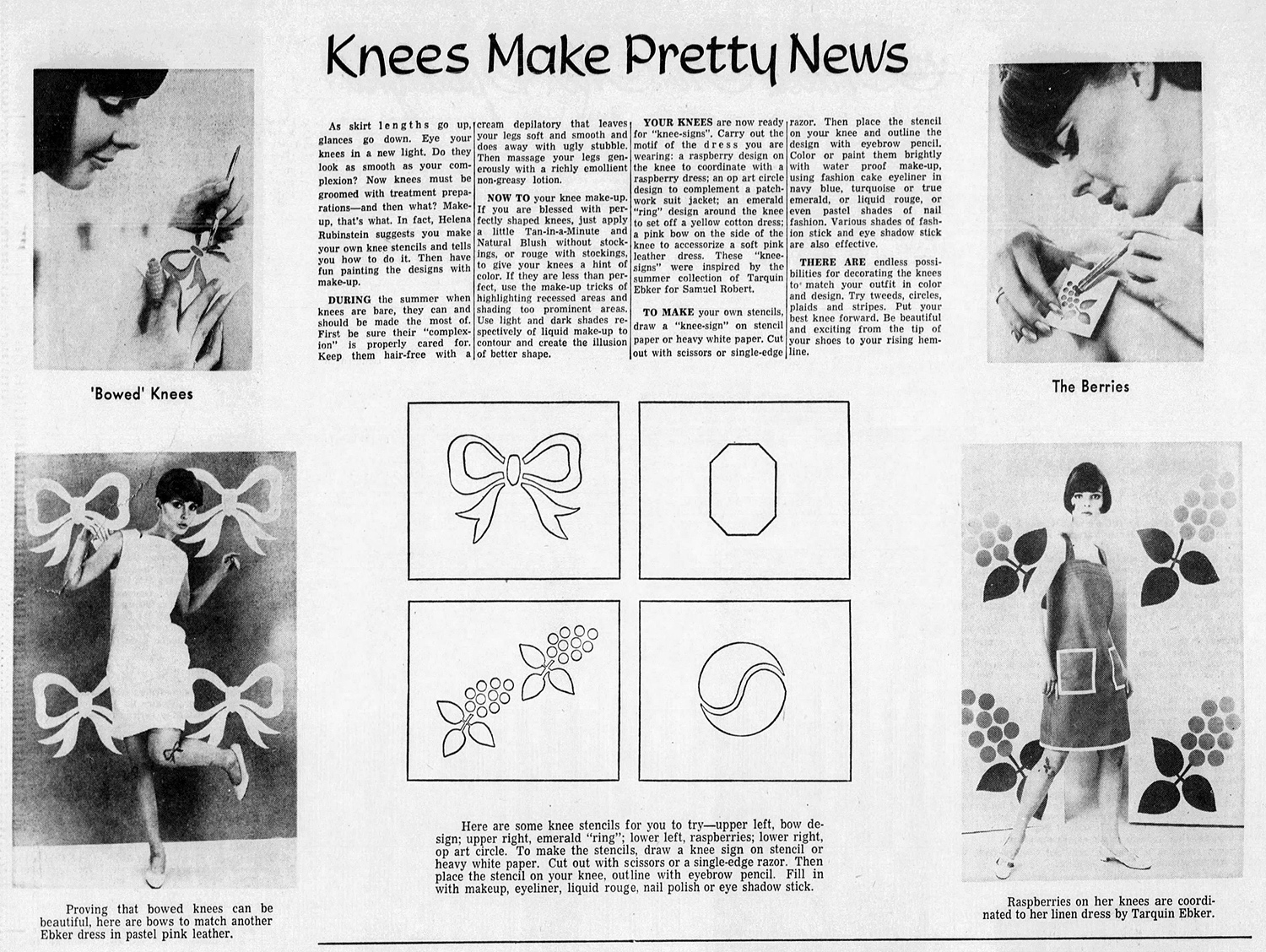
A third difference is that there was more acceptance for the fad in the 1960s. The average person in the 1920s generally disapproved of knee rouge or paint; not even fashion editors and other trend-setters could sway the public's opinion. But 40 years later, as long as you were young, you could get away with miniskirts and knee makeup. I guess one could argue that's progress as compared to the 1920s stance that no woman no matter her age should have painted knees, but is it really?
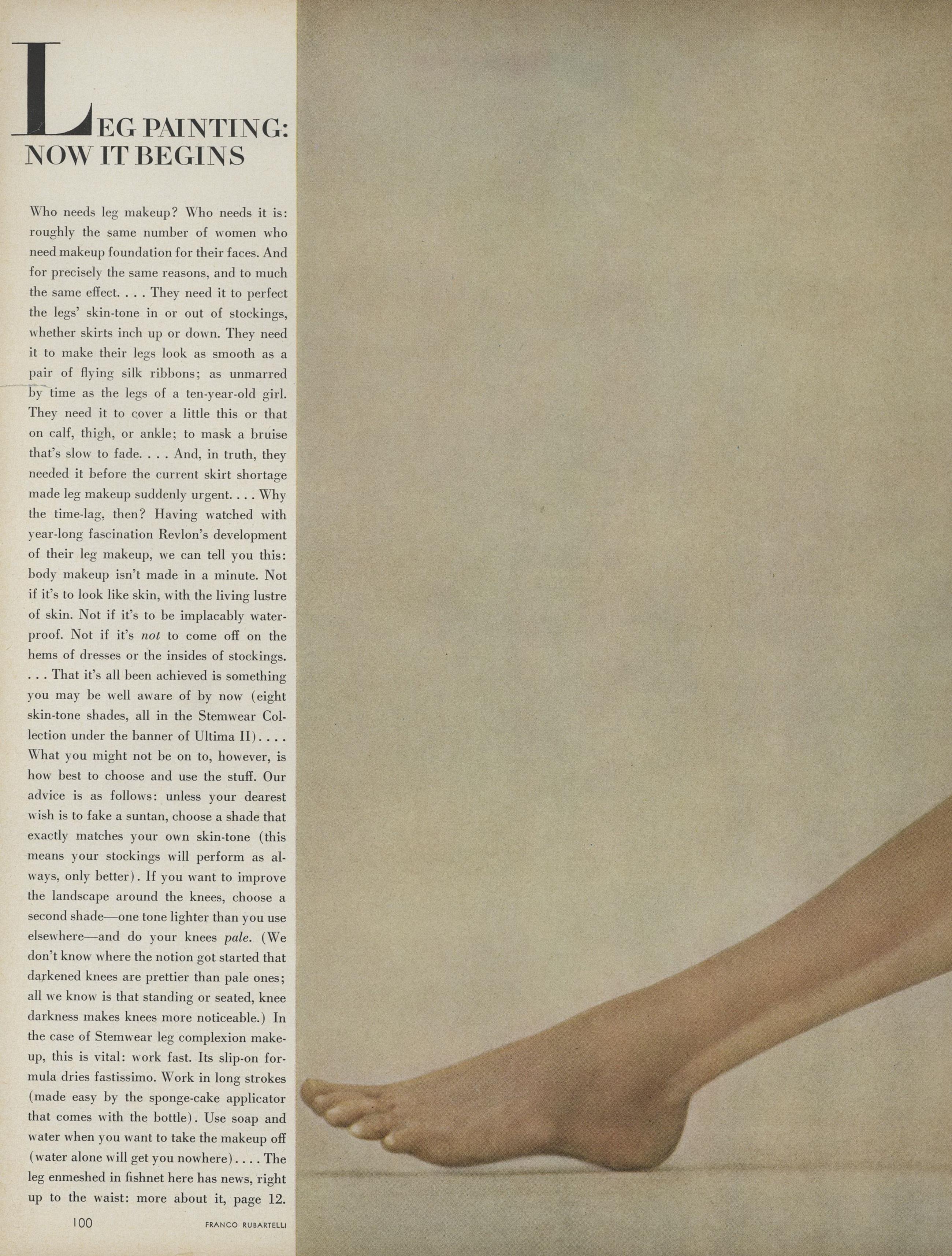
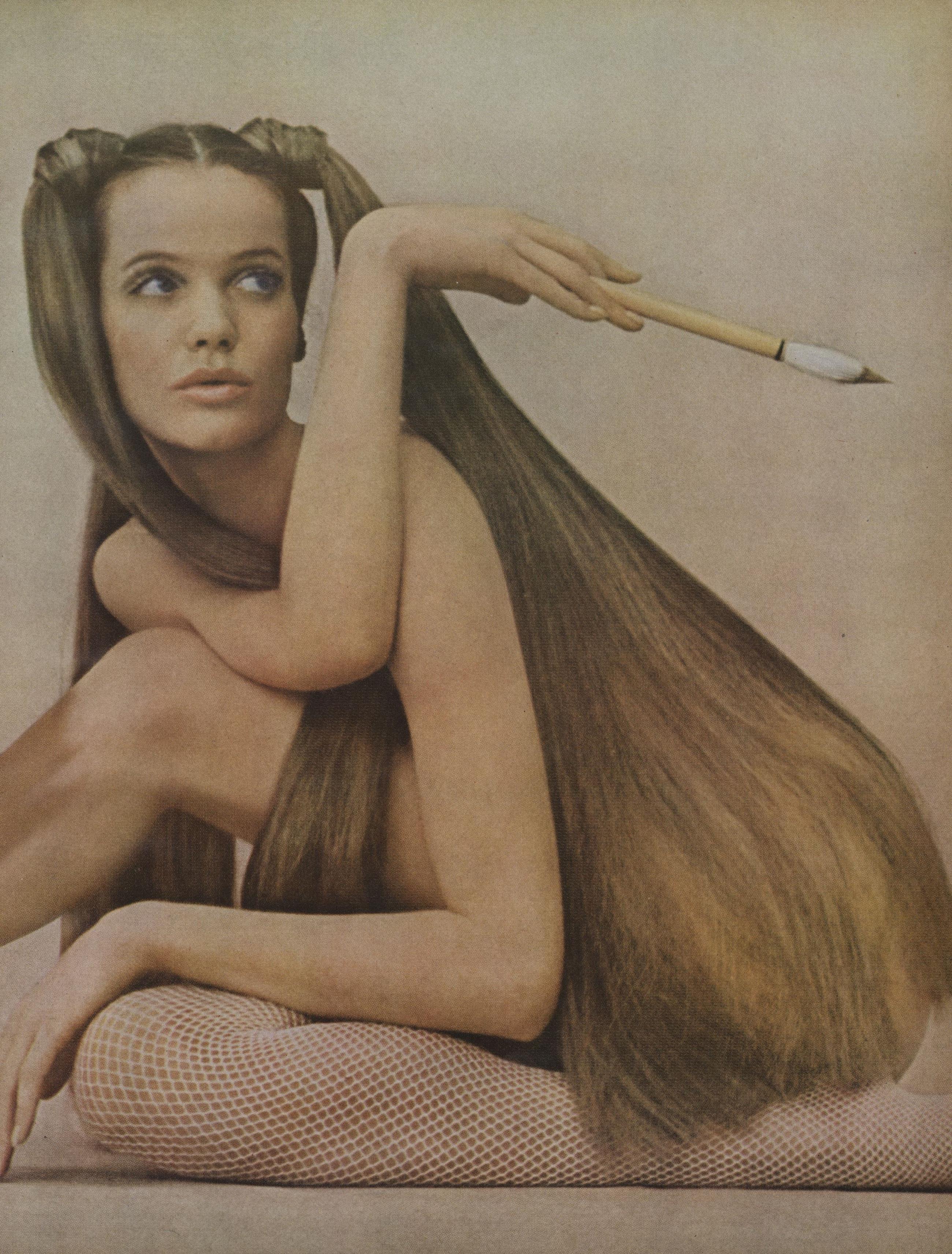
As the Vogue article above notes, "[Women] need [leg makeup] to make their legs look as smooth as a pair of flying silk ribbons; as unmarred by time as those of a 10-year old girl." Another fashion editor writing for the Salt Lake Tribune in May of 1966 states that knee makeup is "FUN – if one happens to be a teen or sub-teen. BAD – if one is a minute past teen. So knack your knees only according to how many years old they are. Age is one secret they can't keep." The obsession with youth might also be a function of pandering to young people in general as the baby boomer generation became front and center.
Finally, while I have my doubts that many women actually wore knee makeup art in the 1960s, the trend – or at least the idea of it – seemed slightly more widespread than in the '20s thanks to the marketing efforts of cosmetic companies and the makeup professionals employed by them, along with distribution of these ideas to a bigger audience via the ubiquity of fashion magazines. In the 1920s there was no such thing as an artistic director for a makeup brand, and companies hadn't yet grown into multi-million dollar businesses pumping out hundreds of products. Roughly forty years had passed since makeup became regularly worn; by that point there were many more products on the market than in the '20s, so companies had to go beyond the face and invent new types of makeup. It was only a matter of time before they shifted attention away from the face to the body in the hopes of generating more revenue, and short skirts gave them the perfect opportunity. Revlon, Fabergé, et al were not going to miss their chance to capitalize on and create a false need for leg makeup kits (see also: earlobe makeup). As one journalist noted in May 1966, "Cosmetics firms are about to spring a whole raft of brand new knee makeup products and ideas. The paints and brushes, powders and creams are ready and fetchingly packaged. The ad men are set to spread the word." As for the media, yes, Harper's and Vogue existed in the 1920s, but I'm guessing their circulation was much smaller than in the '60s, not to mention the slightly newer publications that been established by that point (Mademoiselle, Glamour, Seventeen, Co-Ed, etc.) People are more susceptible to buy certain products or try new trends the more coverage they receive, especially with a makeup artist leading the way and the availability of pre-made kits. Lastly, makeup technology was allegedly improved in terms of longevity. Nearly all of the advertising for leg makeup emphasizes its long-wearing nature, a sharp contrast to the messiness of the 1940s5 and prior years.
My thoughts: this was a pretty wild trend that I would love to see again. Given the sad state of my own baggy, misshapen knees I go back and forth as to whether I'd emphasize them with makeup designs, but it would be great to see on other people. It's also one of the few trends that could work on every skin tone. Of course, so-called "flesh tone" makeup for covering varicose veins or bruises probably was not available for Black or brown skin in the '60s and certainly not prior, but the bright primary colors contained in some of the kits would suit everyone. And while short skirts on women may not be as scandalous as they were decades ago, knee makeup remains an unexpected mode of cosmetic styling and body art.
What do you think? Would you ever wear knee makeup and if so, what design would you choose? You know I'd paint portraits of Museum staff members! Or maybe a mermaid on one and a shell on the other.
1Obviously there are entire books that could be written about body paint in various cultures throughout history, so I'm focusing specifically on knee painting during the 20th century in the U.S.
2While knee painting was mostly an offshoot of fashion, there was some influence from art movements in both eras. One 1925 article notes that knee painting was taking on "Cubist lines", and another in 1966 describes one young lady who painted on a Mondrian-inspired design. Knee makeup and body painting in the '60s more generally may have also been influenced by Yves Klein's Anthropométries of 1961.
3Richard Corson, Fashions in Makeup from Ancient to Modern Times, p. 569.
4Some articles indicated that Mary Bell painted Clarence Darrow on one knee and William Jennings Bryan on the other, but the article with an actual picture shows Clarence Darrow and a monkey…so who knows what's really going on there? The photo might not have been Ms. Bell at all. In any case, multiple accounts reveal that she did paint her knees and was spanked, so at least that those parts of the story seem to be true.
5The '40s saw a spike in leg makeup due to the war. Shortages in materials meant nylon stockings weren't readily available so women painted them on, seams and all. There were entire leg makeup kits and salons had the service readily available. And while the focus wasn't the knees but the entire leg, tips for contouring those pesky knee bulges still made it into various beauty advice columns. However, there was really no fun or creativity with the leg makeup of the '40s. By most accounts it was purely to mimic the average nylon stocking – no crazy colors or designs.
Once again I nearly forgot about the Museum's anniversary! While my idea for a makeup museum was generated prior to its online presence, I mark the anniversary as the day I wrote the very first blog post. Over 1,300 posts and 12 years later, on the one hand I'm surprised I've been doing this as long as I have; on the other, I'm a creature of habit and I don't know where I'd be without this space I created. As you know I've been feeling less than positive about the Museum lately. The events that have taken place since late 2019 have made it incredibly painful for me to continue. For a while I've been feeling as though I'm waiting for the final nail in the coffin, so to speak, in whatever shape it might take and whenever it might be – could be next week, next year, a decade from now, who knows? But in the meantime I do have some extra things that need a good home, so I figured I might as well do a giveaway since it might be the Museum's last anniversary.
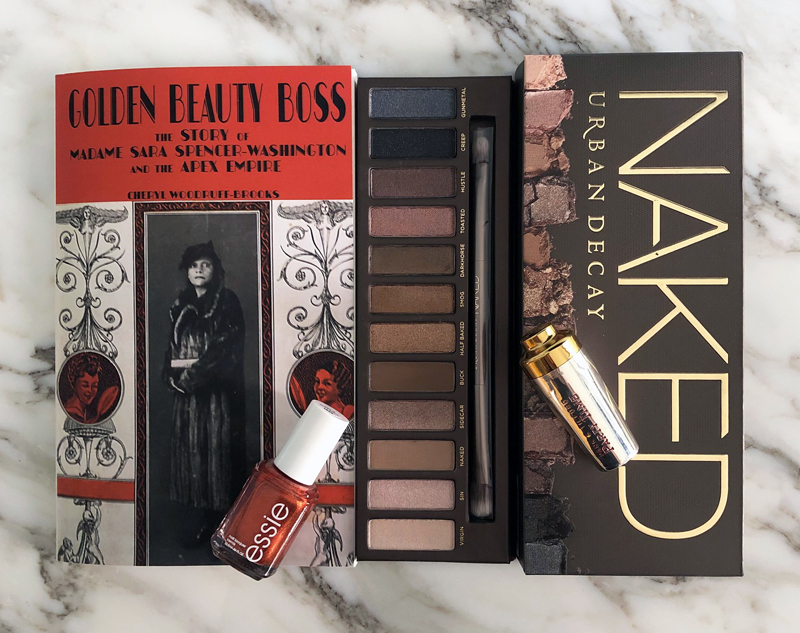
To thank those who have faithfully stuck by the original Makeup Museum, I'm offering a chance for one lucky person to win Urban Decay's very first Naked palette, a vintage Park and Tilford "Party Time" martini shaker shaped lipstick (so much fun, but it's for collectible purposes only!), and Essie's beautiful Say It Ain't Soho nail polish from last fall.
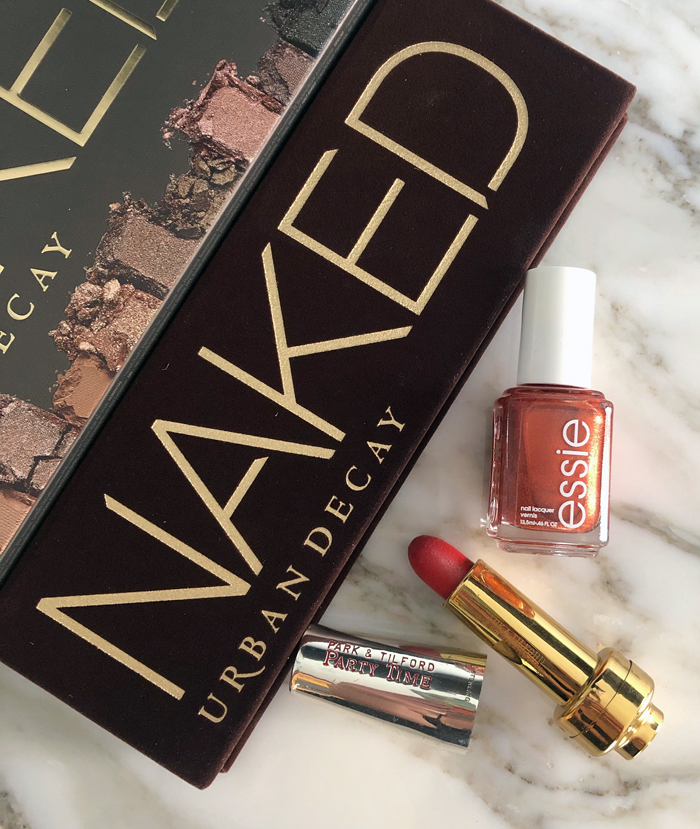
The winner will also receive an incredibly interesting and valuable biography of Sara Spencer Washington. You may have heard of Black beauty pioneers Madam C.J. Walker and Annie Turnbo Malone, but less well-known is Washington, who began the Apex Beauty empire in 1919. Thanks to historian and author Cheryl Woodruff-Brooks, Washington's story and that of Apex Beauty will not be forgotten. (You should also check out the documentary made by Washington's grandson – alas, that format does not lend itself as easily to giveaways.) I'm working on a history of Baltimore's beauty salons, and wouldn't you know there was an Apex salon in town? Stay tuned for more, hopefully, as I continue researching.
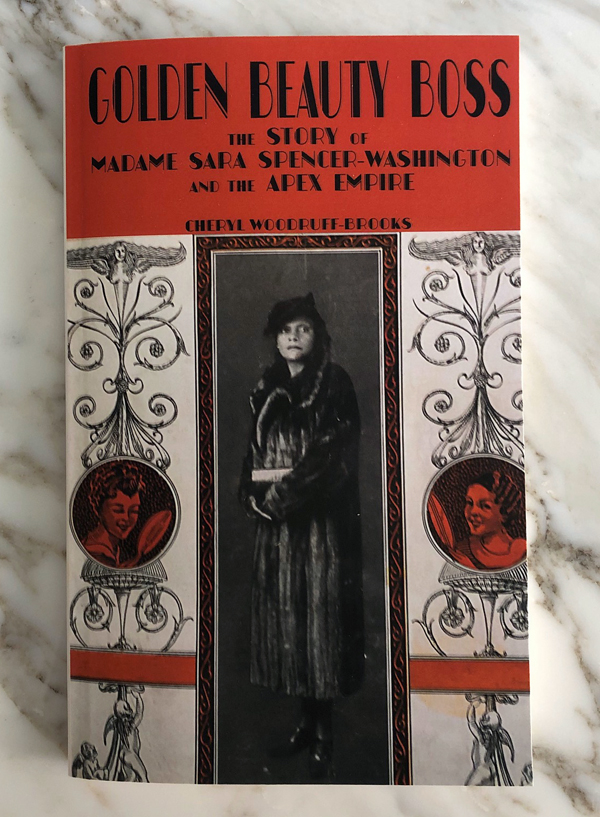
There are lots of ways to enter via the Rafflecopter widget below. Please note that for all of the Instagram entry options, you must be following me there for them to count. As always, it's open internationally.
a Rafflecopter giveaway
The winner will be announced here on Saturday, August 15. Good luck and thank you for entering!
Here's another short post since my schedule got completely screwed up…I've been working on some more in-depth things and once again I've completely underestimated how long they were going to take. But in the meantime, I wanted to share a great piece of makeup history that's right here in Baltimore! For now, anyway. I knew about Johns Hopkins University's Homewood Museum, but had no idea they also had an extensive archaeological museum. In 2010 they were the fortunate recipients of a long-term loan of the Myers Collection from Eton College. The collection consists of nearly 2,000 ancient Egyptian objects, including cosmetic artifacts. A special exhibition, Providing for the Afterlife: Ancient Egyptian Works from Eton College, highlighted some of these magnificent specimens.
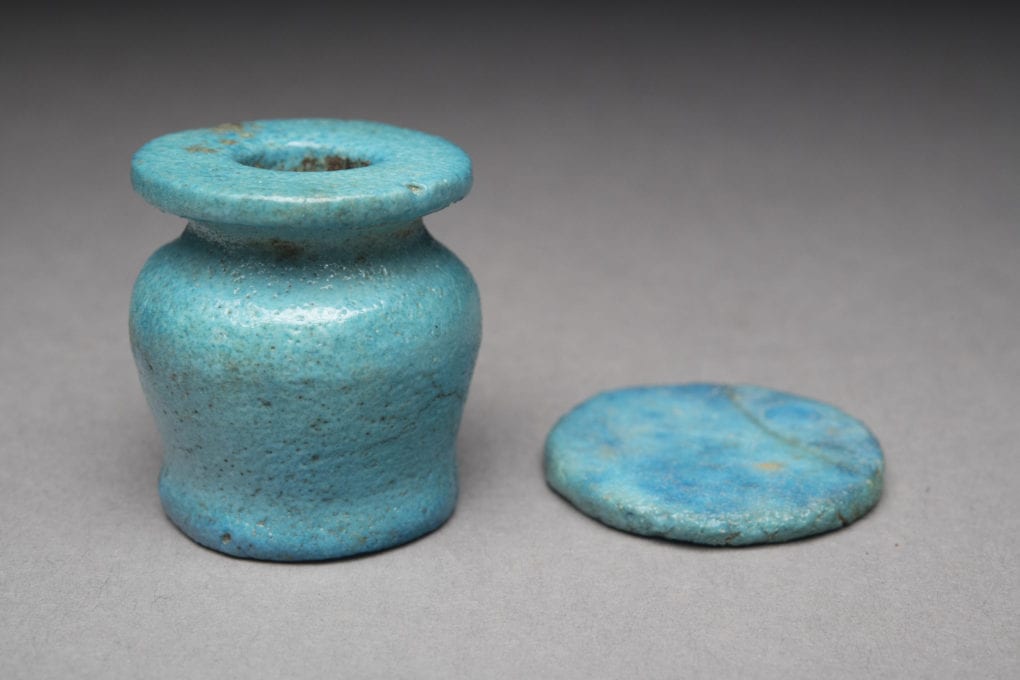
Faience kohl pot, New Kingdom, 18th Dynasty, ca. 1550-1295 BCE
While it's not clear whether these items were intended for this life or the next, it's entirely possible they were entombed with their owners to prepare them in the afterlife. The next time someone tells you makeup is frivolous, kindly direct them to this exhibition. Egyptians thought cosmetics were such a necessity that they went out of their way to ensure the deceased would still be able to access them, right alongside representations of food and water production. As Hopkins graduate Dr. Ashley Fiutko Arico points out, "Items associated with personal adornment, such as the cosmetic items displayed here, were particularly favored. Many of these examples were expertly crafted luxury goods of intrinsic beauty. Although it is unknown whether or not the specific examples on display here were buried with their owners, numerous examples like them have been found in funerary contexts, suggesting that this was likely the case. A selection of cosmetic vessels in a variety of shapes and materials evokes the importance attached to makeup, scented oils, and ointments."
This is a pretty nifty wood and ivory kohl tube with a swivel lid. As we know, kohl was used for both cosmetic and medicinal purposes, helping to shield one's eyes from insects and the sun's glare.

Wood and ivory kohl tube, New Kingdom, 18th Dynasty, ca. 1550-1295 BCE
How elegant is this palm column-shaped kohl tube?
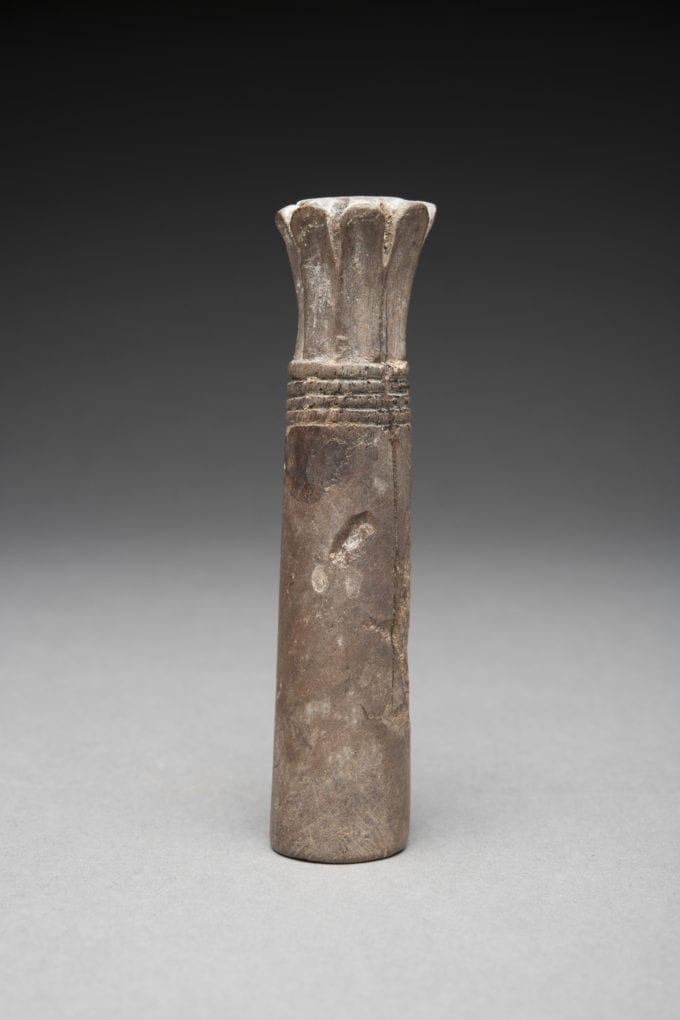
Wood kohl tube, New Kingdom, 18th Dynasty, ca. 1550-1295 BCE
Not quite the most ergonomic design for application, but I bet this metal stick did scrape every last bit out of the kohl tube.
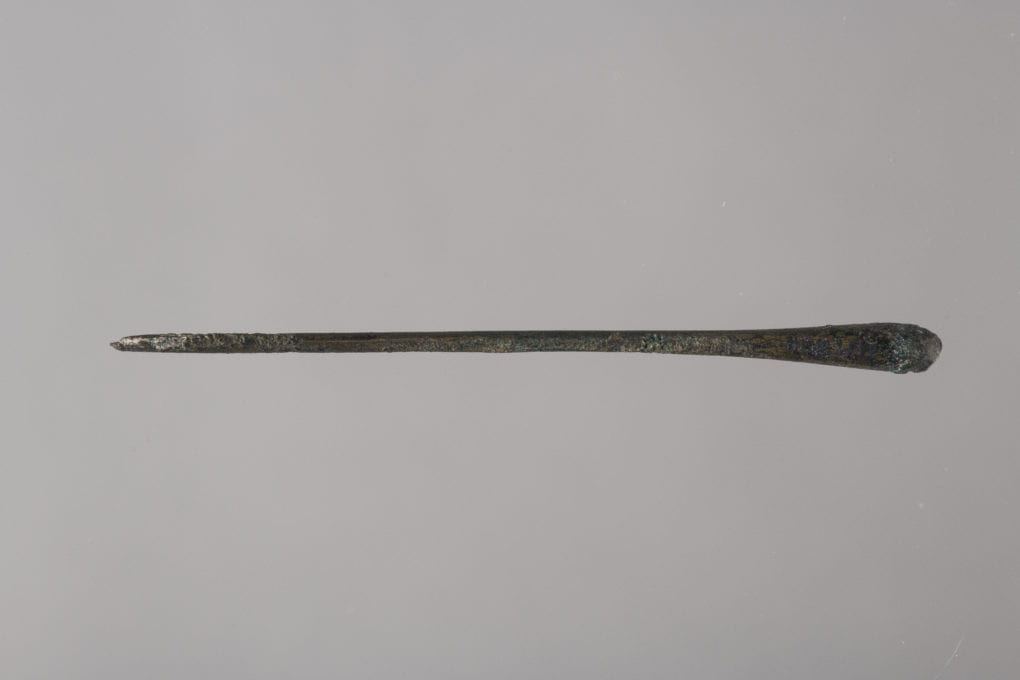
Metal kohl stick, New Kingdom, ca. 1550-1069 BCE
I wonder what this cosmetics box held! The really great thing about the exhibition is that x-rays and other technical studies were performed by the students for each object. So while we can't say for sure what this box contained, we know both the interior and exterior were painted, plus the students got to have some serious hands-on technical experience.
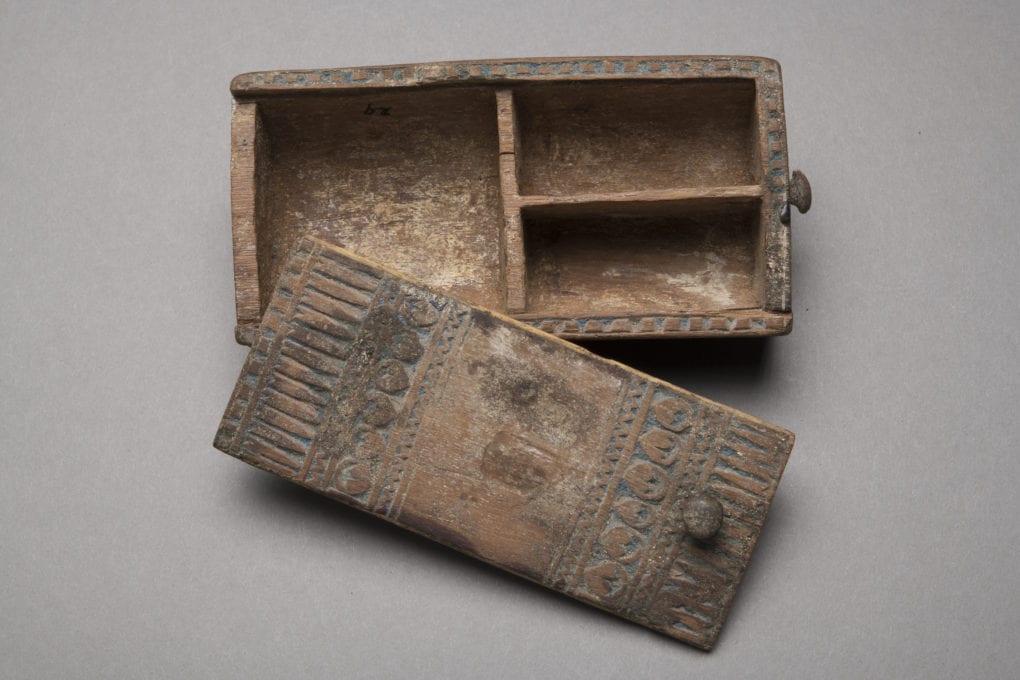
Wood cosmetics box, New Kingdom, Late 18th-19th Dynasty, ca. 1336-1186 BCE
Based on "visible infrared luminescence imaging", the students were able to determine that the outer part of the box was painted with Egyptian blue, the first synthetic pigment. All of the white areas in the photo below were painted with this vibrant blue, while it is speculated that the interior was painted with yellow. I can only imagine how amazing this box must have looked in its original state.
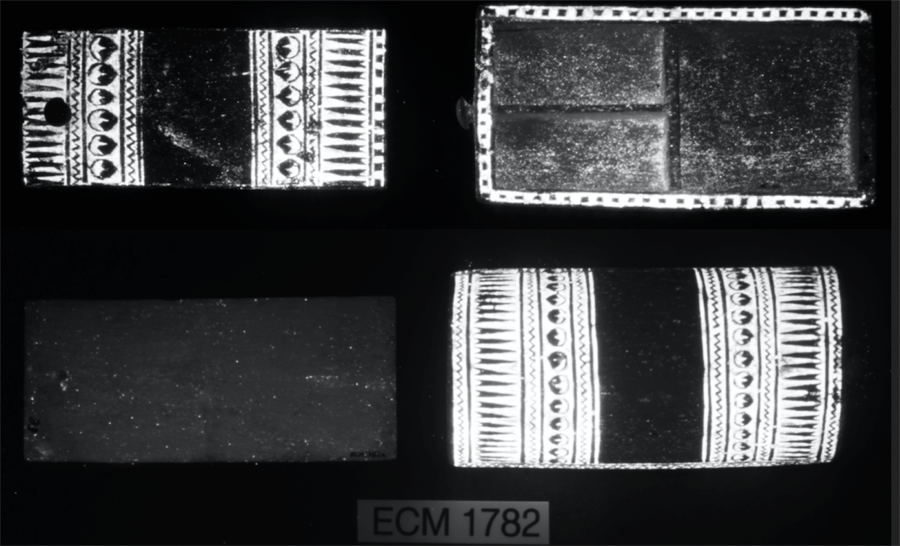
Wood cosmetics box, New Kingdom, Late 18th-19th Dynasty, ca. 1336-1186 BCE
(all images from archaeologicalmuseum.jhu.edu)
While these are wonderful objects, it's unclear if the Eton collection was ethically formed. All I could find online was that Major William Joseph Myers "gathered" the items while stationed in Egypt and bequeathed them to Eton upon his untimely death in 1899. Is "gathering" another word for stealing or looting, or otherwise exploiting Egyptians in some way? Everything I've seen presents Myers as a collector who was interested in Egyptian art, so it's very likely he simply purchased the objects from local dealers – I doubt any sort of blatant tomb-raiding was taking place. But who knows for sure? In trying to find more information about the collection and whether these objects ended up in Myers' possession in an ethical manner*, I was also reminded of the vast Egyptian collection at Manchester, which makes me second guess purchasing the book detailing all the Egyptian palettes from the University of Manchester Museum's collection. I want to learn more about ancient Egyptian cosmetics, or if hell freezes over be in a financial position to actually purchase an artifact, but I'm questioning how it can be done responsibly when the provenance of most of these objects is unclear or worse, definitely stolen or otherwise obtained at the expense of the original owner or native country. This of course opens a huge can of worms about where any and all museum objects come from, which is a conversation for another time (although I have mentioned it briefly before.)
Thorny moral questions aside, these objects are fantastic and should it ever be safe to visit a museum again – hopefully sometime within the next 5 years, as the loan from Eton expires in 2025 – I may have to swing by Hopkins and see if there are any other cosmetic items on display. What's your favorite item here? Would you want to be buried with some makeup? I'm getting cremated so it's a non-issue for me, but I might entertain the notion of having a few pieces incinerated with my carcass. Ha!
*The only article I found related to the ethics of the Myers collection/museum indicated that 454 objects were returned to Egypt in 2009, but these were not objects collected by Myers himself; they were the gift of another donor in 2006.
I am so pleased to be posting a wonderful, albeit bittersweet story about the legendary Kevyn Aucoin today, as it commemorates the 21st anniversary of the date he filed for the trademark of his beauty line. A few months ago I received a very kind email from a makeup artist who actually had the opportunity to work with Kevyn and had an integral role in the launch of his brand. Amelia Durazzo-Cintron, an Emmy-nominated artist who currently works for PBS, generously agreed to allow me to share the impact Kevyn made on her career as well as her experience with helping to get his makeup line off the ground shortly before his untimely death. She also permitted me to use some her photos with the man himself and an incredibly special and Museum-worthy brush set that he bestowed upon her. Here is Amelia's story in her own words.
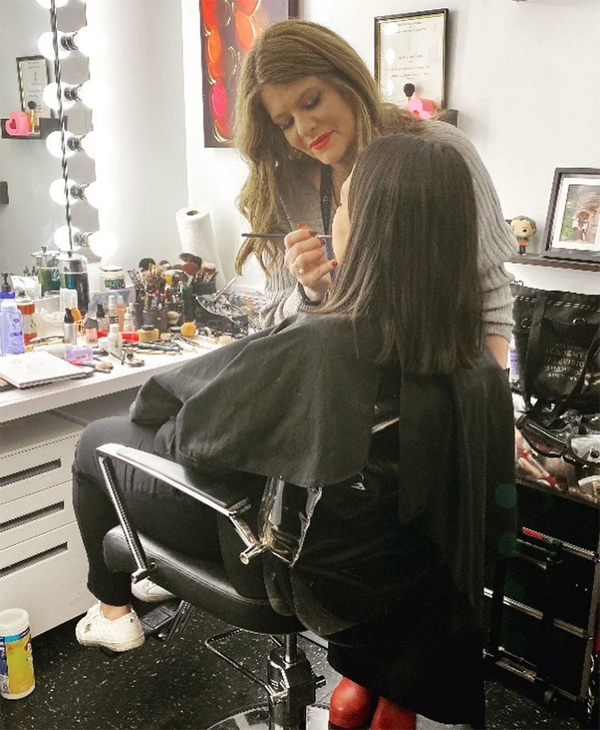
Amelia Durazzo-Cintron at work, Februrary 2020
(image from @makeupbyamelia.c)
"I was obsessed with makeup for as long as I can remember. My mother was born in Italy. She went to school for fashion design. I was always in awe of the way she put herself together. I don’t even think she owns a pair of jeans. She’s always impeccably dressed. Her hair and makeup is always on point. When I was a little girl, I used to watch her put on this cream eye shadow that came in a tube like lipstick. Once, when she was almost down to the end, she gave it to me to use for when I played dress up…and the rest is history. I used to study her Italian Vogue. I think that is where I first may have seen Kevyn’s work. He had a 'style' or look that was hard to imitate but immediately recognizable. A lot of the makeup back then was pretty garish, blush that looked like stripes, colors that didn’t seem to go well together, nothing was blended. Then there was Kevyn. Everyone he touched looked absolutely radiant. Although he was amazing at editorial looks his ability to bring out the natural beauty in women was unsurpassed. It was around that time that he collaborated on a collection for Ultima 2 called the Nakeds. He literally changed the industry with that launch. I think I bought every palette. Then came the Making Faces book. There is no better makeup book than that! He appeared as a guest on the Oprah Winfrey show to promote the book. They showed these amazing transformations he had done on several women.
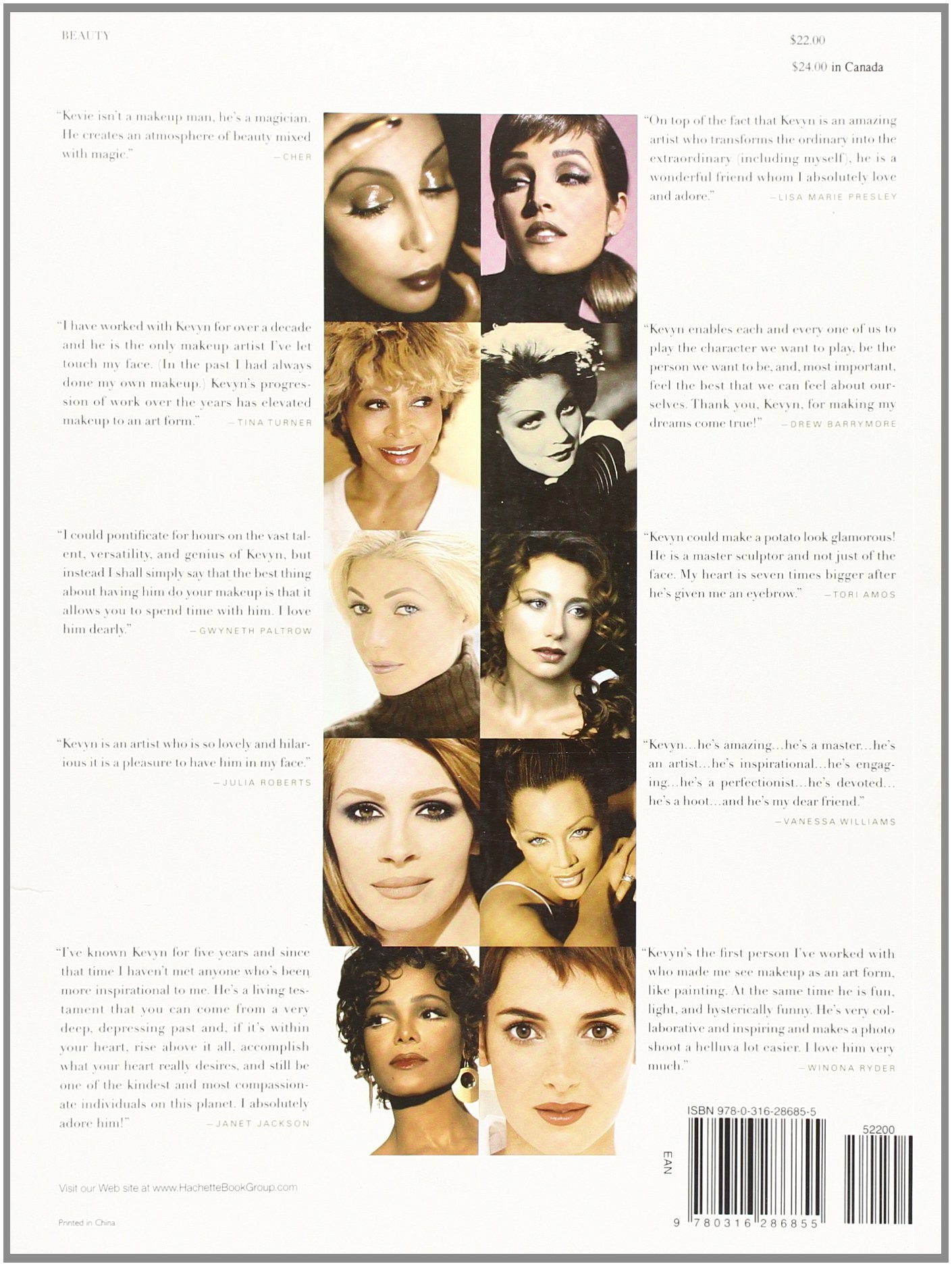
"I became obsessed. I had to meet this guy. At that time, I had just started my career in the medical field. I wasn’t particularly happy but it was decent pay and good hours. Kevyn Aucoin changed my entire career path. I was always interested in makeup but I didn’t quite know how I would parlay that into a career. I decided to quit my job to work at Nordstrom as a part time beauty associate. I figured it was a good of a place as any to start a career in makeup artistry. My ex husband was not amused. But I knew I had to go with my gut. A few months later, Kevyn launched his second book Face Forward. The timeline is a little fuzzy but I believe it was also at this time that he started a soft launch of Kevyn Aucoin Beauty at none other than the beauty mecca at the time, Henri Bendel’s. The counter was placed front and center in the atrium, which was their prime real estate. His product line initially consisted of his mascara, lash curler and brush set.
"They also launched a new website. It had this amazing beauty chat room where fans, aspiring makeup artists, etc. could 'meet up' and discuss product faves, dupes, and anything Kevyn related. Every once in a while, Kevyn himself would pop in to interact with his fans. We would go nuts! We were actually chatting with Kevyn himself! I also met up with other fans from the beauty community (some of which I am still friends with). One day, Kevyn posted about a meet and greet at Bendel’s to coincide with the launch of his product line. [My friend] and I called one another and immediately made arrangements to meet up. As I recall there may have been a day’s notice. I remember having to change my schedule at work so that I could attend. There was no way I missing it! If the event was due to start at, let’s say 5PM, we arrived at 3. They hadn’t even started setting up yet. We were number one and two in line. You’ve probably heard of Troy Surratt of Surratt beauty. Well, Troy was Kevyn’s assistant at the time. He smiled at us as we watched him merchandise the products very carefully placed in a case at the front of the line. Everyone would have to pass through and have a look on their way to meet Kevyn. We fell into conversation (seeing as we were two hours early and staring at him) and he couldn’t have been kinder.
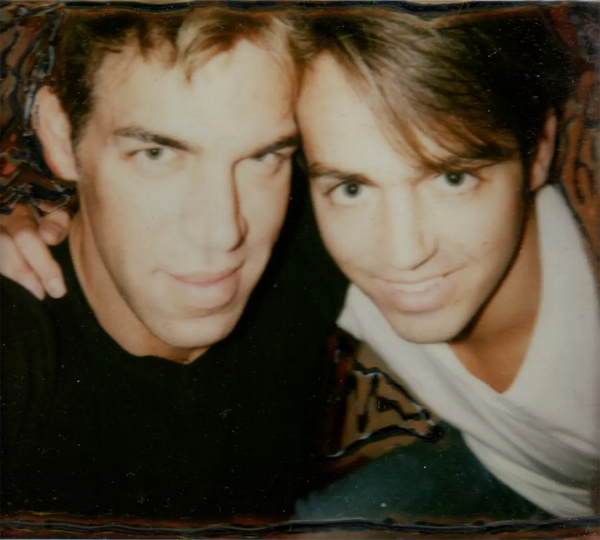
Kevyn Aucoin and Troy Surratt
(image from racked.com)
"Meanwhile as we were waiting for Kevyn to arrive, some celebs were being escorted into a separate entrance for what I assume to be a launch party. Mary Tyler Moore walked right past me and said hello. Her smile lit up the entire room. Then Gwyneth Paltrow…she literally had just won the Oscar for Shakespeare in Love. She brushed past me on her way into a roped off area, she came in looking pissed off and like she had smelled something bad. Her demeanor completely changed when she caught a glimpse of Kevyn and I saw them hug. I guess he had that effect on everyone.
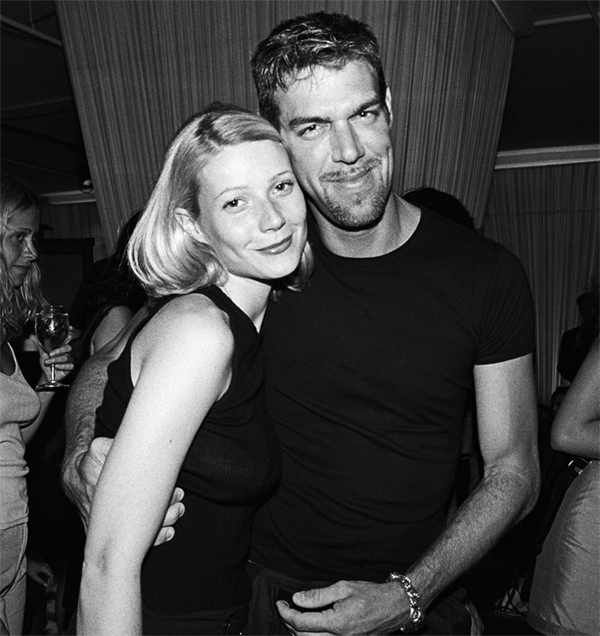
Gwyneth Paltrow and Kevyn Aucoin
(image from allure.com)
"When Kevyn arrived he came right to the front of the line and said hello. He thanked us for coming and told us he had heard we waited for him for two hours. He seemed shocked by this. I would have waited two days! I’m telling you that the guy had an indescribable energy. I’ve met many celebs throughout my career but no one impressed me as much as Kevyn. He was warm and genuine and was so incredibly humble. I had brought a copy of his book for him to sign. While I had his attention, I told him it was my dream to work for him someday. I gave him a brief synopsis of my career path and how he had inspired me to become a makeup artist. Tears welled up in his eyes. He was truly touched. He told me that his plan was for him to launch at other department stores. I believe he may have mentioned Bergdorf Goodman or Barney's as possible contenders. He would need motivated, knowledgeable and talented artists to work for his line. At that time, I was working for Prescriptives, a line owned by Estée Lauder. He said he loved Prescriptives artists because they were well trained in color theory. At the time, they were one of the most popular makeup brands. They were [one of] the first cosmetics line to offer custom blending for foundation and always offered exact foundation shade matching. I was elated hearing that Kevyn gave the brand his seal of approval! He then grabbed a piece of paper and handed me his personal email and told me to keep in touch. I nearly passed out. I was so ecstatic!! We began an email friendship that lasted until the week before he died. I wasn’t going to let this opportunity slip me by. I offered to help out in any way I could. At that time, Kevyn’s company consisted of just a handful of employees. Kevyn had sunk much of his life savings into the launch of his brand. A lot was riding on the success of the line. They couldn’t afford to hire additional staff so everyone he had on board at the time was a either a close friend or family member. Eric Sakas was the CEO and also Kevyn’s ex-boyfriend and best friend of many years. It was also at this time that the beauty board on his website took off. Just as YouTube is to the beauty influencer, the beauty board was for Kevyn Aucoin Beauty. It was an important marketing tool which they used to update fans about product launches and share tips and tricks from Kevyn himself, and other fun stuff like personal photos (as he was also an amazing photographer) and his must haves for his kit, etc. The beauty board took on a life of its own.

(image from archive.org)
"His office manager Sarah was having a tough time dealing with the product launch, behind the scenes stuff, etc. and having to moderate the beauty boards wasn't high on her list of priorities. We had gotten to know one another as Kevyn had her send me some mascaras to try. I also let her know of my interest in working for the company and sent her my resume for when they were ready to begin the hiring process. I wanted to be one of the first people to work as a makeup artist for Kevyn Aucoin Beauty! She was so kind. She promised to keep me in the loop…and she did, sending me freebies or as we say in the industry 'gratis' to try and sometimes giving me a sneak peek of things they were working on. She wasn’t a makeup artist so she appreciated the feedback. Back to the boards…they went from having a few hundred members to tens of thousands. Every once in a while, you would get your typical internet trolls trying to start shit and taunting some of the 'regulars'…trying to get them to engage. This one particular day one of them posted the most awful statement about Kevyn being a junkie and that we were 'worshipping a f*ggot drug addict'. I was horrified! I immediately called Sarah in a panic. She took the post down and thanked me profusely for helping them avert a potentially disastrous situation. Unbeknownst to me at the time, (it was only years later that I found out the truth) Kevyn had people in the industry trying to ruin his reputation. You may have watched his documentary. If you did then you’d know that he was dealing with an addiction issue related to the pain meds he took for his condition called acromegaly. As much as I love this industry, people can be very jealous and vicious. I suspect that there were rumblings at the time about Kevyn and his issues. Someone decided to go public, most likely to try to deter any potential investors. This only added to his stress and to that of his friends and family members.
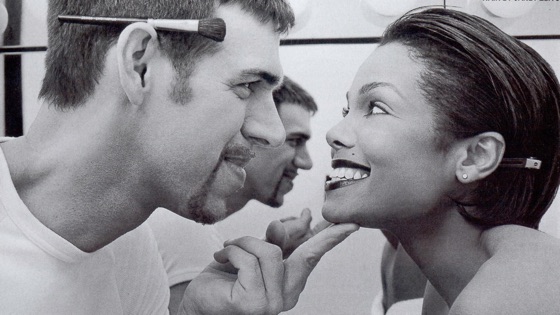
Kevyn Aucoin and Janet Jackson
(image from itunes.apple.com)
"That’s when Sarah asked me if I would be interested in becoming an administrator for the website. They would give me the ability to initiate posts to get engagement and to delete and or block any offensive posts or individuals. She explained that they couldn’t afford to pay me, but that could pay me in gratis. I jumped at the chance!!!!! A few days later, I received a package in the mail, a huge box filled with mascara’s, lip glosses and lipsticks that had just launched, both of his books…and the holy grail.. my prized possession…A full set of Kevyn’s brushes complete with a custom mahogany box with an insert that fit all of the brushes inside. They only made a limited number. If memory serves me correctly, the set sold for $1000!
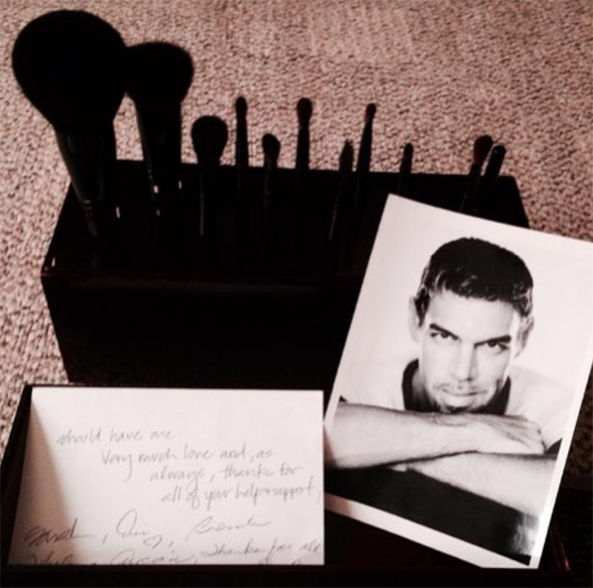
(image from @makeupbyamelia.c)
"I cried…Kevyn was so appreciative for the help I was providing to him and Sarah. He emailed me and said that he would continue to supply me with anything I needed. All I had to do was ask. I remember thinking how lucky I was. Friends of mine in the industry were floored. They were so excited for me. A makeup artist friend of mine said 'you realize that your life is going to change'…and it did. But not the way I had hoped. Not long after I began my work with Kevyn (possibly less than two months later), I received a message from Sarah on my answering machine. Her tone seemed somber…not like her usual bubbly self. I immediately thought that perhaps they had another troll situation. I called her back as soon as I got the message. It was far worse than I'd imagined. Kevyn had passed away that morning. She didn’t want me to hear it on the news or read about it online as she was sure the news would eventually and inevitably end up on the message boards. I couldn’t even breathe from sobbing. I felt like my dreams were completely shattered. I was so despondent that I didn’t go to work for several days…and as predicted the beauty board was buzzing with incorrect information and downright cruel rumors from people who had no idea what they were talking about. Kevyn’s sister had to shut it down by telling people to please respect the privacy of the Aucoin family. I was deleting posts left and right. It got so out of hand that a particular troll threatened several of the members at which time I had to step in and block him. He proceeded to send me emails threatening to 'cut my throat'. It all seemed like a bad dream.

Keith Aucoin speaking at his brother Kevyn's memorial service, May 15, 2002
(image from theadvertiser.com)
"Then came the aftermath.. I don’t know a lot of what was going on but I do know that the investors they did have on board to help to expand the product line, head for the hills after Kevyn’s death. His entire estate was tied up in the line. Eric Sakas who I mentioned earlier was Kevyn’s former partner and closest friend. He made it his mission to ensure that Kevyn’s line would launch and align with Kevyn’s original vision. They were slated to launch Kevyn’s signature product which remains a cult classic to this day. The Sensual Skin Enhancer. It was already being sold at Bendels and now, they needed to put it up on the website. Eric and Sarah being the business minds of the company, neither of them knew how to properly describe the extensive shade range so that online customers would be able to determine which shade would match their skin tone. I was asked to help out. I sat there with Eric swatching prototypes (with Kevyn’s own handwriting on the boxes) coming up with proper descriptions of the shades ie warm, med, neutral, cool, etc. It took several hours, They were dealing with so much. I could see the stress and the sadness in their eyes. I just wanted to do whatever I could to help. After having been involved for two years after Kevyn’s death, the line was ultimately sold. Sarah had left the previous year. The message board was shut down due to lack of engagement (it was Kevyn’s presence there that encouraged people to hop on and interact). Things were moving fast in e-commerce and they had to update the site to give it a more streamlined look…they no longer had the need for a website administrator. Shortly after Kevyn’s death, his family decided to have a private memorial service. I was so touched when I had received in the mail a photograph of Kevyn that was handed out to the family and closest friends who attended the memorial service. His mother and father both took the time to write me a note thanking me for the work I did for his website, I was moved to tears.

"I didn’t give up pursuing my dream to become a makeup artist. I was hired as a trainer for the NYC Sephora market for Christian Dior. Kevyn was my motivation every step of the way. But the retail world was rapidly changing. The 2008 crash hit hard and my position with Dior, my dream job, was one of the first eliminated. I was back to square one, working freelance gigs on and off for several years, uninspired and unmotivated. Then a dear friend of mine called me one day asking if I would be interested in freelancing for a local TV station. He was the executive producer for a PBS News show. We had met at Nordstrom several years earlier when I was managing the Stila counter and he was going to school and working in loss prevention. I was intrigued but nervous, as I knew nothing about TV makeup. I had done makeup at Bryant Park, stage makeup for performances, magazine shoots, but never TV. I was scared shitless that first day I stepped into the studio. To add to my anxiety, the anchor of the news program I’d be working for was a well respected journalist with a career that spanned 40 years. She had been a network TV anchor, she was a guest (as herself) on the Murphy Brown show with Candace Bergen, she had been on the cover of People magazine..she was kind of a big deal. I did her makeup for the first time..my hands were shaking. All along I thought of Kevyn. As silly as it sounds I felt his presence that day. It calmed my nerves and I just did what I would normally do with anyone else. She loved it. I was so elated, relieved, and grateful for the opportunity. What started out as me covering for the studio’s full time artist, ended up with me landing a staff gig. Five years later…I'm still loving my job. This current situation has been especially hard on me. [But Kevyn] inspires me to continue honing my skills as an artist. I'm so proud to say that I was nominated for an Emmy in the NY market last year, I didn't win but seriously…I could not have imagined it as a possibility! I owe everything to Kevyn."
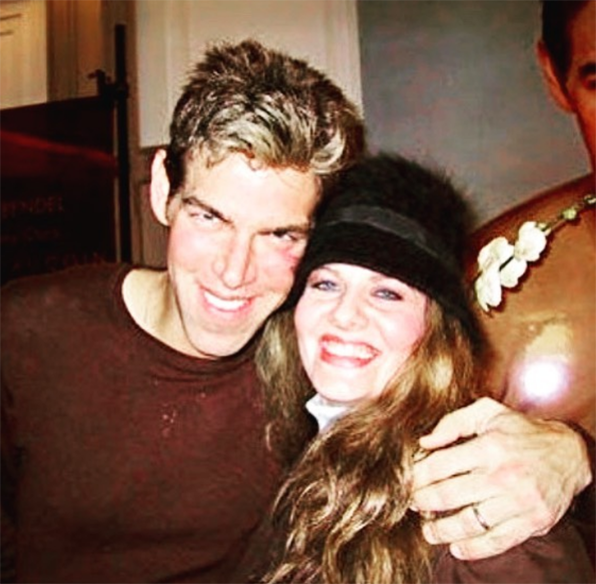
Kevyn and Amelia
(image from @makeupbyamelia.c)
Thank you, Amelia, for taking the time to tell this amazing history! I am so honored that you chose the Makeup Museum to share it publicly. I also must thank Amelia for her generous (unrelated) donation to the Museum, which I'll be covering later – so many people want to help build the Museum's collection so I'm planning a rather large post on recent donations. Stay tuned…and in the meantime, if you want more on Kevyn, there are two documentaries available and a new book from Alcone showcasing his illustrations and face charts.


 (images from hermes and therealreal.com)
(images from hermes and therealreal.com) (image from buro247.me)
(image from buro247.me)






































































































































